Economics Essay Topics: 162 Practical Ideas & Useful Tips

Essay writing is an inherent part of the economics studying process. Nevertheless, it is quite a challenging task. Are you a high school or college student who is struggling with an economic essay topic choice? Or maybe you are unsure about your writing skills?
We know how to help you .
The following article will guide you in choosing the best topic for your essay on economics. Here, you can find a variety of ideas for high school or college. The economic essay topics are divided into several categories that will help you with your research. And a pleasant bonus from our team! We have created a great guide on how to write an economics essay.
So, don’t miss your chance to write an outstanding economic paper! Check out our essay ideas, read our tips carefully, and be ready to receive your grade A!
- ⭐ Best Economic Topics
- 🤝 Socio-Economic
- 🗺️ International Economics
- 🛠️ Labor Economics
- 🌆 Urban Economics
- ⚽ Sports Economics
- 💉 Health Economics
- 💼 Business Economics
- 🏤 Globalization
- 🧮 Economic History
- 💫 How to Write?

⭐ 15 Best Economic Essay Topics
- 2008 Economic Crisis.
- Socio-economic policy.
- Economic systems – Singapore.
- Racial pay gap.
- Economic globalization.
- History of online trading.
- Child labor policies.
- The Economic Naturalist.
- Foundations of economic theory.
- Impact of unemployment.
- Universal Basic Income.
- The role of consumerism.
- Healthcare economics – Canada’s Medicare.
- Reasons for recession.
- Cryptocurrency & environmental issues.
✨ Excellent Economic Essay Topics
Has economics always been a subject of meticulous research? The question is quite controversial, right? There is no specific time when economics started its rapid progress. Generally, economics remains the topic of interest since the establishment of capitalism in the Western world.
Nowadays, the economy is the main engine that moves our world forward. The way we do business determines the geopolitical situation in the world. Moreover, it influences many other parts of our lives.
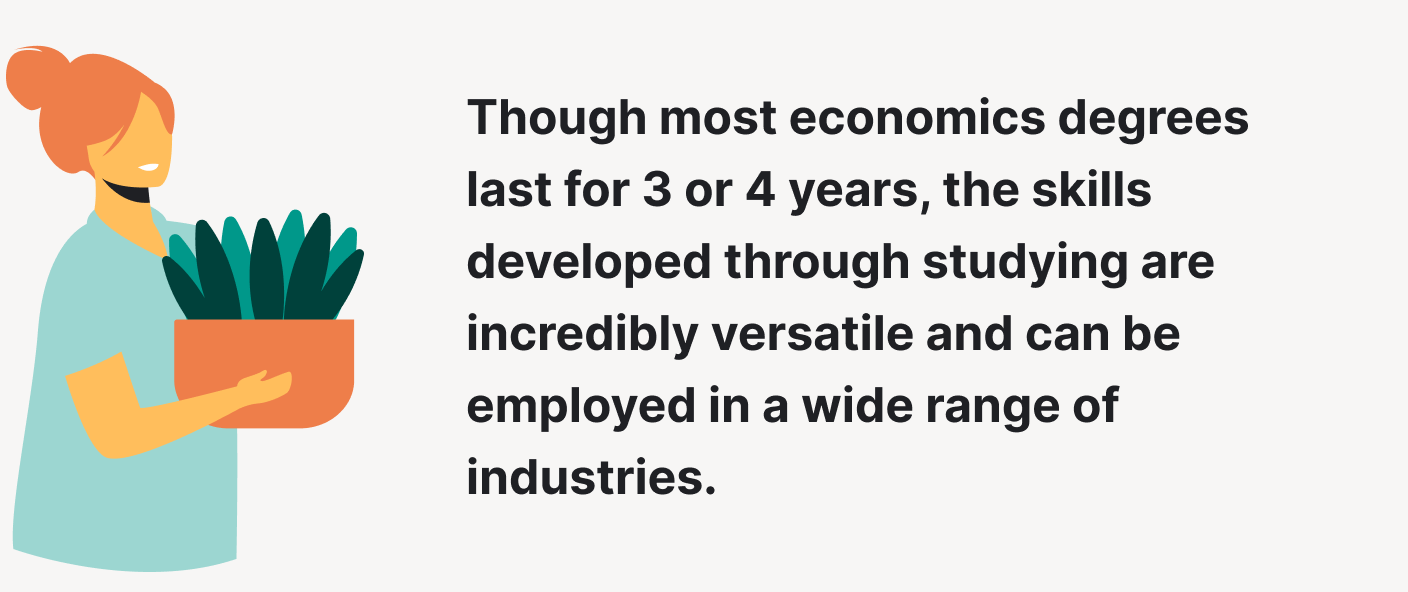
Economics studying is of utmost importance nowadays. It helps to gain a better understanding of processes that put everything in motion.
Economics is quite broad, so it has a great variety of subfields. And this is a fantastic opportunity for us to generate as many essay ideas as possible. Here, you will find great economic topics for your paper. As mentioned before, we have divided them into several sections to ease your selection process. There’s a wide selection of free college essays samples on economics in our database, too. So be sure to check that out.
🤝 Socio-Economic Essay Topics
- The economic impact of racial segregation in America in the 1950s.
- Designing a just socio-economic system.
- Socio-economic status of Hong Kong in modern-day China. Explain how the city of Hong Kong gained a special status in China. Why did it emerge as one of the most important cities in its economy? Comment on the significance of Hong Kong in the international economic arena.
- Economic growth in the United States in the post-World War 2 period.
- Mobile banking in Saudi Arabia: towards understanding the factors that affect the sector.
- The importance of Dior’s bar suit to the women’s fashion industry.
- Economic problems in the 1980’s Soviet Union. Talk about the significant problems with the economy the USSR had in the 1980s. What role did they play in its collapse?
- What socio-economic problems did segregation in South Africa cause?
- History of economic development in the UAE. Discuss the economic miracle in the UAE and Dubai. Explain how the government could turn the city of Dubai into one of the most famous tourist destinations. What strategies were applied?
- Gender inequality and socio-economic development .
- The problem of poverty in Venezuela.
- How the socio-economic and political position of women changed between 1880 and 1940.
- The economic impact of COVID-19 on global trade.

- How do the three main economic groups interact with each other? There are three critical economic groups: – Consumers – Producers – Government Analyze the interaction of these groups with each other.
- Extended essay: how the study of economic data helped our society to advance?
- Western industrialization socio-economic impacts.
- Inequality at the top: not all billionaires have the same powers. Analyze billionaires’ net worth, liquidity, political power, and wealth security. Explain why they have unequal social status. What factors determine the influence of billionaires?
- An analysis of systems that help us measure agricultural development in a country.
- Is social media a useful tool for brand promotion?
- The phenomenon of dualism in economic development.
🗺️ International Economics Essay Topics
- Globalization and its impact on international economic relations. Define the term globalization. What role does globalization play in international economic relations? Provide specific examples of globalization’s impact on the global political economy.
- The lack of justice for the cheap international labor market. Discuss the issue of cheap labor in various countries. Why do some workers often lack fundamental human rights while others abuse moral norms? Analyze the causes and effects of inequality in the workplace.
- Japan macroeconomics: problems and possible solutions.
- The issue of mercantilism in the history of Great Britain. Analyze the rise and development of mercantilism in the history of Great Britain. To solidify your ideas, provide persuasive arguments, and appropriate examples of mercantilism.
- Why does the problem of environmental protection remain unresolved among global economies?
- Nissan Motor company’s international business.
- International environmental concerns in economics: the case of China .
- The issue of international criminal justice in industry. Explain why international businesses often avoid criminal justice after wrongdoings. Select one case of unethical behavior of a company’s CEO or regular employee. Briefly introduce the problem. What were the causes and effects? How was the issue resolved? Express your own opinion regarding the lack of criminal justice in business.
- The economy of Singapore and its role in international trade.
- International microeconomics trade dispute case study: US-China dispute on the exportation of raw materials.
- The phenomenon of the “gig economy” and its impact on the global economy.
- The effect of population growth in the international economy.
- International economics in the context of globalization.
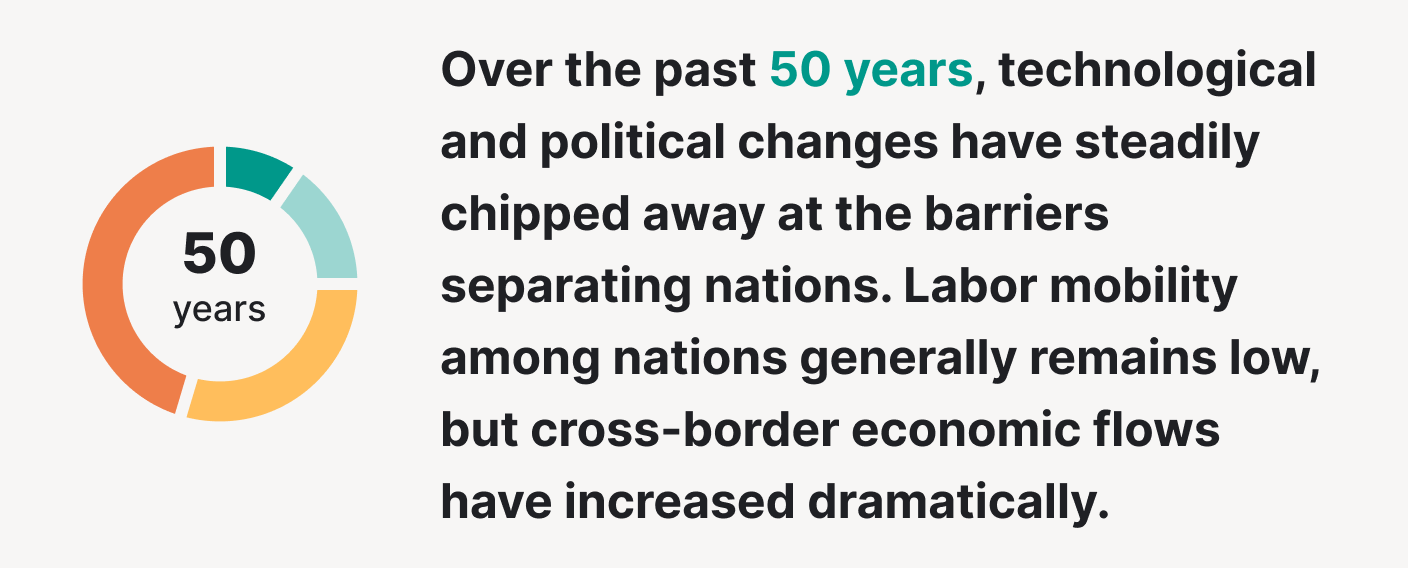
- How does Brexit affect the economy of the European Union? Analyze the immediate impact of Brexit on the EU’s economy. Predict future advantages and disadvantages of Brexit for both: Great Britain and the EU.
- South Africa: international agribusiness, trade, and financing.
- Historical essay: the economy of the Dutch East India company.
- The issue of Mozambique’s economy and possible solutions. Investigate the issue of extreme poverty in Mozambique. What are some possible solutions to the problem of poverty? Base your suggestions on the country’s cultural, historical, and geographical aspects.
- Imbalances in the global economy. Discuss the imbalances between trading countries on the scale of the global economy. What solutions would you suggest to deal with this issue?
- How will global economies adapt to China’s growing power?
- Etihad Airways company managerial economics.
🛠️ Labor Economics Essay Topics
- Ford Motor company’s labor economics.
- Labor economics: child labor.
- The UPS firm perspective: the labor market.
- Gender inequality of wage rate in modern business. Research how and why gender inequality is still an issue in the modern world of economics. What are some ways to deal with the problem? Present your ideas accurately and effectively. Provide solid arguments and appropriate examples to prove your position.
- What are the best ways to increase labor productivity in business?
- Labor unions adverse effects on economics.
- The decrease of the labor force in modern industries. Talk about the rising rates of robotization in the majority of industries. How will it affect the traditional labor force? Comment on the problem of unemployment caused by labor automatization.
- Violations of labor rights of workers.
- Modern labor essay: how can an entrepreneur guarantee the minimum wage to their workers?
- How can labor geography help develop a special economic zone? Talk about labor geography and its effects on developing an exclusive economic zone. How does the geopolitical location of a particular country influence its level of economic development?
- Entrepreneurship in the organic cosmetics sphere.
- Gender-oriented labor trade unions. A case study. Discuss the gender-oriented trade unions and analyze their impact on our society.
- Child labor in the Turkish cotton industry.

- The connection between economic growth and demography. Analyze the connection between economic growth and its demographic context. Investigate both sides: – The issue of overpopulation – The problem of low birth rate. From an economic perspective, what problem is more dangerous?
- The issue of sex discrimination in the workplace.
- The effects of Landrum-Griffin Labor Act. Explore the labor Act of Landrum-Griffin that was passed in the US Congress in 1959. Discuss its implications and consequences. Discuss its implications and consequences.
🌆 Urban Economics Essay Topics
- Cities and their role in aggregate economics.
- Urbanization in Hong Kong and its effects on citizens.
- The urban planning of the city of New York: a critical analysis. Analyze the urban history of NY. How has the city been developing? Discuss revolutionary solutions to the past and problems of modern times.
- The impact of a city’s design on the local traffic.
- Dubai’s spatial planning: creative solutions for building a city in the desert.
- Globalization, urban political economy, and economic restructuring.
- How do urban areas affect local wildlife? Comment on how modern production technologies in urban areas impact the natural diversity of wildlife. What impact does the rapid economic progress have on the environment? Suggest possible solutions.
- Urban sociology: does the city make us better people?
- Why should people be more careful about investing in real estate? Discuss the issues of overinvestment into real estate. Consider the economic crisis of 2008 as an example.
- How can regional authorities help improve a city?
- Urban life and its effects on education.
- The economic development of a city’s metropolitan area: challenges and solutions.
- Main factors for the emergence of cities in the Middle Ages.
- The ethics of relocation: is it justified? Talk about the case of relocating locals when building projects of great magnitude. To what extent can it be justified? Mention its economic and ethical side.
- The difficulties behind the construction of “green” buildings. Discuss the relatively new phenomenon of environmentally friendly buildings. Analyze both sides: the pros and cons. What obstacles lie behind the “green” building? What opportunities do the “green” buildings offer? Elaborate on your ideas by providing clear arguments or counterarguments.
- What factors play a critical role in the success of retail productivity in cities?
⚽ Sports Economics Essay Topics
- Do teams with higher budgets perform better on the field?
- Corruption in European football leagues: a critical analysis. Investigate the corruption issue in the European football leagues. State reasons and solutions for the problem.
- The managerial catastrophe of Arsenal F.C.

- The NextG sports company’s communication planning.
- Roger D. Blair’s Sports Economics literary review. Write a literary analysis of Sports Economics by Roger D. Blair. Discuss his opinion on the economy of sports. Do you agree or disagree with his position? Provide compelling supportive arguments or strong counterarguments.
- How significant is the impact factor of a local team on a city’s economy?
- Kinsmen Sports Centre: marketing metrics innovation.
- What role does statistical data play in sports? Analyze the part of economic statistical data in different sports organizations. How can statistics help to develop an effective financing plan? Comment on the impact of financing on the performance of a sports club.
- Sports and energy drinks marketing analysis.
- Is there a connection between the lack of money and any contemporary issues in a sports team?
- Performance-enhancing drugs in sports.
- The business of FIFA: a financial analysis. Investigate the finances of FIFA. What economic factors make them so influential in the modern world of football?
- The global sports retail industry.
- The Olympics: logistics and economy. Discuss the logistics behind the Olympics Games event. How the Olympic Games impact the economy of the host country?
💉 Health Economics Essay Topics
- Is bioprinting the new future of medicine? Analyze the new market of organ printing and discuss its challenges. Investigate bioprinting from an economic perspective. Will the outputs cover the inputs? How will bioprinting impact the financial aspect of the health care sector?
- Cost-effectiveness of pharmaceutical products in the United States. Comment on the immense cost-effectiveness of pharmaceuticals. What do you think is the price of pharmaceutical products reasonable? Is it ethical to set extremely high prices on the medicals?
- An economic evaluation of the antibiotics market.
- Health economics-SIC and NAICS.
- The financial side of cancer treatment: is it too expensive? Analyze the market for cancer treatment programs in various countries. Explore its costs and complications. What are some possible ways to reduce the price of cancer treatment and make it more affordable?
- The issue of fast food consumption: a multibillion-dollar market . Fast food has always been one of the notable causes of obesity, diabetes, and other illnesses. Investigate the economic aspect of the issue. Are high profits from fast food production worth peoples’ health conditions?
- History and evolution of healthcare economics.
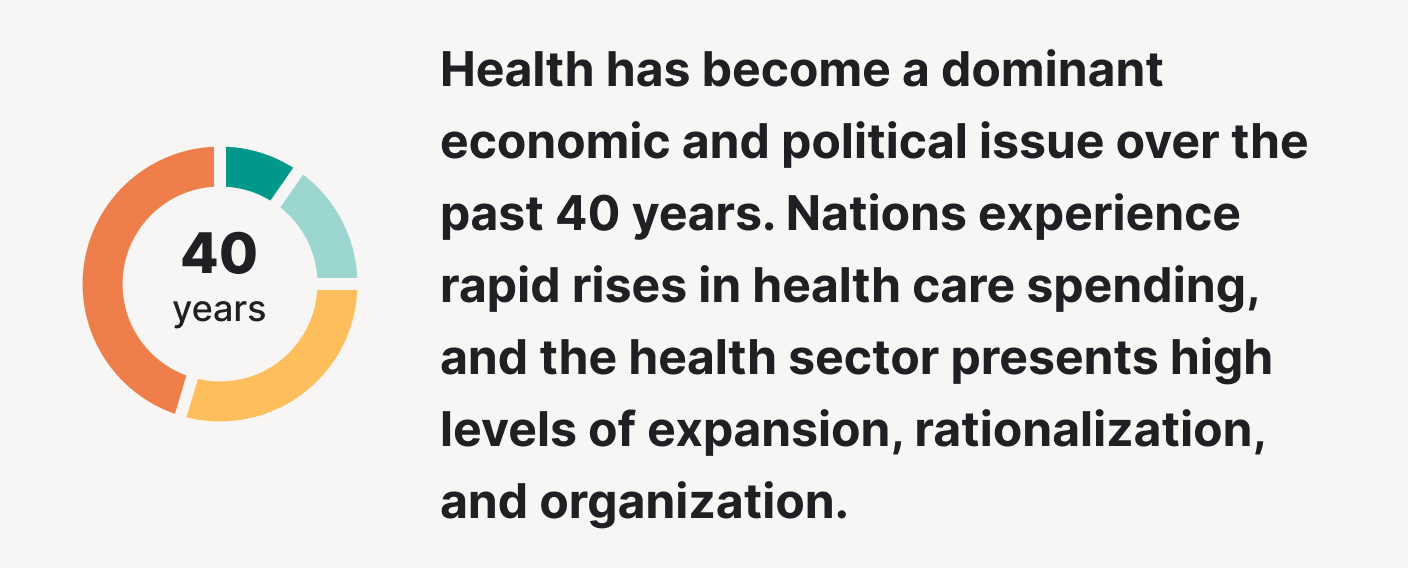
- The financial management of a hospital: a case study.
- The issue of public healthcare in the USA. Write about the long-standing issue of medical sector operation in the USA. Analyze its history, financial, and social aspects.
- Demand in healthcare economics.
- What are the economic outcomes of a global pandemic? Taking the COVID-19 outbreak as an example, conduct research on the effects of a pandemic on the economy. How does it affect local economies? What impact does the quarantine have on the international economy? Provide appropriate examples to support your ideas.
💼 Business Economics Essay Topics
- When does an advertising campaign become unnecessary?
- Sustainable development of a nation’s economic stability. Discuss how a country can create a sustainable economy. Provide bright examples to solidify your position.
- How can a small business compete with monopolies?
- What are the limitations of the Lewis Model?
- The phenomenon of inflation: inevitable liability or a land of opportunity for our economies? Explore the process of inflation in modern economies. Does it only have adverse effects on the countries’ economies? Are there any advantages of inflation? Analyze it from a positive perspective.
- Economics, business, and sugar in the UK.
- The shadow economy of the finance sector. Dive into the backstage of the finance sector and research various “grey” areas where business can be done.
- Chinese and Japanese business systems comparison.
- Oil demand and its changes in the XXI century: a critical analysis. Analyze the oil sector and write about its fluctuation in the XXI century. How did the changes in oil demand affect the global economy?
- The social and economic impact of mass emigration.
🌠 40 More Good Economic Essay Topics
Scrolled through our ideas, but can’t find a suitable topic for yourself? No worries! We have more issues to share with you.
So, don’t stress out. Take a look at our list of economical essay topics. Here are 40 more ideas focusing on globalization and the history of economics.
🏤 Economic Globalization Essay Topics
- The impact of globalization on the tourist industry in the Caribbean . Analyze both: the positive and negative effects of globalization on the Caribbean. To make your paper well-structured, explore two advantages and two disadvantages. Don’t forget to improve your essay with strong evidence and appropriate examples!
- Toyota Motor Corporation: impacts of globalization.
- What are the effects of globalization on developing countries? To what extent do developing countries profit from globalization? Research the subject by comparing various examples.
- Defining globalization and its effects on current trade.
- Economic growth as a result of globalization: proper financial strategies. How can a country successfully achieve prosperity with globalization? Discuss proper economic strategies.
- The socio-political significance of the IT industry’s globalization.
- Human trafficking in developing nations as a result of globalization.

- Globalization and criminal justice policy.
- What are the advantages and disadvantages of globalization?
- Globalization challenges and countermeasures.
- The effect of globalization on worldwide trade and employment rates.
- Economic integration within the European Union: a critical analysis. Talk about the history of economic integration within the EU. What are the negative and positive outcomes of economic integration?
- Globalization and food in Japan.
- Does globalization bring negative effects to cultural heritage and identity?
- The Industrial Revolution as the first step towards globalization. Focus on the Industrial Revolution in Europe. Discuss its precursors and consequences. Why is the revolution considered to be a starting point of globalization? Provide specific examples of globalization processes that occurred in the economic sector after the Industrial revolution.
- Globalization 2.0 an analysis of a book by David Rieff.
- Globalization effects on fundamentalism growth.
- Does direct investment by foreign businesses come with strings attached? Dive into the shady area of globalization and discuss how to direct foreign investment can bring problems of geopolitical scale.
- Effects of globalization on sexuality.
- Alibaba’s globalization strategy: an economic analysis.
🧮 Economic History Essay Topics
- The rapid economic growth of Europe during the Age of Discovery. Analyze the factors that brought economic growth to Europe during the Age of Discovery. What factors contributed to the dynamic economic progress of that time?
- Brazil’s economic history.
- History of capitalism: from the Renaissance to the United States of America. Discuss the origins of capitalism and its centuries-long path towards XXth century America. How the establishment of capitalism impacted the economy of the USA?
- Max Weber: economic history, the theory of bureaucracy, and politics as a vocation.
- 2008 Economic Crisis: origins and fallout. Talk about the 2008 Financial Crisis. Discuss its causes and outcomes. What should have been done differently to avoid the global crisis? Comment on the economic strategies countries used to recover from it.
- The economic marvel of Communist China: from rags to riches.
- What made world economic growth of the Renaissance possible?
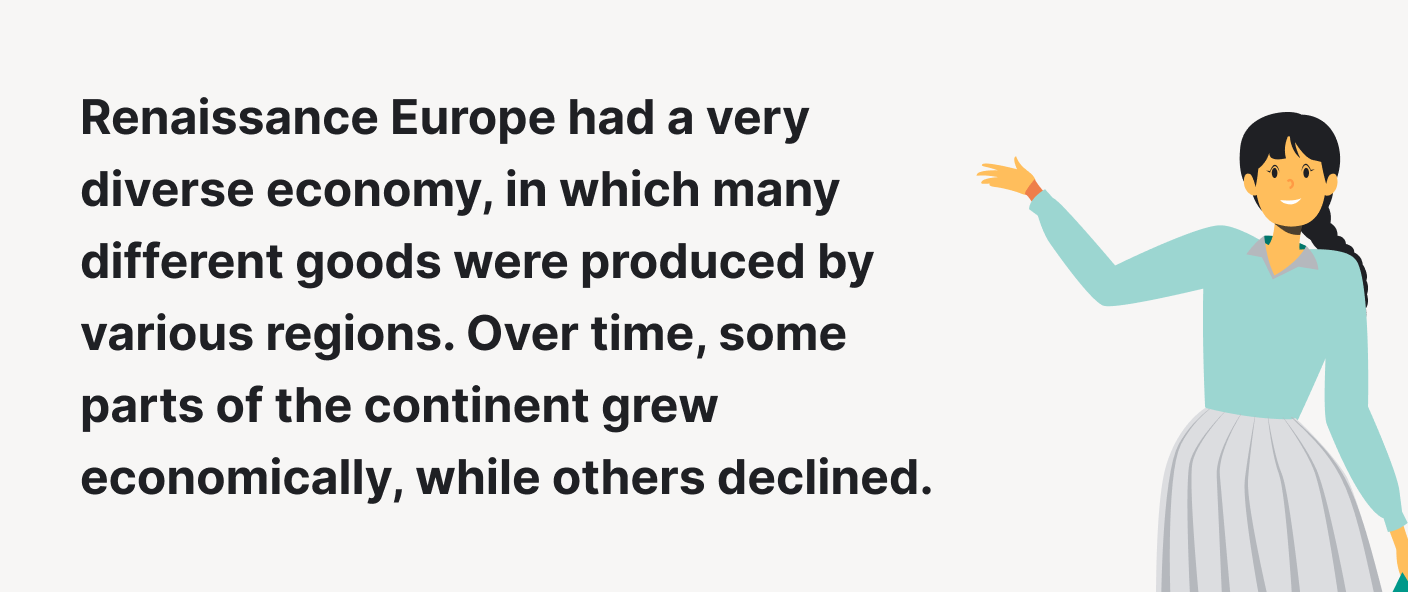
- The economic history of Canada: how did the settlers facilitate economic growth?
- What did the major powers of the XIXth century base their economies on?
- The Rothschilds: political and financial role in the Industrial Revolution. Research the dynasty of Rothschilds and how they came to power. What was their role in Europe’s Industrial Revolution?
- The link between the “oil curse” and the economic history of Latin America.
- Roman Empire’s monetary policy: a socio-economic analysis.
- How did the demand for different goods change their value in the 2000s years? Analyze the demand for goods in the 2000s years and their change in value. Why do these fluctuations in demand for products and services occur?
- The history of economic thought.
- Soviet Union’s economic timeline: from the new Economic Policy to Reformation. Discuss the economic issues of the Soviet Union from the historical perspective. Why did the Soviet Union collapse? What improvements in the financial sector should have been done?
- History of France economics over the past 20 years.
- The history of economic analysis.
- The concept of serfdom and slavery as the main economic engine of the past. Dive into the idea of feudalism and serfdom. Discuss its social and economic aspects.
- The World Bank’s structure, history, activities.
- The history of Islamic banking: concepts and ideas.
💫 How to Write an Economics Essay?
Generally, essay writing on economics has the same structure as any other essay. However, there are some distinctive features of economic papers. Thus, it is essential to figure them out from the very beginning of your work.
You might be wondering what those aspects of the economic paper are. Well, we have an answer.
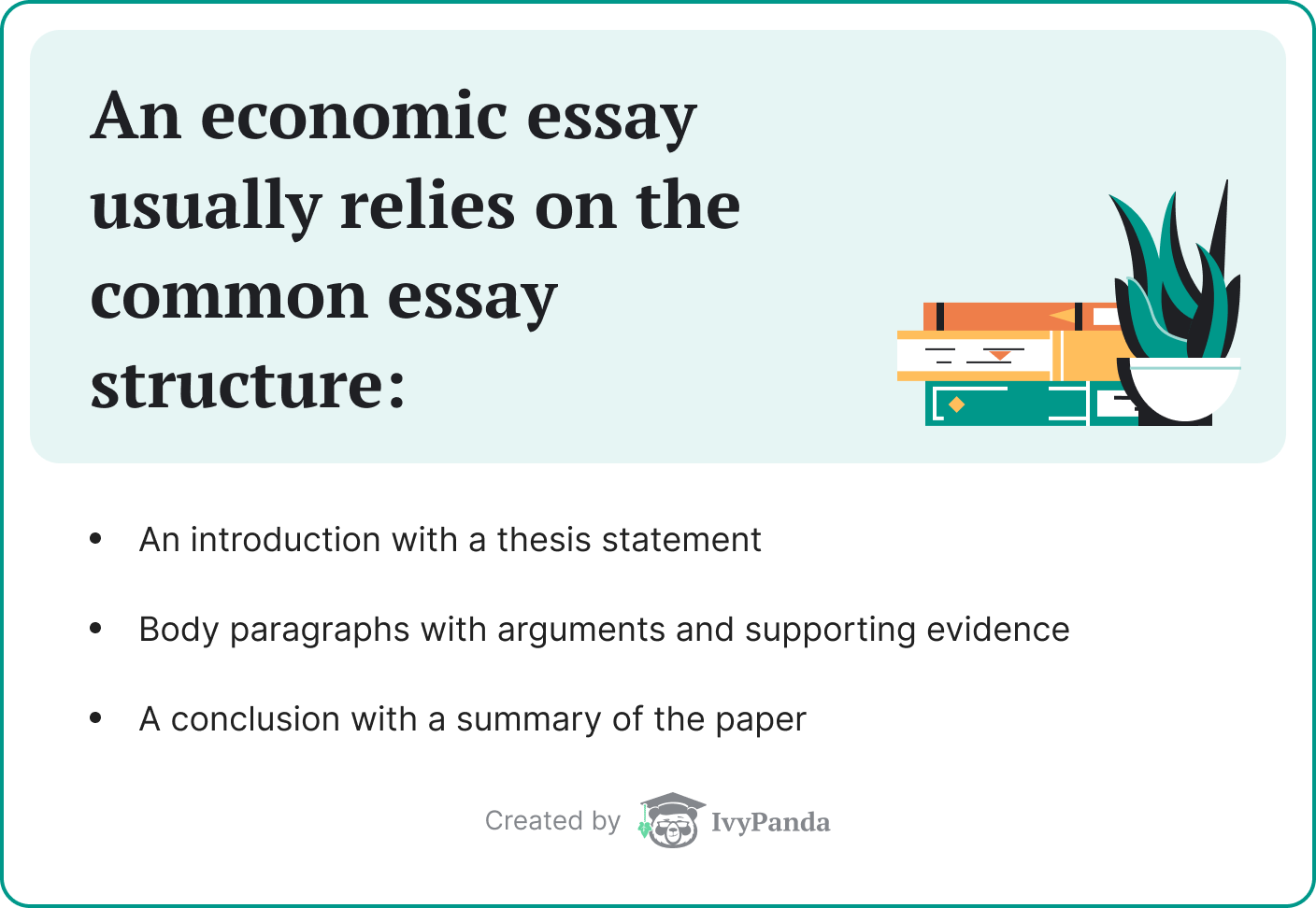
Below, you will find a detailed plan that explains the fundamental concepts of the essay writing process. So, don’t hesitate to use our tips! They are indeed helpful.
Pick a topic and dissect it. Picking the right topic is the very basis of writing a successful essay. Think of something that you will be interested in and make sure you understand the issue clearly. Also, don’t forget to check our ultimate economics essay topics and samples list!
Research it. After selecting the right idea from our economical essay topics, research your subject thoroughly. Try to find every fascinating and intriguing detail about it. Remember that you can always ask your fellow students, friends, or a teacher for help.
Come up with a thesis statement. A thesis statement is an essential element of your essay. It will determine your focus and guide the readers throughout your paper. Make your thesis secure and try to catch the reader’s attention using context and word choice.
Outline your essay. Never underestimate the power of a well-structured outline! Creating an essay outline can significantly help you to determine your general plan. Evaluate which economic framework you will be using to address the issue. State the main points of your thesis and antithesis. Make sure that they answer the central question of your work.
Write your introduction. First and foremost, a practical introduction should capture the readers’ attention and state the essay’s key topic. So, put enough effort to develop an outstanding introduction. It will create the first impression of your paper.
Moreover, an introduction should include a thesis statement. As we have mentioned above, a thesis plays a crucial role. Thus, make sure it is clearly stated.
Another significant feature of the introduction is its coherence with the body of your essay. Consequently, the introductory paragraph’s last statement has to present the subject of the next section, generically. Also, keep in mind that no more than three key points can be discussed in a paper, even if it is an extended essay.
Thoroughly work on the body paragraphs. Usually, the body of the essay contains several paragraphs. The number of these paragraphs will depend on the nature of your question. Be sure to create one section for every critical point that you make. This will make your paper properly-structured, and the reader will quickly get your ideas. For your convenience, we created a plan to develop your ideas in each paragraph, So, use it and make your writing process easier!
- Argument. Present your argument in the topic sentence of the paragraph in a way that directly answers the question. A hint: the most effective way to introduce the critical point is to place the topic sentence at the beginning of the paragraph. This will help the readers to concentrate their attention on a specific idea.
- Comment and discussion. Explain the meaning of your argument and provide an economic analysis. Present clear evidence and persuasive arguments to solidify your position.
- Connection. Link your comments with the vital point of the paragraph. Demonstrate the coherence of your evidence with the point.
- Diagrams, tables, charts. If necessary, provide the reader with visual aids. Sometimes, an appropriate diagram or a suitable chart can say more than words. Besides, your paper will look more professional if you use any kind of visual aids.
Conclude your essay. In your conclusion, summarize and synthesize your work by restating your thesis. Also, it is crucial to strengthen it by mentioning the practical value of your findings. Remember to make your essay readable by choosing appropriate wording and avoiding too complex grammar constructions.

Thank you for visiting our page! Did you enjoy our article and learned something new? We are glad to help you. Don’t forget to leave a comment and share the article with others!
🔗 References
- High School Economics Topics: Econlib, The Library of Economics and Liberty
- Guide to Writing an Economics Essay: The Economics Tutor
- How to Write the Introduction of Your Development Economics Paper: David Evans, Center For Global Development
- Senior Essay: Department of Economics, Yale University
- Developing A Thesis: Maxine Rodburg and The Tutors of the Writing Center at Harvard University
- Academic Essay Writing, Some Guidelines: Department of Economics, Carleton University
- The Writing Process: Writing Centre Resource Guide, LibGuides at Dalhousie University
- Research Papers: KU Writing Center, the University of Kansas
- Unpacking the Topic: University of Southern Queensland
- Economic Issues: PIIE, Peterson Institute for International Economics
- Areas of Research: EPI, Economic Policy Institute
- Top 100 Economics Blogs Of 2023: Prateek Agarwal, Intelligent Economist
- Current Environmental Economic Topics, Environmental Economics: US EPA, United States Environmental Protection Agency
- Hot Topics in the U.S. Economy: The Balance
- Share via Facebook
- Share via Twitter
- Share via LinkedIn
- Share via email
- Economic Essays Grade 12
Grade 12 Economic Essays for the Next Three-Year Cycle (2021-2023)
- Discuss in detail the markets within the FOUR-SECTOR model (Circular Flow)
Discuss in detail 'The new economic paradigm'/Explain the 'smoothing of cycles (Business Cycles)
Discuss in detail the features underpinning forecasting (Business Cycles)
Discuss in detail the main objectives of the public sector in the economy (Public Sector)
Discuss in detail the reason(s) for public sector failure (link them to typical problems experienced through public sector provisioning) (Public Sector)
Discuss in detail the reasons for international trade (Foreign Exchange Markets)
- Discuss in detail export promotion (Protectionism and FreeTrade)
Discuss in detail the arguments in favour of protectionism (Protectionism and Free Trade)
Discuss in detail the demand-side approach in promoting growth and development in South Africa (Growth and development)
Discuss in detail the following South African growth and development policies and strategic initiatives (Growth and development)
Discuss in detail South Africa's initiaties (endeavours) in regional development (Industrial Development Policies)
Discuss in detail the following economic indicators (Economic and Social Performance Indicators
Discuss in detail the following social indicators (Economic and Social Performance Indicators)
Discuss in detail the various equilibrium positions with the aid of graphs-PERFECT MARKET (Perfect Market)
- Discuss the monopoly in detail (with/without the aid of graphs) (Imperfect Market)
Examine the oligopoly in detail (Imperfect Market)
- Compare and contrast any TWO types of market structures
Discuss in detail how the following factors lead to the misallocation of resources in the market (Market Failures)
Discuss in detail state intervention as a consequence of market failures, with the aid of relevant graphs (Market Failures)
Discuss in detail the consequences of inflation (Inflation)
Discuss in detail the measures to combat demand-pull and/or cost-push inflation (Inflation)
Examine in detail the effects of tourism (Tourism)
Examine in detail the benefits of tourism (Tourism)
Discuss in detail how the government can ensure sustainable development (Environmental Sustainability)
- Discuss in detail the following problems and the international measures taken to ensure sustainable development (Environmental Sustainability)
ESSAYS FOR THE NEXT THREE-YEAR CYCLE (2021-2023)
Macroeconomics- paper1.
Discuss in detail the markets within the FOUR-SECTOR model (Circular Flow) INTRODUCTION The economy of a country is regarded as an open economy because of the presence of households, producers, government, foreign sector and financial sector as active participants in the economy. Markets link the participants in the economy 🗸🗸 [Max 2]
BODY: MAIN PART PRODUCT / GOODS/ OUTPUT MARKET🗸
- These are the markets for consumer goods and services🗸🗸
- Goods are defined as tangible items, like food, clothes, cars, etc. that satisfies some human wants or needs🗸🗸
- Buying and selling of goods that are produced in markets e.g. 🗸🗸
- Capital Goods market for trading of buildings and machinery🗸🗸
- Consumer goods market for trading of durable consumer goods, semi-durable consumer goods and non-durable consumer goods. 🗸🗸
- Services are defined as non-tangible actions and include wholesale and retail, transport and financial markets. 🗸🗸
FACTOR / RESOURCE/ INPUT MARKETS🗸
- Households sell factors of production on the markets: rent for natural resources, wages for labour interest for capital and profit for entrepreneurship🗸🗸
- The factor market includes the labour, property and financial markets. 🗸🗸
- The market where services of factors of production are traded e.g. labour is hired and capital is borrowed – these services earn wages, interest, rent and profits🗸🗸
FINANCIAL MARKETS🗸
- They are not directly involved in the production of good and services, but act as a link between households , the business sector and other participants with surplus finds🗸🗸
- E.g. banks, insurance companies and pension funds🗸
MONEY MARKETS🗸
- In the money markets short term loans, and very short term funds are saved and borrowed by consumers and business enterprises 🗸🗸
- Products sold in the market are bank debentures, treasury bills and government bonds 🗸🗸
- The simplest form exists when parties make demand and short-term deposits and borrow on short term 🗸🗸
- The SARB is the key institution in the money market🗸🗸
CAPITAL MARKETS🗸
- In the capital markets long term funds are borrowed and saved by consumers and the business sector🗸🗸
- The Johannesburg Security Exchange (JSE) is a key institution in the capital 🗸🗸
- Products sold in this market are mortgage bonds and shares🗸🗸
FOREIGN EXCHANGE MARKETS🗸
- On the foreign exchange markets businesses buy/ sell foreign currency to pay for imported goods and services🗸🗸
- These transactions occur in banks and consists of electronic money transfers from one account to another🗸🗸
- The leading centres/ most important foreign exchange markets are in London, New York and Tokyo 🗸🗸
- e.g. traveller’s cheques to travel abroad🗸
- Flows of private and public goods and services are real flows and they are accompanied by counter flows of expenditure and taxes on the product market🗸🗸
- Factor services are real flows and they are accompanied by counter flows of income on the factor market🗸🗸
- Imports and exports are real flows and are accompanied by counter flows of expenditure and revenue on the foreign exchange market🗸🗸[Max 26]
- A change in investment of R 10m will result in a change in income of R 20m🗸🗸
- An increase in investment causes the expenditure function to shift upwards from C1 to C2 so that C1 is parallel to C2🗸🗸
- The effect of the increase in investment is that the total expenditure will increase from R 20m to R 30m🗸🗸
- The increase in the value of output (Y) is greater than the increase in the expenditure (E) 🗸🗸 (Explanation must comply with the figures supplied in the graphical presentation) [Max 4] [Max 10]
CONCLUSION The circular flow ensures continued interdependence and coordination of the economic activities in the economy / markets are critically important institutions in our economic system, because they regulate the supply and demand and safeguard price stability and general business confidence. 🗸🗸 [Any other relevant conclusion] [Max 2]
INTRODUCTION The new economic paradigm in terms of the smoothing of business cycles discourages monetary policy makers from using monetary and fiscal policies to fine tune the economy but rather encourages achieving stability through sound long term decisions relating to demand and supply in the economy/smoothing out the painful part of economic down-fall that is part of the market economy🗸🗸 (Accept other relevant definition/description of smoothing/new economic paradigm). [Max 2]
BODY: MAIN PART The new economic paradigm is embedded in the demand and supply side policies. 🗸🗸
Demand-side policies
- It focuses on aggregate demand in the economy🗸🗸
- When households, firms and the government spend more, demand in the economy increases. 🗸🗸
- This makes the economy grow but lead to inflation.🗸🗸
- Aggregate demand increases more quickly than aggregate supply and this causes price increases. 🗸🗸
- If the supply does not react to the increase in demand, prices will increase. 🗸🗸
- This will lead to inflation (a sustained and considerable in the general price level) 🗸🗸
Unemployment:
- Demand-side policies are effective in stimulating economic growth. 🗸🗸
- Economic growth can lead to an increase in demand for labour. 🗸🗸
- As a result more people will be employed and unemployment will increase. 🗸🗸
- As unemployment decreases inflation is likely to increase. 🗸🗸
- This relationship between unemployment and inflation is illustrated in the Phillips curve. 🗸🗸
- The PC curve shows the initial situation. A is the point of intersection of the PC curve with the x- axis. It shows the natural rate of unemployment, for instance 14%🗸🗸
- At point A inflation rate is zero. 🗸🗸
- If unemployment falls to C for instance, 8%, inflation caused by wage increases is at 6%.🗸🗸
- If unemployment increases from C to B to A, inflation falls from 6% to 2% to 0%.🗸🗸
Supply-side policies Reduction of costs 🗸
- Infrastructural services: reasonable charge and efficient transport, communication, water
- services and energy supply. 🗸🗸
- Administrative costs: these costs include inspection, reports on applications
- of various laws, regulations and by-laws, tax returns and returns providing statistical
- information.
- It adds to costs and businesses carry a heavy burden 🗸🗸
- Cash incentives: it includes subsidies for businesses to locate in neglected areas where unemployment is high and compensation to exporters for certain costs they
- incurred in development of export markets. 🗸🗸
Improving the efficiency of inputs 🗸
- Tax rates: low tax rates can serve as an incentive to workers. It will improve the productivity and output. 🗸🗸
- Capital consumption: replacing capital goods regularly creates opportunities for businesses to keep up with technological development and better outputs🗸🗸
- Human resource development: to improve the quality of manpower by improving health care, education and training. 🗸🗸
- Free advisory service: these promote opportunities to export. 🗸🗸
Improving the efficiency of markets 🗸
- Deregulation: removal of laws, regulations and by-laws and other forms of government controls makes the market free. 🗸🗸
- Competition: encourages the establishment of new businesses 🗸🗸
- Levelling the play field: private businesses cannot compete with public enterprises 🗸🗸 Answers must be in full sentences and well described with examples to be able to obtain 2 marks per fact. Learners should be awarded 1 mark per heading or sub-heading to a maximum of 8 marks. (8 x 1) (8) [Max 26]
Explanation: The above graph shows:
- Aggregate demand (AD) and aggregate supply (AS) are in equilibrium at point C. 🗸🗸
- If aggregate demand is stimulated so that it moves to AD1 and aggregate supply responds promptly and relocates at AS1; a larger real output becomes available without any price increases. 🗸🗸
- Supply is often sticky and fixed in the short term. 🗸🗸
- Therefore, if aggregate demand increases to AD1 and aggregate supply does not respond, intersection is at point F. Real production increases but so does the price, in other words, with more inflation. 🗸🗸
- The aggregate demand locates at any position to the left of AS1 inflation prevails. 🗸🗸
- The solution is to create conditions that ensure supply is more flexible. 🗸🗸
- If the cost of increasing production is completely flexible, a great real output can be supplied at any given price level. 🗸🗸 [Max 10]
CONCLUSION It is clear from the discussion above that it is critically important to manage the aggregate supply and demand to ensure stability in the economy. 🗸🗸 [Accept any relevant higher order conclusion] [Max 2]
INTRODUCTION Accurate prediction is not possible in Economics. The best the economists can do is to try and forecast what might happen. There are a number of techniques available to help economists to forecast business cycles, e.g. economic indicators 🗸🗸 OR Successive periods of contraction and expansion of economic activities 🗸🗸 [Accept any other relevant introduction] [Max 2]
BODY: MAIN PART Business cycle indicators Leading economic indicators 🗸
- These are indicators that change before the economy changes / coincide with the reference turning point 🗸🗸
- They give consumers, business leaders and policy makers a glimpse (advance warnings) of where the economy might be heading. 🗸🗸
- Peak before a peak in aggregate economic activity is reached.
- Most important type of indicator in helping economists to predict what the economy will be like in the future 🗸🗸
- When these indicators rise, the level of economic activities will also rise in a few months' time/an upswing 🗸🗸
- E.g. job advertising space/inventory/sales ratio🗸
Coincident economic indicators🗸
- They move at the same time as the economy / if the turning point of a specific time series variable coincides with the reference turning point🗸🗸
- It indicates the actual state of the economy🗸🗸
- E.g. value of retail sales. 🗸
- If the business cycle reaches a peak and then begins to decline, the value of retail sales will reach a peak and then begin to decline at same time🗸🗸
Lagging economic indicators🗸
- They do not change direction until after the business cycle has changed its direction🗸🗸
- They serve to confirm the behaviour of co-incident indicators🗸🗸
- E.g. the value of wholesalers' sales of machinery🗸
- If the business cycle reaches a peak and begins to decline, we are able to predict the value of new machinery sold🗸🗸
Composite indicator🗸
- It is a summary of the various indicators of the same type into a single value🗸🗸
- Their values are consolidated into a single value , if this is done we find a value of a composite leading , coincident and lagging indicator🗸🗸 Accept ONE example from the table below:
- This is the time that it takes for a business cycle to move through one complete cycle (measured from peak to peak) 🗸🗸
- It is useful to know the length because the length tends to remain relatively constant over time.🗸🗸
- If a business cycle has the length of 10 years it can be predicted that 10 years will pass between successive peaks or troughs in the economy. 🗸🗸
- Longer cycles show strength. 🗸🗸
- Cycles can overshoot. 🗸🗸
Ways to measure lengths:
- Crisis to crisis 🗸🗸
- Historical records 🗸🗸
- Consensus on businesses experience 🗸🗸
Amplitude 🗸
- It is the difference between the total output between a peak and a trough. 🗸🗸
- It measures the distance of the oscillation of a variable from the trend line / It is the intensity (height) of the upswing and downswing (contraction and expansion) in economic activity 🗸🗸
- A large amplitude during an upswing indicates strong underlying forces – which result in longer cycles 🗸🗸
- The larger the amplitude the more extreme the changes that may occur / extent of change 🗸🗸
- E.g. During the upswing inflation may increase from 5% to 10%. (100% increase) 🗸🗸
- A trend is the movement of the economy in a general direction. 🗸🗸
- It usually has a positive slope because the production capacity of the economy increases over time 🗸🗸
- Also known as the long term growth potential of the economy. 🗸🗸
- The diagram above illustrates an economy which is growing – thus an upward trend (positive slope) 🗸🗸
- Trends are useful because they indicate the general direction in which the economy is moving – it indicates the rate of increase or decrease in the level of output🗸🗸
Extrapolation 🗸
- Forecasters use past data e.g. trends and by assuming that this trend will continue, they make predictions about the future🗸🗸
- Means to estimate something unknown from facts or information that are known 🗸🗸
- if it becomes clear that the business cycle has passed through a trough and has entered a boom phase, forecasters might predict that the economy will grow in the months that follow 🗸🗸
- It is also used to make economic predictions in other settings e.g. prediction of future share prices🗸🗸
Moving average 🗸
- It is a statistical analytical tool that is used to analyse the changes that occur in a series of data over a certain period of time / repeatedly calculating a series of different average values along a time series to produce a smooth curve 🗸🗸
- The moving average could be calculated for the past three months in order to smooth out any minor fluctuations 🗸🗸
- It is calculated to iron out (minimize) small fluctuations and reveal long-term trends in the business cycle🗸🗸 Answers must be in full sentences and well described with examples to be able to obtain 2 marks per fact. Learners should be awarded 1 mark per 8 headings and examples. [8 x 1=8] [Max 26]
BODY: ADDITIONAL PART
- An expansionary monetary policy is implemented when the economy is in recession in order to stimulate economic activities. 🗸🗸
- Interest rates can be reduced to encourage spending. 🗸🗸
- Households and firms can borrow more and spend more. 🗸🗸
- The increased spending increases the level of economic activity. 🗸🗸
- Investment will increase and more factors of production will be employed. 🗸🗸
- Higher levels of production, income and expenditure will be achieved. 🗸🗸
- If the supply of goods and services does not increase in line with an increase in demand, inflation will increase. 🗸🗸
- Inflation can be curbed by reducing money supply and availability of credit. 🗸🗸
- To dampen demand at the peak the government will be able to reduce the money supply by increasing interest rates. 🗸🗸
- Selling government bonds and securities (open market transactions) and reduce the supply of money in circulation. 🗸🗸
- Increase the cash reserve requirements to manipulate money creation activities of banks. 🗸🗸
- Persuade banks to decrease lending (moral suasion) 🗸🗸
- To devaluate the exchange rate (exchange rate policy) 🗸🗸 [Max 10]
CONCLUSION It remain clear that business cycles must be clearly monitored through the indicators available, policy makers must act quickly by using monetary and fiscal instruments in order to prevent instability in the economy. 🗸🗸 [Accept any other relevant conclusion] [Max 2]
INTRODUCTION: The government provides goods and services that are under supplied by the market and therefore plays a major role in regulating economic activity and guiding and shaping the economy. 🗸🗸 [Max 2]
BODY: MAIN PART Objectives:
Economic growth 🗸
- Refer to an increase in the production of goods and services 🗸🗸
- Measured in terms of Real GDP 🗸🗸
- For economic growth to occur, the economic growth rate must be higher than Population growth 🗸🗸
- Growth and development in a country benefit its citizens because it often leads to a higher standard of living 🗸🗸
Full employment 🗸
- It is when all the people who want to work, who are looking for a job must be able to get a job 🗸🗸
- High levels of employment is the most important economic objective of the government 🗸🗸
- The unemployment rate increased over the past few years 🗸🗸
- Informal sector activities must be promoted because it is an area where employment increase 🗸🗸
Exchange rate stability 🗸
- The economy must be manage effectively and effective Fiscal and monetary policy must be used to keep the exchange rate relatively stable 🗸🗸
- Depreciation and Appreciation of the currency create uncertainties for producers and traders and should be limited. These uncertainties must be limited 🗸🗸
- The SARB changed the Exchange rate from a Managed floating to a free floating exchange rate 🗸🗸
Price stability 🗸
- Stable price causes better results in terms of job creation and economic growth 🗸🗸
- The SARB inflation target is 3% - 6% and they are successful in keeping inflation within this target 🗸🗸
- Interest Rates, based on the Repo Rate are the main instruments used in the stabilisation policy 🗸🗸
- The stable budget deficit also has a stabilizing effect on the inflation rate 🗸🗸
Economic equity 🗸
- Redistribution of income and wealth is essential 🗸🗸
- South Africa uses a progressive income tax system – taxation on profits, taxation on wealth, capital gains tax and taxation on spending, are used to finance free services 🗸🗸
- Free social services are basic education; primary health and to finance basic economic services 🗸🗸
- E.g. Cash Grant to the poor, e.g. child grants and cash grants to vulnerable people, e.g. disability grants 🗸
- Progressive taxation means that the higher income earners pay higher/more taxation 🗸🗸 [Max 26]
- Learner responses can be positive or negative.
- Follow the argument and see if the learner can produce enough evidence to support his/her answer.
Economic Growth:
- SA targets 4–5% economic growth. Previously SA had a 5% growth rate 🗸🗸
- In recent years the growth rate decreased steadily (presently below 3%) 🗸🗸
Full Employment:
- Compared to foreign countries unemployment is very high. (Expanded – over 30%) 🗸🗸
- Efforts by SA government to reduce these figures includes the GEAR strategy, focus on small business enterprises, Public Works Programme 🗸🗸
Exchange rate stability:
- SA now operates on a free floating exchange rate system in line with international benchmarks 🗸🗸
- Unfortunately our currency has lost its value, with a general trend of depreciation over the last few years 🗸🗸
Price stability:
- For the past few years South Africa has managed to remain within the 3–6% target 🗸🗸
- The current increase in the repo rate has put constraints on the inflation rate 🗸🗸
Economic equity:
- Economic equity has improved (BEE, affirmative action, gender equity) and led to an improvement in economic equity 🗸🗸 [Any 5 x 2] [Max 10]
CONCLUSION: While some successes have been achieved by government, the fulfilling of some of the objectives are compromised by factors like lack of accountability, corruption, budgeting, nepotism and incompetence. 🗸🗸 [Any relevant conclusion] [Max 2]
INTRODUCTION The government responds to market failures by establishing and maintaining state owned enterprises to provide public goods and services 🗸🗸 [Any other relevant introduction] [Max 2]
BODY: MAIN PART
- It is required to give an explanation of one's decisions, actions and expenditures over a period of time 🗸🗸
- There are mechanisms for evaluating government's economic and financial performance 🗸🗸
- That the desired quantities and quality of goods and services for which taxes are raised are delivered 🗸🗸
- That monopolies, corruption, nepotism, incompetence and apathy does not occur 🗸🗸
- Two important elements of accountability is participation and transparency🗸🗸
- Ministerial responsibilities, i.e. the ministers of government departments are responsible for decisions and actions and expenditures 🗸🗸
- Parliamentary questioning arises and members of the government departments have to respond 🗸🗸
- The national treasury is responsible for treasury control 🗸🗸
- The auditor-general reports annually in writing on each government department🗸🗸
- Public goods are efficiently provided if Pareto efficiency is achieved 🗸🗸
- That is if resources are allocated in such a way that no one can be made better off without making someone else worse off 🗸🗸
- Bureaucracy the official rules and procedures. 🗸🗸/insensitivity to the needs of their clients 🗸🗸
- Incompetence- the lack of skill or ability to do a task successfully🗸🗸/May have improper qualifications/or an attitude of apathy 🗸🗸
- Corruption- the exploitation of a person's position for private gain /taking bribes, committing fraud, nepotism 🗸🗸
- State-owned enterprises do not operate according to the forces of supply and demand 🗸🗸
- It becomes thus very difficult for state-owned enterprises to assess needs and they are thus prone to under- or over-supplying public goods and services 🗸🗸
- The census and other household surveys as well as local government structures provide this type of information 🗸🗸
- Since resources are scarce, government must then decide which needs and whose needs are to be satisfied 🗸🗸
- In the private sector houses are built according to the price that people are able and willing to pay 🗸🗸
- In the public sector housing is regarded as a social responsibility and authorities supply them according to the needs of people 🗸🗸
- In a market economy prices are determined by supply and demand 🗸🗸
- The objectives of firms are to maximise their profits and they usually set prices to achieve this objective 🗸🗸
- Government does not pursue the profit maximisation objective 🗸🗸
- Government takes into account certain social, economic, political and environmental conditions as well as public opinion 🗸🗸
- Free-of-charge services- this is met from taxes 🗸🗸 and applies to most community goods and collective goods 🗸🗸 (e.g.) defence, police whereby charges and toll fees are levied 🗸
- User-charges 🗸 option to charge depends on technical reasons 🗸🗸 (e.g.) cost of providing a double lane road could be recovered by toll charges 🗸 Economic reasons 🗸 such as services like water and electricity 🗸 that have a zero price 🗸 political reasons 🗸 where income distribution is significantly unequal, administrative rationing according to need takes place 🗸🗸 (e.g.) public health and education 🗸
- Direct and indirect subsidies direct subsidies are used to cover part of the costs 🗸🗸 (e.g.) urban bus service 🗸 and an indirect subsidy is used to write off accumulated losses or deficits 🗸🗸
- Standing charges -called availability charges 🗸🗸 (e.g.) water and electricity 🗸 standing charges goes to meet fixed costs and the price per unit consumed covers variable costs 🗸🗸
- Price discrimination - different users have different elastic ties of demand for a good 🗸🗸 (e.g.) commercial and manufacturing businesses pay higher rates than households and they pay on a sliding scale🗸🗸
- State-owned enterprises that either render a service or when an existing enterprise is nationalised 🗸🗸
- They focus on making a profit and maximizing cost at the expense of the needs of some groups 🗸🗸 (e.g.) Iscor 🗸 SABC, 🗸SAA, Spoornet 🗸
- refers to the process whereby state-owned enterprises and state-owned assets are handed over or sold to private individuals 🗸🗸
- cost of maintaining and managing state-owned enterprises are high which can lead to higher taxes and larger public debt 🗸🗸
- State-owned enterprises are not run as efficiently as private enterprises 🗸🗸
- Nationalisation is the process whereby the state takes control and ownership of privately owned assets and private enterprises 🗸🗸
- It includes contracting of services, public-private partnerships, increasing competitiveness🗸🗸 [Max 26]
ADDITIONAL PART Possible problems in your community or elsewhere
- Lack of drinking water due to burst pipes 🗸🗸
- Lack of electricity due to lack of infrastructure (load shedding) 🗸🗸
- Lack of schooling – no buildings available – lack of maintenance 🗸🗸
- Lack of health services due to lack of staff, infrastructure, strikes 🗸🗸
- Lack of adequate housing (RDP) 🗸🗸 [Max 10 marks - List of examples max 5 marks] [Accept any other relevant answer]
CONCLUSION If the above problems are not dealt with timeously by government, government will continue to fail its people in terms of service delivery, seeing many protests occurring regularly 🗸🗸 [Any other relevant higher order conclusion] [Max 2]
INTRODUCTION International trade can be defined as the exchange of goods and services between countries globally. 🗸🗸 These trade agreements are negotiated by protocols and agreement due to the uneven distribution of natural resources globally. 🗸🗸
BODY-MAIN PART The main reasons for international trade.
Demand reasons The size of the population impacts demand.
- If there is an increase in population growth, it causes an increase in demand, as more people’s needs must be satisfied. 🗸🗸
- Local suppliers may not be able to satisfy this demand. 🗸🗸
The population’s income levels effect demand.
- Changes in income cause a change in the demand for goods and services. 🗸🗸 • An increase in the per capita income of people in more disposable income that can be spent on local goods and services, some of which may then have to be imported. 🗸🗸
An increase in the wealth of the population leads to greater demand for goods.
- People have access to loans and can spend more on luxury goods, many of which are produced in other countries. 🗸🗸
Preferences and tastes can play a part in the determining of prices,
- E.g. customers in Australia have a preference for a specific product which they do not produce and need to import and it will have a higher value than in other countries. 🗸🗸
The difference in consumption patterns is determined
- By the level of economic development in the country, e.g. a poorly developed country will have a high demand for basic goods and services but a lower demand for luxury goods. 🗸🗸
Supply reasons Natural resources are not evenly distributed
- Across all countries of the world. 🗸🗸
- They vary from country to country and can only be exploited in places where these resources exist. 🗸🗸
Climatic conditions
- Make it possible for some countries to produce certain goods at a lower price than other countries, e.g. Brazil is the biggest producer of coffee. 🗸🗸
Labour resources
- Differ in quantity, quality and cost between countries. 🗸🗸
- Some countries have highly skilled, well-paid workers with high productivity levels, e.g. Switzerland. 🗸🗸
Technological resources
- Are available in some countries that enable them to produce certain goods and services at a low unit cost, e.g. Japan. 🗸🗸
Specialisation in the production
- Certain goods and services allows some countries to produce them at a lower cost than others, e.g. Japan produces electronic goods and sells these at a lower price. 🗸🗸
Capital allows developed countries
- Enjoy an advantage over underdeveloped countries. 🗸🗸
- Due to a lack of capital, some countries cannot produce all the goods they require themselves. 🗸🗸
ADDITIONAL PART
- Buying and selling goods and services from other countries: 🗸🗸
- The purchase of goods and services from abroad that leads to an outflow of currency from SA- Imports (M). 🗸🗸
- The of goods and services to buyers from other countries leading to an inflow of currency to SA – Exports (X) 🗸🗸
- Different factor endowments mean some countries can produce goods and services more efficiently than others- specialisation is therefore possible: 🗸🗸
Absolute Advantage:
- Where one country can produce goods with fewer resources than other. 🗸🗸
Comparative Advantage:
- Where one country can produce goods at a lower opportunity cost it sacrifices less resources in production. 🗸🗸
CONCLUSION International trade is important of countries to survive economically, as barriers to trade would disadvantage all countries, due to their interdependency globally. 🗸🗸 [Any other relevant higher order conclusion] [Max 2]
ECONOMIC PURSUITS-PAPER 1
Discuss in detail export promotion (Protectionism and Free Trade)
INTRODUCTION Export promotion refers to measures taken by governments increase production of goods and services that can be exported. The government provides incentives to encourage production 🗸🗸 [Max 2]
BODY: MAIN PART REASONS:
- Export promotion measures lower cost of production which makes it easier to compete on the international market 🗸🗸
- Achieve significant export-led economic growth🗸🗸
- Export enlarges production capacity of country because more and larger manufacturing industries are established. 🗸🗸
- The first step to export-led economic growth is to implement policies that encourage the establishment of industries to produce goods and services for export markets🗸🗸
METHODS: Exports are promoted through: Incentives🗸
- Export incentives include information on export markets, research with regard to new markets, concessions on transport charges, export credit and export credit guarantees and publicity commending successful exporters🗸🗸
- This will encourage manufacturers to export an increased volume of their production🗸🗸
- Trade missions help to market SA products abroad🗸🗸and supply SA companies with information about potential markets 🗸🗸
Direct Subsidies🗸
- Described as direct because it involves government expenditure. 🗸🗸
- Include cash payments to exporters, refunds on import tariffs and employment subsidies.
- The aim is to increase the competitiveness of exporting company🗸🗸 reduce cost of production🗸🗸and explore and establish overseas markets🗸🗸
Indirect subsidies
- Regarded as indirect because it results in the government receiving less revenue🗸🗸 e.g. general tax rebates,
- Tax concessions on profits earned from exports or on capital invested to produce export goods, refunding
- Of certain taxes e.g. custom duties on imported goods used in the manufacturing process🗸🗸
- Allows companies to lower their prices and enables them to compete in international markets🗸🗸
- Challenge for governments to design incentives and subsidies in such a way that prices of export goods can't be viewed as dumping prices🗸🗸
Trade neutrality 🗸
- Can be achieved if incentives in favour of export production are introduced
- Up to point that neutralises the impact of protectionist measures in place🗸🗸
- E.g. subsidies equal to magnitude of import duties can be paid🗸
Export processing zones (EPZs) 🗸
- Is free-trade enclave within a protected area –
- Is fenced and controlled industrial park that falls outside
- Domestic customs area, and usually located near harbour or airport 🗸🗸 NOTE : For the response with regard to the effectiveness of export promotion methods, a maximum of 5 marks can be allocated.
- No limitations on size and scale since world market is very large🗸🗸
- Cost and efficiency of production based on this and organised along lines of comparative advantage🗸🗸
- Increased domestic production will expand exports to permit more imports and may result in backward linkage effects that stimulate domestic production in related industries🗸🗸
- Exchange rates are realistic and there is no need for exchange control and quantitative restrictions🗸🗸
- Value can be added to natural resources of the country 🗸🗸
- Creates employment opportunities 🗸🗸
- Increase in exports has positive effect on balance of payments 🗸🗸
- Increase in production leads to lower domestic prices, which benefit local consumers🗸🗸
DISADVANTAGES
- Real cost of production 🗸 subsidies and incentives reduce total cost of production which must be met from sales🗸🗸 real cost is thus concealed by subsidies🗸🗸products cannot compete in open market 🗸🗸
- Lack of competition 🗸 businesses charge prices that are so low that they force competitors out of the market 🗸🗸
- Increased tariffs and quotas 🗸can be against spirit of provisions of WTO🗸🗸overseas competitors retaliate with tariffs and quotas🗸🗸 goods are sold domestically below their real cost of production (export subsidies and dumping) 🗸🗸
- Protection of labour-intensive industries 🗸 developed countries maintain high levels of effective protection for their industries that produce labour-intensive goods in which developing countries already have or can achieve comparative advantage 🗸🗸
- Withdrawal of incentives often leads to closure of effected companies. 🗸🗸
- Incentives often lead to inefficiencies in the production process, since companies don't have to do their best to compete🗸🗸
- Can be seen as dumping 🗸🗸 [Max 26]
BODY: ADDITIONAL PART How successful is South Africa in protecting the local textile industry against foreign competition?
- Not successful: 🗸 Many domestic textile manufacturers closed down due to unfair international competition 🗸🗸 Many wholesalers make use of suppliers from abroad 🗸🗸 e.g. Woolworths/Walmart🗸
- Dumping still occurs – European manufacturers still dump clothing in Africa out of season at prices below cost 🗸🗸 Job losses due to a lack of protection in this industry 🗸🗸 [Accept any motivation relating to success indicators] [Max 10]
CONCLUSION South Africa's international trade policy facilitates globalisation thereby impacting positively on the balance of payment. 🗸🗸 [Accept any other relevant conclusion] [Max 2]
INTRODUCTION Protectionism refers to a deliberate policy on the part of the government to erect trade barriers, such as tariffs and quotas, in order to protect domestic industries against international competition. 🗸🗸 [Accept any other relevant definition] [Max 2]
BODY-MAIN PART Raising revenue for the government
- Import tariffs raise revenue for the government. 🗸🗸
- In smaller countries the tax base is often small due to low incomes of individuals and businesses. 🗸🗸
- Low incomes do not provide much in the form of income taxes and therefore custom duties on imports is a significant source of income or revenue. 🗸🗸
Protecting the whole industrial base
- Maintaining domestic employment. 🗸🗸
- Countries with high unemployment are continuously pressured to stimulate employment creation and therefore resort to protectionism in order to stimulate industrialisation. 🗸🗸
- It is thought that using protectionism the country’s citizens would purchase more domestic products and raise domestic employment. 🗸🗸
- These measures on domestic employment creation at the expense of other countries, led to such measures as “beggar-my-neighbour” policies. 🗸🗸
- Applying import policies is likely to reduce other countries ability to buy country’s exports and may provoke retaliation. 🗸🗸
Protecting workers
- It is argued that imports from other countries with relatively low wages represent unfair competition and threaten the standard of living of the more highly paid workers of the local industries. 🗸🗸
- Local industries would therefore be unable to compete because of higher wages pushing up the price levels of goods. 🗸🗸
- Protection is thus necessary to prevent local wage levels from falling or even to prevent local businesses from closing down due to becoming unprofitable. 🗸🗸
- Competition from low-wage countries may also reflect the fact that those countries have a comparative advantage in low-skilled labour-intensive industries. 🗸🗸
Diversifying the industrial base
- Overtime countries need to develop diversified industries to prevent overspecialisation. 🗸🗸
- A country relying too heavily on the export of one or a few products is very vulnerable. 🗸🗸
- If a developing country’s employment and income is dependent on only one or two industries, there is the risk that world fluctuations in prices and demand and supply-side problems could results in significant fluctuations in domestic economic activity. 🗸🗸
- Import restrictions may be imposed on a range of products in order to ensure that a number of domestic industries develop. 🗸🗸
Develop strategic industries
- Some industries such as the iron-ore and steel, agriculture, (basic foodstuffs, such as maize), energy (fuels) and electronics (communication) among others, are regarded as strategic industries. 🗸🗸
- Developing countries may feel that they need to develop these industries in order to become self-sufficient . 🗸🗸
Protecting specific industries Dumping
- Foreign industries may engage in dumping because government subsidies permit them to sell at very low prices or because they are seeking to raise profits through price discrimination. 🗸🗸
- The reason for selling products at lower prices may be to dispose of accumulate stocks Of the goods and as a result consumers in the importing country stand to benefit however,
- Their long term objective may be to drive out domestic producers and gain control of the market and consumers
- Are likely to lose out in the reduction in choice and higher prices that the exporters will be able to charge. 🗸🗸
Infant industries
- Usually newly established and find it difficult to survive due to their average costs being higher than that of their well-established foreign competitors. 🗸🗸
- However, if they are given protection in their early years they may be able to grow and Thereby take advantage lower their average costs and become competitive and at this point protection can be removed. 🗸🗸
Declining industries/sunset industries
- Structural changes in the demand and supply of a good may severely hit an industry such industries should be permitted to go out of business gradually declining industries
- Are likely to be industries that no longer have a comparative advantage and however, if they go out of business quickly there may be a sudden and large increase in unemployment. 🗸🗸
- Protection may enable an industry to decline gradually thereby allowing time for resources including labour to move to other industries. 🗸🗸
- Protecting domestic standards domestic regulations of food safety human rights and environmental standards have been increasingly acting as trade restrictions. 🗸🗸 [Accept any other relevant fact] [Max 26]
ADDITIONAL PART South Africa promotes exports through subsidies
Direct Subsidies
- Strict screening measures should be put in place when companies apply for financial assistance. Government expenditure can provide direct financial support to domestic producers for their exports e.g. 🗸🗸
- Cash grants offered to South African exhibitors to exhibit their products at exhibitions overseas. To explore new markets. 🗸🗸
- Foreign trade missions to explore new markets imposition of tariffs on imports. 🗸🗸
- Funds for the formation of formal export councils. 🗸🗸
- Subsidies for training or employing personnel. 🗸🗸
- Funds for the export market research. 🗸🗸
- Product registration and foreign patent registrations. 🗸🗸
- Government can refund companies certain taxes to promote exports.
- These types of indirect subsidies are:
- General tax rebates (Part of the cost of production can be subtracted from the tax that has been paid) 🗸🗸
- Tax concessions on profits earned from exports or on capital invested to produce export goods. 🗸🗸
- Refunds on import tariffs in the manufacturing process of exported goods companies often use custom duties are paid on these goods and the government refunds them. 🗸🗸 [Max 10]
CONCLUSION Most countries agree that protectionism is harmful to the economy if not well managed. Protectionism is needed especially where industries are young and need expansion or development. 🗸🗸 [Any other relevant higher order conclusion] [Max 2]
INTRODUCTION Economic growth is responsible for the overall growth of the economy, in order to enhance the well being of the economy as a whole. Whereas economic development would focus on the individual well being of the citizens of a country. [Any other relevant higher order conclusion] [Max 2]
BODY-MAIN PART Growth and Development A demand-side approach includes discretionary changes in monetary and fiscal policies with the aim of changing the level of aggregate demand. 🗸🗸
Monetary policy
- Is driven by the South African Reserve Bank (SARB). 🗸🗸
- It aims to stabilise prices by managing inflation. 🗸🗸
Fiscal policy
- Is driven by the Department of Finance. 🗸🗸
- It aims to facilitate government, political and economic objectives. 🗸🗸
- A demand-side approach to economic growth and development does not only depend on fiscal and monetary policy. 🗸🗸
- It is dependent on all components of aggregate demand, that is, C, I, X and G. 🗸🗸
South African approach
- The South African approach uses both monetary and fiscal measures to influence aggregate demand in the economy. 🗸🗸
- The South African Reserve Bank (SARB) as the central bank in South Africa formulates the monetary policy. 🗸🗸
- They use the following instruments:
Interest rate changes
- It is used to influence credit creation by making credit more expensive or cheaper. 🗸🗸
- The exchange rate is stabilised by encouraging inflow or outflows. 🗸🗸
Open market transactions
- To restrict credit the SARB sells securities. When banks buy these securities money flows from banks to the SARB. 🗸🗸
- The banks have less money to lend and cannot extend as much credit as before. 🗸🗸
- To encourage credit creation the SARB buys securities. Money flows into the banking system.🗸🗸
Moral suasion
- The SARB consults with banks to act in a responsible manner based on the prevailing economic conditions. 🗸🗸
Cash Reserve Requirements
- Banks are required to hold a certain minimum cash reserve in the central bank. 🗸🗸
- Banks have a limited amount to give out as credit. 🗸🗸
- South Africa’s fiscal policy is put into practice through the budgetary process. 🗸🗸
- The main purpose of fiscal policy is to stimulate macroeconomic growth and employment, and ensure redistribution of wealth. 🗸🗸
- The following instruments are used:
Progressive personal income tax
- Higher income earners are taxed at higher tax rates. 🗸🗸
- These taxes are used to finance social development. 🗸🗸
- The poor benefit more than those with higher incomes. 🗸🗸
Wealth taxes
- Properties are levied (taxed) according to their market values. 🗸🗸
- Transfer duties are paid when properties are bought. 🗸🗸
- Securities (shares and bonds) are taxed when traded. 🗸🗸
- Capital gains tax is levied on gains on the sale of capital goods (e.g. properties, shares). 🗸🗸
- Estate duties are paid on the estates of the deceased. 🗸🗸
- These taxes are used to finance development expenditures which benefit the poor more often. 🗸🗸
Cash benefits
- Old age pensions, disability grants, child support and unemployment insurance are cash grants. These are also known as social security payments. 🗸🗸
- Benefits in kind (natura benefits) 🗸🗸
- These include the provision of healthcare, education, school meals, protection etc. 🗸🗸
- When user fees are charged, poor or low income earners pay less or nothing. 🗸🗸
- Limited quantities of free electricity and water are provided. 🗸🗸
Other redistribution
- Public works programmes, e.g. the Strategic Integrated Projects (SIP) provides employment subsidies and other cash and financial benefits such as training, financing and export incentives.🗸🗸
Land restitution and land redistribution
- Land restitution is the return of land to those that have lost it due to discriminatory laws in the past. 🗸🗸
- Land redistribution focuses on land for residential (town) and production (farm) for previously disadvantaged groups. 🗸🗸
- The money for these programmes is provided in the main budget. 🗸🗸
Subsidies on properties
- It helps people to acquire ownership of fixed residential properties. 🗸🗸
- E.g. government’s housing subsidy scheme provides funding to all people earning less than R3 500 per month🗸🗸
CONCLUSION The demand-side approach focuses on the expansion of the demand for goods and services produced in the economy. 🗸🗸 OR To ensure economic growth, there should be an adequate and growing demand for goods and services produced in the economy. 🗸🗸
[Any other relevant higher order conclusion] [Max 2]
INTRODUCTION Different growth and development strategies have been implemented in South Africa since 1994, each aimed at addressing particular needs at the time of introduction. 🗸🗸 [Any other relevant introduction] [Max 2]
BODY-MAIN PART The Reconstruction and Development Programme (RDP)
- The RDP was an integrated, coherent socio-economic policy framework that was implemented directly after our first democratic elections in 1994. 🗸🗸
- It seeked to mobilise all our people and our country’s resources toward the final eradication of apartheid and the building of a democratic, non-racial and non-sexist future. 🗸🗸
The RDP was based on six principles.
- an integrated and sustainable programme. 🗸🗸
- a people-driven process focusing on the needs of the population. 🗸🗸
- peace and security for all, aimed at a non-violent society that respects all human rights. 🗸🗸
- nation-building, focusing on the needs of all members of society. 🗸🗸
- linking reconstruction and development. 🗸🗸
- The RDP consisted of many proposals, strategies and policy programmes.
- All of these could, however be grouped into five major policy programmes that were linked to each other.
The five key programmes were:
- meeting basic needs. 🗸🗸
- developing our human resources. 🗸🗸
- building the economy. 🗸🗸
- democratising the state and society. 🗸🗸
- implementing the RDP. 🗸🗸
The Growth, Employment and Redistribution Programme (GEAR)
- The GEAR built upon the strategic vision set out in the RDP, i.e. 🗸🗸
- The importance of all the objectives of the RDP was reaffirmed but it recognized the implementation and macroeconomic problems that the government had been experiencing in implementing the RDP. 🗸🗸
- The RDP placed much more emphasis on disciplined economic policy. 🗸🗸
- While still recognizing that there were very serious needs that had to be addressed. 🗸🗸
The Accelerated and Shared Growth Initiative for South Africa Programme (AsgiSA).
- AsgiSA resulted from government’s commitment to halve unemployment and poverty by 2014. 🗸🗸
- The Joint Initiative on Priority Skills Acquisition (Jipsa) was established to address the scarce and critical skills needed to meet AsgiSA’s objectives. 🗸🗸
AsgiSA identified six important factors that prevented growth:
- the relative volatility of the currency. 🗸🗸
- the cost, efficiency and capacity of the national logistics system. 🗸🗸
- shortages of suitably skilled labour, and the spatial distortions of apartheid affecting low-skilled labour costs. 🗸🗸
- barriers to entry, limits to competition and limited new investment opportunities. 🗸🗸
- the regulatory environment and the burden on small and medium enterprises (SME’s). 🗸🗸
- AsgiSA was not intended to be a government programme. 🗸🗸
- But rather a national initiative supported by all the key groups in the economy. 🗸🗸
- Namely business, labour, entrepreneurs and government and semi-government departments and institutions. 🗸🗸
Joint Initiative on Priority Skills Acquisitions (JIPSA)
- It is the skills development arm of ASGISA. Focus is on skills development, especially through the SETAS. 🗸🗸
Expanded Public Works Programme (EPWP)
- It is a nationwide government intervention to create employment using labour-intensive methods, and to give people skills they can use to find jobs when their work in the EPWP is done. 🗸🗸
The New Growth Path (NGP)
- The New Growth Path (NGP) was released in November 2011. 🗸🗸
- This plan is designed to serve as a framework for economic policy, and to be the driver of the country’s job strategy. 🗸🗸
The New Growth Path therefore proposes certain strategies to ensure adequate demand:
- Deepening the domestic and regional market by growing employment. 🗸🗸
- Increasing incomes and undertaking other measures to equity and income distribution. 🗸🗸
- Widening the market for South African goods and services through a stronger focus on exports to the region and other rapidly growing economies. 🗸🗸
- On a macroeconomic level the NGP entails accommodating or looser monetary policy combined with stricter fiscal policy to limit inflationary pressures and enhance competitiveness. 🗸🗸
- Government spending will be prioritised with the objective of long-term sustainable employment opportunities. 🗸🗸
The microeconomic measures to control inflationary pressures include the following:
- A competition policy to supervise monopoly pricing on products and services. 🗸🗸
- A review of administered prices to ensure that they do not increase above inflation without compelling reasons. 🗸🗸
- Interventions in the case of rapidly rising prices of essential products and services such as private🗸🗸
- Healthcare and basic food items. 🗸🗸
- Active industrial policy. 🗸🗸
- Rural development policy. 🗸🗸
- Competition policy. 🗸🗸
- Stepping up education and skills development. 🗸🗸
- Enterprise development: promoting small business and entrepreneurship; eliminating unnecessary red tape. 🗸🗸
- Broad-based Black Economic Empowerment (BBBEE). 🗸🗸
- Labour practices. 🗸🗸
- Technology policy. 🗸🗸
- Developmental trade policies. 🗸🗸
- Policies for African development. 🗸🗸
- The different growth and development strategies that have been implemented in South Africa since 1994. 🗸🗸
- Have all contributed to making our country more prosperous and to address problems created by inequalities of the past. 🗸🗸
- However, problems such as a low level of education, unemployment and unequal distribution of income persist. 🗸🗸
- The current NGP is a comprehensive policy that is focused on addressing all of these problems. [Any other relevant higher order conclusion] [Max 2]
INTRODUCTION South Africa’s overall objective of Industrial Development Policy is to ensure international competitiveness in its nine provinces. OR Regional development is aimed at increasing the economic livelihood of specific areas or regions. OR Regional development attempts to limit the negative effects of economic activities in only a few areas. OR It attempts to promote the advantages of a more even regional development by using labour and other natural resources and infrastructure in neglected areas. [Accept any relevant introduction] [Max 2]
BODY-MAIN PART SPATIAL DEVELOPMENT INITIATIVES
- SDI Programme attracts infrastructure and business investments to underdeveloped areas to create employment. 🗸🗸
- Department of Trade and Industry is driving force behind industrial and spatial development. 🗸🗸
- DTI plans together with central, provincial and local government, IDC, parastatals and research institutions. 🗸🗸
- Industrial Development Policy Programme (Spatial Development) has 2 focus points spatial development initiative (SDI) and financial incentives. 🗸🗸
- SDI refers to government’s initiative and economic development potential of certain specific spatial locations in SA. 🗸🗸
Key Objectives:
- Stimulate economic activity in selected strategic locations. 🗸🗸
- Generate economic growth and foster sustainable industrial development. 🗸🗸
- Develop projects of infrastructure in certain areas and finance them through lending and private sector investment. 🗸🗸
- Establish private-public partnerships (PPP’s). 🗸🗸
In areas with high poverty and unemployment, SDI focuses on:
- High level support in areas where socio-economic conditions require concentrated government assistance. 🗸🗸
- Where inherent economic potential exists. 🗸🗸
- The approach is towards international competitiveness, regional cooperation and a more diversified ownership base. 🗸🗸
Some of the main focus points of the SDI Programme are:
- Lubombo Corridor (agro-tourism, education, craft, commercial and agricultural sectors); 🗸🗸
- KwaZulu-Natal (Ports of Durban and Richards Bay); 🗸🗸
- West Coast SDI (fishing and industrial ports); 🗸🗸
- Coast-2-Coast Corridor with agro-tourism. 🗸🗸
- It also makes it possible for private sector businesses to take advantage of the economic potential of underdeveloped areas in private-public partnerships (PPP’s) 🗸🗸
- In PPP a private business may provide the capital to build the factory and to buy raw materials and employ labour, while the government provides the capital for the infrastructure such as roads and water and electricity. 🗸🗸
- The business benefits from profits and the government benefits from taxes, levies and employment opportunities. 🗸🗸
There are TWO types of PPP’s which are compensated differently: Unitary payments:
- Private sector builds and runs a project (it performs the function on behalf of the public sector); the payment provides an acceptable return on the total investment (building cost, maintenance, operational expenses). 🗸🗸
- Private sector constructs the project and then is given the right to change a toll fee (e.g. public road); 🗸🗸
- The toll covers costs of construction, maintenance, operation. 🗸🗸
- The above options can be combined: E.g. hospital (cost of building is an annual payment and a user fee is also charged). 🗸🗸
- A track of land that forms a passageway allowing access from one area to another and particular advantages to mining, manufacturing and other businesses. 🗸🗸
- Domestic Corridor: e.g. Lubombo, West Coast, Fish River. 🗸🗸
- Corridors beyond the South African Borders (SADC) e.g. Maputo Development Corridor Mozambique. 🗸🗸
- Reasons in support of South Africa’s regional integration in Southern Africa: have political and stable neighbours have important export markets and a future source of water and energy supplies integration may be a precondition for support from foreign investors, donors and multilateral institutions. 🗸🗸
- A robust regional transport system and a solid infrastructure base hold the key to attracting investment into the SADC region – improving competitiveness and promoting trade. 🗸🗸
Advantages from Corridor development:
- Greater levels of economic efficiency and productivity compact urban form corridor urban form. 🗸🗸
- Corridor developments will often occur due to private investment. 🗸🗸
- Intergration of land use and transport planning will lead to generally efficient integration. 🗸🗸
- Efficient urbanisation leads to efficient use of land and promotion of an efficient transport system. 🗸🗸
INDUSTRIAL DEVELOPMENT ZONES (IDZ’s)
- Geographically designed, purpose-built industrial sites providing services tailored for export- orientated industries. 🗸🗸
- Physically enclosed and linked to an international port or airport. 🗸🗸
- Specifically designed to attract new investment in export-driven industries. 🗸🗸
- Falls outside domestic customs zones and able to import items free of customs and trade restrictions, add value and then export their goods. 🗸🗸
- Development and management done by private sector. 🗸🗸
- Government IDZ policy designed to boost exports and jobs. 🗸🗸
- IDZ’s aim to encourage economic growth –attract foreign investment in industrial development – facilitate international competitiveness regarding manufacturing. 🗸🗸 [Max 26]
ADDITIONAL PART FINANCIAL INCENTIVES Small and Medium Enterprise Development Programme (SMEDP) • This incentive has provided a tax-free cash grant for investment in industries in
- South Africa. 🗸🗸
- E.g. manufacturing, agricultural, processing, aquaculture and tourism. 🗸🗸
Critical Infrastructure Fund Programme (CIF)
- A tax-free cash grant incentive for projects has improved critical infrastructure in South Africa. 🗸🗸
- E.g. for installation, construction of infrastructure, payment of employees, materials directly consumed during installation. 🗸🗸
Duty Free Incentives (for businesses operating in the IDZ’s)
- This has encouraged export-orientated manufacturing to increase their competitiveness 🗸🗸
- And helped to promote foreign and local direct investment. 🗸🗸
Foreign Investment Grant (FIG)
- This has assisted foreign investors to invest in new manufacturing businesses in SA. 🗸🗸
- Benefited in terms of the cost of relocating new machinery and equipment from abroad. 🗸🗸
Strategic Investment Projects (SIP)
- This has attracted investment from local and foreign entrepreneurs in manufacturing, computer, research and engineering sectors. 🗸🗸
Skills Support Programme (SIP)
- This cash grant for skills development has encouraged greater investment 🗸🗸
- In training in general and stimulated the development of new advanced skills. 🗸🗸
Black Businesses Supplier Development Programme (BBSDP)
- This 80 % cash grant has provided black-owned enterprises with access to 🗸🗸
- Training which has improved management of their enterprises. 🗸🗸
Special Economic Zones (SEZ)
- It is an extention to the current financial incetives to further promoted regional development. 🗸🗸
- The major incentive is a tax reduction of 15 % for businesses settling in this area. 🗸🗸
- This does not mean that existing businesses in the IDZ can relocate to take advantage of this incentive. 🗸🗸
- If a current business in the IDZ wants to expand they are allowed. 🗸🗸 [Max 10]
CONCLUSION From the above discussion it is clear that different initiatives form part of South Africa’s Regional Industrial Development Programme. [Max 2]
INTRODUCTION Economic indicators are used to evaluate the economic performance of an economic unit. This unit can be a company, an industry, a country or a region. Macro-economic indicators, measures the economic performance of a country as a whole. 🗸🗸
BODY-MAIN PART Such indicators can provide an indication of:
- Changes taking place in a country. 🗸🗸
- How a country compares to other countries. 🗸🗸
Inflation Rate
- This is the general increase in the price level of goods and services in the economy over a certain period in time. E.g. one year. 🗸🗸
- This is therefore an indicator of the health of the economy and it is monitored in two ways that is at the production wholesale level producer price level (PPI) and at the retail or consumer level consumer price index (CPI) 🗸🗸
The Consumer Price Index (CPI)
- Shows the price increases of a representative (weighted) basket of goods and services that consumers buy. 🗸🗸
- It is abbreviated as CPI this cover all the urban areas. 🗸🗸
- It is an overall index and weights are obtained from expenditures of different income categories of households. 🗸🗸
- It is the most comprehensive indicator measuring consumer inflation in the country. 🗸🗸
- It shows changes in the general purchasing power of the rand and it is used for inflation targeting 🗸🗸
- Is compiled by Stats SA and measures the change in the price level of a basket of consumer goods and services. 🗸🗸
- The goods and services included in the basket are chosen to represent the goods and services purchased by an average household. 🗸🗸
- This basket is adjusted from time to time as consumption patterns change. 🗸🗸
- The inflation rate is the percentage change in the CPI from the previous year and can be calculated as follows:
- Change in CPI x 100 🗸🗸 CPI
The Production Price Index (PPI)
- Used to measure the price of goods that are produced domestically when they leave the factory year. 🗸🗸
- The goods that are imported when they enter the country (at a port) and both of these are before consumers become involved. 🗸🗸
- PPI consists of three baskets that are domestically manufactured outputs, e.g. changes in the PPI can be made monthly or quarterly or yearly. 🗸🗸
- While changes in the imported products and exported commodities are given separately in the same report. 🗸🗸
- PPI includes capital and intermediate goods but not services. 🗸🗸
- It is based on a completely different type of a basket of items in the CPI. 🗸🗸
- It measures the cost of production rather than the cost of living. 🗸🗸
- It is used to predict consumer goods inflation (CPI) 🗸🗸
- Which is also estimated and published on a monthly basis by Stats SA, is similar to the CPI, 🗸🗸
- Except that it also includes the prices of raw materials and intermediary goods 🗸🗸 (i.e. goods that will be finished in the production process), excludes VAT and excludes services. 🗸🗸
- Manufactured goods included in the PPI are priced when they leave the factory, not when they are sold to consumers. 🗸🗸
- Unlike the CPI, the PPI therefore cannot be related directly to consumers’ living standards. 🗸🗸
- The PPI is nevertheless very useful in the analysis of inflation because it measures the cost of production. 🗸🗸
- A significant change in the rate of increase in the PPI is usually an indication that the rate of increase in the CPI will also change a few months later. 🗸🗸
The GDP Deflator Is a ratio that indicates the relationship of the GDP at nominal prices to the GDP at real prices. GDP deflator = Normal GDP x 100 🗸🗸 Real GDP
Nominal GDP
- Is the value of total gross domestic product measured at current prices. 🗸🗸
- While the real GDP is the value of total gross domestic product measured at constant prices.🗸🗸
- So, the GDP deflator includes changes in the prices of exports but not of imports. 🗸🗸
- In a small open economy, like that of South Africa where both, imports and exports are significant in relation to the total size of the economy. 🗸🗸
- The exclusion of import prices is an important shortcoming. 🗸🗸
Unemployment rate
- In terms of economic development, employment is a very important indicator. 🗸🗸
- Employment is, however, not very easy to measure as so many people are employed in the informal sector which is not recorded. 🗸🗸
- The concept of underemployment is also important. 🗸🗸
- This is when someone is employed in a position that requires less skill than their ability. 🗸🗸
- For example when a qualified accountant works as a delivery person because he or she cannot find employment as an accountant. 🗸🗸
- Someone may also be employed on a part-time basis but would prefer to work full time. 🗸🗸
- A labour force survey is published quarterly by Stats SA. 🗸🗸
- This publication contains information and statistics concerning a variety of issues related to the labour market, including the official unemployment rate. 🗸🗸
- It is a comprehensive survey and provides information on changes in employment in different provinces and industries. 🗸🗸
- Employment in the informal sector, and even reasons for changes in employment figures. 🗸🗸
- The unemployment rate is a percentage of the total labour force. 🗸🗸
- The total labour force includes all employed people and unemployed people who are looking for work. 🗸🗸
- The unemployment rate is a lagging indicator, which means that it will only change a few periods after the trend in the economy has changed. 🗸🗸
- For example if the economy starts growing at a faster pace. 🗸🗸
- The unemployment rate will only react to the growth after two or three quarters. 🗸🗸
Interest rates
- Interest rates are important indicators of future economic activity, as the interest rate level is usually an important determinant when economic decisions are being taken. 🗸🗸
- Both the general interest rate level and the structure of interest rates are important indicators.🗸🗸
- There are many interest rates in the economy. 🗸🗸
- Some are short term rates, such as the repo rate, which is the interest rates at which South Africa banks borrow from the Reserve Bank to finance their liquidity deficit. 🗸🗸
- The difference between the short term interest rates and long term interest rates: 🗸🗸
- Is called the interest rate spread and the term structure of interest rates provides an indication of the interest rates levels on loans or investments of different maturities. 🗸🗸
- Usually we can expect the interest rates level in a developing country to be higher than the interest rate in a developed economy. 🗸🗸
- This is due to the higher risk attached to the developing economy. 🗸🗸
- Factors such as political and economic uncertainty cause this higher risk. 🗸🗸
- Developing economies also need to attract foreign investment to their country to finance growth. 🗸🗸
- Investors’ funds will move towards the highest yield and thereof. 🗸🗸
- Developing countries cannot allow interest rates in their countries to become too low. 🗸🗸
Money Supply
- The increase in the M3 money supply is an important economic indicator. 🗸🗸
- If M, the money supply increases, this means that either (P) prices or Y (output) has to respond to the increase in M. 🗸🗸
- Therefore, an increase in the money supply is an important indicator showing that output will increase. 🗸🗸
- Whether this will translate to an increase in real production or the price level will depend on factors like production within the economy. 🗸🗸
- In addition to economic growth the employment of people of working age (15 -64 years) is a majot economic objective. 🗸🗸
- We need to know more than this; we need to know who the people are that need to be employed. 🗸🗸
- The numbers are determined, not only by age, but also by people’s willingness to work. 🗸🗸
The Economically Active Population (EAP)
- The EAP is also known as the labour force. 🗸🗸
- It consists of people between the age of 15 and 64 who are willing to work for income in cash or in kind and includes: 🗸🗸
- Workers in the formal sector- workers in the informal sector. 🗸🗸
- Employers any one 🗸🗸
- Self employed persons. 🗸🗸
Related Items
- BBR or BSR - Economics Grade 12 Study Guides and Notes
- SOUTH AFRICA'S ECONOMIC AND SOCIAL INDICATORS QUESTIONS AND ANSWERS
- ENVIRONMENTAL SUSTAINABILITY QUESTIONS AND ANSWERS GRADE 12
- TOURISM INFLATION QUESTIONS AND ANSWERS GRADE 12
- INFLATION QUESTIONS AND ANSWERS GRADE 12
- SOUTH AFRICA'S INDUSTRIAL POLICIES AND THEIR SUITABILITY IN TERMS OF INTERNATIONAL BEST PRACTICE QUESTIONS AND ANSWERS GRADE 12
- ECONOMIC GROWTH AND DEVELOPMENT QUESTIONS AND ANSWERS GRADE 12
- THE REASONS AND CONSEQUENCES OF MARKET FAILURES QUESTIONS AND ANSWERS GRADE 12
- THE DYNAMICS OF IMPERFECT MARKETS QUESTIONS AND ANSWERS GRADE 12
Unemployed Persons
- The 2021 estimate of the South African population was million people. 🗸🗸
- The EAP numbered million ( % of the population). 🗸🗸
The Employment Rate
- The number of employed persons expressed as a percentage of the EAP gives the employment rate. 🗸🗸
- The employment rate can also be converted into an index. 🗸🗸
- The SA employment rate was % in 2011. 🗸🗸
- This is low, compared to rates in developed and even some developing countries such as Argentina and Pakistan. 🗸🗸
- In SA the growth in the economy is not accompanied by the similar growth in employment numbers. 🗸🗸
Employment indicators are used for:
- To calculate trends in employment in different sectors or industries. 🗸🗸
- This indicates structural changes in the economy. 🗸🗸
- To calculate productivity. 🗸🗸
- To show the success of the economy in utilizing its full potential. 🗸🗸
Unemployment Rate
- Statistics SA (SSA) obtains its labour data each year from Quarterly Labour Surveys (QLFS). 🗸🗸
- It uses the standard definition of the International Labour Office (ILO) to calculate unemployment. 🗸🗸
- The strict definition of unemployment is used to calculate the unemployment rate. 🗸🗸
- Did not work during the seven days prior to the interview. 🗸🗸
- Want to work and are available to start work within a week of the week of the interview. 🗸🗸
- Have taken active steps to look for work or to start some form of self-employment in four week prior to the interview. 🗸🗸
- In SA the official unemployment rate was % in 2021. 🗸🗸
- In developed countries, change in the unemployment rate trigger responses. 🗸🗸
- From governments to fine-tune the economy. 🗸🗸
- Increases require more funds for unemployment insurance (UIF) drawings. 🗸🗸
- In developing countries, unemployment is the most important cause of poverty. 🗸🗸 [Accept current statistical data] [Max 16]
- To give a policy direction in the country. 🗸🗸
- To develop mechanism to caution the most affected sectors of the economy promptly
- e.g.during the 2019-2020 recession/pandemic some companies required a bail out from the government. 🗸🗸
- Develop some economic stabilisers to defuse the huge impact that may result from the unexpected economic downturn. 🗸🗸
- Open some other alternative markets for their goods and services. 🗸🗸
- To do research and advice the business community before the actual moment hits. 🗸🗸
- It can be used to stimulate thinking and growth in a number of sectors in the Economy. 🗸🗸 [Accept any relevant consideration] [Max 10]
CONCLUSION Countries cannot survive and grow their economies if they do not pay attention to economic indicators for their planning processes. [Accept any relevant consideration] [Max 2]
INTRODUCTION Social indicators also called human development indicators as they promote improvement in the standard of living. 🗸🗸 [Any other relevant definition] [Max 2]
BODY-MAIN PART Demographics
- This is the description of the physical population and its composition.
- To get this a census is done regularly to obtain this information. 🗸🗸
Human development Index (HDI)
- This is a measure of people’s ability to live long and healthy lives, to communicate, 🗸🗸
- To participate in the community and to have sufficient income to experience a decent lifestyle. 🗸🗸
Human poverty index (HPI)
- It measures life expectancy is measured by the percentage of newborns not expected to survive to age 40. 🗸🗸
- Lack of education is measured by the percentage of adults who are ill- educated. 🗸🗸
Health and nutrition
- Life expectancy birth. 🗸🗸
- Infant mortality rate. 🗸🗸
Nutrition indicators
- Daily calorie intake per person. 🗸🗸
- The number of children who go hungry. 🗸🗸
- These measures are important to government as they are supplying healthcare and sometime have to include legislation such as adding vitamin A to basic foodstuffs such as bread. 🗸🗸
- The standard of living of people is directly connected to their education. 🗸🗸
- Educated people are employable and can earn an income and provide for their own wants and needs. 🗸🗸
Two important measures are:
- Secondary enrolment percemtage-how many children that start Grade 1 get to Grade 8 and finish Grade 12. 🗸🗸
- Adult literacy- People over the age of 15 that can read and write. 🗸🗸
- A large percentage of the annual budget is allocated to education. 🗸🗸
- Because of our constitution certain basic services must be supplied by the government. 🗸🗸
- These services have a direct effect on people’s living standards. 🗸🗸
- Electricity 🗸🗸
- Refuse disposal🗸🗸
- Water supply🗸🗸
- Sanitation🗸🗸
Housing and urbanisation
- Urbanisation the process by which an increasing proportion of a country’s population is concentrated in its urban areas as a result of natural increase and migration from rural areas. 🗸🗸
- This measures is important as more people come to live in urban areas the greater the demand for housing, services, education, health care etc. 🗸🗸
- Housing the percentage of the population living in a permanent dwelling or house. 🗸🗸
- The government issue housing subsidies to help poor people to own a house South African citizens or permanent residents earning R3 500 or less a month could apply for this subsidy. 🗸🗸
International comparisons
- Figures collected by the World Bank, International Monetary Fund (IMF) and United Nations provide the best data for comparison purpose. 🗸🗸
Other measures used:
- Purchasing power parity (PPP) The number of units of one country’s currency that give the holder the same purchasing power as one unit of another country’s currency. 🗸🗸
- The Big Mac Index, The index is based on the price of the Big Mac around the world as compared to its price in the United States. 🗸🗸 [Max 40]
CONCLUSION From the above discussion it is clear that social indicators play a significant role in South Africa. It is, therefore, of the utmost importance that we should study their uses in depth. [Max 2]
MICROECONOMICS-PAPER 2
INTRODUCTION A perfect market is a market structure which has a large number of buyers and sellers. OR The market price is determined by the industry (demand and supply curves). OR This means that individual businesses are price takers, i.e. they are not able to influence prices. OR Perfect competition is an imaginary situation, whereas monopolistic competition is a reality. 🗸🗸 [Accept any other relevant introduction] [Max 2]
BODY-MAIN PART
- The indicating of the equilibrium positions on the perfect market structure is of utmost importance because from this point where MC = MR
- The dotted lines will be drawn to show economic profit or economics loss.
- Where the dotted lines intersect the AC and AR curves either normal profit or economic profit or economic loss will be indicated and shadowed.
Mark allocation for graph:
- Position / shape of MC curve = 1 mark
- MR curve = 1 mark
- Position / shape of AC curve = 2 marks
- Equilibrium point = 1 mark
- Indication of price / quantity = 1 mark
- Shading of economic loss = 2 marks MAX MARKS = (8)
Allocate marks on the graph according to the rubric provided and if facts are duplicated again in writing, do not allocate marks. Max of 8 marks.
- Equilibrium is at E 1 i.e. where MC = MR
- At this point Q 1 goods are produced at a price of P 1
- The averages cost for Q 1 units is point R on the AC curve
- Price / AR is greater than AC ( TR > TC)
- Therefore economic profit is represented by the area P 1 SRE 1
- Equilibrium is at E 1 i.e. where MC = MR
- At equilibrium (point E 1 ) average cost is equal to price
- The AC curve is tangent to the demand curve which means that P/AR = AC (TR = TC)
- The business makes normal profit which is the minimum earnings required to prevent the entrepreneur from leaving the industry.
- Equilibrium is at E1, i.e. where MC = MR
- At this point Q1 goods are produced at a price of P1
- At equilibrium (point E1) price/AR is less than average cost/the AC curve is lies above the demand curve which means that P/AR < AC (TR < TC)
- The business makes an economic loss A maximum of 24 marks will be allocated for graph illustration and analysis: 8 marks max per graph illustration - (Max 26 marks)
ADDITIONAL PART CONDITIONS For a market to successfully operate under perfect competition, the following conditions should prevail at the same time:
- No firm can influence the market price (price takers) due to a large number of buyers and sellers
- Products are identical (homogeneous)
- There are no barriers of entry, meaning that there is freedom of entry and exit
- Buyers and sellers act independently - no collusion between sellers
- No government interference to influence the market – the market is unregulated
- Free movement between markets - all factors of production are completely mobile
- Both buyers and sellers have full knowledge of all the prevailing market conditions (perfect information)
- If any of the above conditions are not met, the market is regarded as an imperfect market Any 5 x 2 = [Max 10 marks]
CONCLUSION Freedom of entry and exit into the perfect market alter the supply of goods on the market. This will result in changes in price which influences the profit or loss of a business. If price falls to a level where it is equal to the AVC then the firm will shut-down. [Max 2] Discuss the monopoly in detail (with/without the aid of graphs) (Imperfect Market)
INTRODUCTION A firm is regarded as a monopolist when it owns or controls the total supply of a scarce factor of production. Monopoly is a market structure where only one seller operates. 🗸🗸
BODY: MAIN PART The characteristics of a monopoly
Number of firms
- The monopoly consists out of one single firm. 🗸🗸
- The monopoly is also the industry. 🗸🗸
- Example: Eskom or De Beers – diamond-selling 🗸🗸 [Accept any other relevant example]
Nature of product
- The product is unique with no close substitute. 🗸🗸
- Example: Diamonds are unique. 🗸🗸
Market entry
- Refers to how easy or difficult it is for businesses to enter or to leave the market 🗸🗸
- Is entirely/completely blocked. 🗸🗸
- Economies of scale 🗸🗸
- Limited size of the market 🗸🗸
- Exclusive ownership of raw materials 🗸🗸
- Licensing 🗸🗸
- Sole rights 🗸🗸
- Import restrictions 🗸🗸
They decide on their production level
- The monopolist cannot set the level of output and the price independently of each other. 🗸🗸
- If a monopolist wants to charge a higher price, it has to sell fewer units of goods. 🗸🗸 Alternatively, a reduction in price will result in a higher output sold. 🗸🗸
- A monopolist is confronted with a normal market demand curve 🗸🗸
- The demand curve slopes downwards from left to right 🗸🗸
- Any point on the monopolist’s demand curve (D) is an indication of the quantity of the product that can be sold and the price at which it will trade. 🗸🗸
They are exposed to market forces
- Consumers have limited budgets and a monopoly can therefore not demand excessive prices for its product. 🗸🗸
- The monopolist’s product has to compete for the consumer’s favour and money with all other products available in the economy. 🗸🗸
They face substitutes
- There are few products that have no close substitutes. 🗸🗸
- For example, cell phones can compete with telephone services. 🗸🗸
They may enjoy favourable circumstances
- Sometimes an entrepreneur may enjoy favourable circumstances in a certain geographical area. 🗸🗸
- For example, there may be only one supplier of milk in a particular town. 🗸🗸
They may exploit consumers
- Because a monopolist is the only supplier of a product, there is always the possibility of consumer exploitation. 🗸🗸
- However, most governments continually take steps to guard against such practices. 🗸🗸
Market Information
- All information on market conditions is available to both buyers and sellers. 🗸🗸
- This means that there are no uncertainties. 🗸🗸
Control over price
- In the case of a monopoly there are considerable price control, but limited by market demand and the goal of profit maximisation. 🗸🗸
Long-run economic profit Can be positive
- Because new entries are blocked and short-run economic profit therefore cannot be reduced by new competing firms entering the industry 🗸🗸
- The monopoly can thus continue to earn economic profit as long as the demand for its product remains intact 🗸🗸
Heading = 1 mark AC = 1 mark DD/AR = 1 mark MC = 1 mark Profit maximisation point =1 mark Labelling of the axis = 1 mark Labelling on the axis = 1 mark
Long run equilibrium of a perfect competitor
CONCLUSION A monopoly does not always make economic profit in the short run; it can also make economic loss in the short run if the total cost exceeds total revenue. 🗸🗸
INTRODUCTION
- The oligopoly is a type of imperfect market in which only a few large producers dominate the market. 🗸🗸 [Accept any other relevant and correct response]
MAIN PART Nature of product
- The product may be homogeneous in a pure oligopoly. 🗸🗸
- If the product is differentiated, it is known as a differentiated oligopoly. 🗸🗸
Market information
- There is incomplete information on the product and the prices. 🗸🗸
- Market entry is not easy, it is limited in the sense that huge capital outlay might be necessary. 🗸🗸
- Oligopolists have considerable control over price, it can influence price, but not as much as the monopolist. 🗸🗸
- Oligopolies can frequently change their prices in order to increase their market share and this result in price wars. 🗸🗸
Mutual dependence
- The decision of one firm will influence and be influenced by the decisions of the other competitors. 🗸🗸
- Mutual dependence (interdependence) exists amongst these businesses.
- A change in the price or change in the market share by one firm is reflected in the sales of the others. 🗸🗸
Non-price competition
- Non - price competition can be through advertising, packaging, after-sales services. 🗸🗸
- Since price competition can result in destructive price wars, oligopolies prefer to compete on a different basis. 🗸🗸
- Participants observe one another carefully- when one oligopolist launches an advertising campaign, its competitors soon follow suite. 🗸🗸
- If oligopolies operate as a cartel, firms have an absolute cost advantage over the rest of the other competitors in the industry. 🗸🗸
- Collusion is a strategy used by firms to eliminate competition amongst each other. 🗸🗸
- It can be in a form of overt collusion where firms can work together to form a cartel and tacit collusion where a dominating business controls the price. 🗸🗸
Limited competition
- There are only a few suppliers manufacturing the same product. 🗸🗸
Economic profit
- Oligopolies can make an economic profit over the long term. 🗸🗸
- Abnormal profits may result to joint decision-making in an oligopoly. 🗸🗸
Demand curve
- Slope from left down to the right. 🗸🗸
- It is known as the kinked demand since it contains the upper relatively elastic slope and the lower relatively inelastic slope. 🗸🗸 [Accept any other relevant and correct response] [Max. 26]
ADDITIONAL PART Oligopolist may increase their market share using non-price competition strategies by:
- branding their product to create an impression that its product is for a particular age group or income group. 🗸🗸
- aggressive advertising which inform customers about the business or product it provides.🗸🗸
- Using appealing packaging to bring out important features of their product.
- improving their customer service in order to ensure that they return to their businesses.🗸🗸
- providing relevant and precise information, which is crucial to the customers, since there are competitors in the market, customers will patronize the businesses that provides relevant information. 🗸🗸
- extending shopping hours to the convenience of customers.
- Offering loyalty rewards to customers which will encourage their return to spend accumulated rewards. 🗸🗸 [Accept any other relevant response] [Max.10]
- In South Africa, oligopolists have been found to be illegally manipulating prices to their benefit, yet to the detriment of consumers and have been penalized for such action. 🗸🗸 [Accept any other relevant response]
Compare and contrast any TWO types of market structures (perfect to imperfect/imperfect to imperfect) in detail in terms of the following. - Number of businesses - Nature of product - Entrance - Control over prices - Information - Examples - Demand curve - Economic profit/loss - Decision-making - Collusion - Productive/Technical efficiency - Allocative efficiency (Perfect Market and Imperfect Market)
‘’Market structures are classified under Perfect Competition, Monopolistic Competition, Oligopoly and Monopoly’’ Compare all FOUR market structures in a tabular form. NB: Learners should write in full sentences even if the comparison is done in a tabular format). (Marks depend on the combination of market structures to be examined)
PLEASE NOTE: THE ABOVE TABLE SHOULD BE VERBALLY WRITTEN AS PER ESSAY INSTRUCTION
INTRODUCTION Market failure is when the forces of supply and demand fail to allocate resources efficiently / when markets fail to allocate goods and services efficiently. 🗸🗸 [Accept any other correct introduction] [Max 2]
BODY: MAIN PART
1. Missing Markets
- Markets are often incomplete in the sense that they cannot meet the demand for certain goods. 🗸🗸
- Public goods:
- They are not provided by the price mechanism because producers cannot withhold the goods from non-payment and there is often no way of measuring how much a person consumes. 🗸🗸
Public goods have the following features: Non-rivalry:
- The consumption by one person does not reduce the consumption of another person e.g. a lighthouse. 🗸🗸
Non-excludability:
- Consumption cannot be confined to those who have paid, so there are free riders e.g. radio and TV in South Africa. 🗸🗸
Merit goods
- These are goods/services that are deemed necessary or beneficial to the society, e.g. education, health care etc. 🗸🗸
- These goods are highly desirable for general welfare but not highly rated by the market, therefore provide inadequate output/supply. 🗸🗸
- If people had to pay market prices for them relatively too little would be consumed – the market will fail. 🗸🗸
- The reason for undersupply of merit goods is that the market only takes the private costs and benefits into account and not the social costs and benefits. 🗸🗸
Demerit goods
- These are goods/services that are regarded as bad or harmful for consumption hence we should use less of these e.g. alcohol, cigarettes, etc. 🗸🗸
- Demerit goods lead to a lot of social costs, therefore, the government charges sin tax / excise duties to discourage the consumption of such goods. 🗸🗸
- While the market is willing to supply demerit goods, it tends to oversupply demerit goods. 🗸🗸
- Some consumers may be unaware of the true cost of consuming them. 🗸🗸
2 Lack of information
- Technical and allocative efficiency require that both producers and consumers have complete and accurate information about the costs and benefits of the goods and services produced and consumed in the market. Producers and consumers make production and consumption decisions based on the information they have. 🗸🗸
- When information is incomplete or inaccurate, it leads to wrong decisions about what to produce, how to produce and for whom to produce, and a waste of resources occurs. 🗸🗸
- Producers might not know all the different technologies and production techniques that are available and the different resources that can best be used to produce goods/services more efficiently. 🗸🗸
- Consumers might not know that the price of a product is lower from some other suppliers or about the harmful effects of a product since they might just base their decisions to consume on the information from a misleading suppliers. 🗸🗸
3. Immobility of factors of production
- Markets do not respond to changes in consumer demand if resources cannot be easily reallocated or due to a lack of information🗸🗸
- Labour takes time to move to into new occupations and geographically to meet the changes in consumer demand. 🗸🗸
- Physical capital e.g. equipment, buildings, land and raw materials can only move from one place to another at a high cost, but cannot be moved to fit a change in demand. 🗸🗸
- Technological applications change production methods e.g. use of robots rather than physical labour. It takes time for most industries to adapt. 🗸🗸
- With greater technological change there is an increasing need for workers to become flexible, to update skills, change employment, occupations and work patterns. 🗸🗸 [Max 26]
- Motivate why government has implemented a national minimum wage in the labour market. 🗸🗸
- Pressure was put on the South African government to introduce labour laws which require employers to pay minimum wages. 🗸🗸
- The application of minimum wage laws is needed to improve a redistribution of income. 🗸🗸
The main objectives were:
- To redress inequality (Gap between wealthy and poor) 🗸🗸
- To improve the standard of living. 🗸🗸
- Government tried to protect domestic workers and farm workers — thus preventing exploitation. 🗸🗸 [Max 10] [Accept any other correct relevant response]
CONCLUSION Governments intervene in the market when market forces cannot achieve the desired output. [Max 2] [Accept any other relevant conclusion]
INTRODUCTION The purpose of government intervention is to ensure that the right quantity of resources is allocated to the production of output so that society as a whole [Accept any other relevant introduction] [Max 2] maximizes its benefits. 🗸🗸
- Sometimes government will set the price of a good or service at a maximum level that is below the market price 🗸🗸
- The government intervene and passes a law that suppliers may not charge more than the maximum price 🗸🗸
- The immediate effect is that quantity supply will drop 🗸🗸
- The original market equilibrium price and quantity is P and Q respectively 🗸🗸
- The price set by the government is P1, at this price the demand will increase to Q1 and the supply will decrease to Q2 🗸🗸
- The difference between Q1 and Q2 is the shortfall that will be created on the market 🗸🗸
- The shortage caused by the price ceiling creates a problem of how to allocate the good since the demand has increased 🗸🗸
- Black markets start to develop [Mark allocation: Graph 6 and discussion max. 10 marks]
- The appropriate way to intervene in the market by government is by levying taxes as a method to recover external cost 🗸🗸
- The original market equilibrium at e, with P as the equilibrium price and Q as the equilibrium quantity 🗸🗸
- The tax increase will shift the supply curve to the left 🗸🗸
- New equilibrium at E1 🗸🗸
- A tax would raise the price from P to P1 🗸🗸
- The production will decrease from Q to Q1 🗸🗸 [Mark allocation: Graph total 6 marks and discussion max 10 marks]
- Explain the supply of undesirable goods in South Africa and how the government can deal with it. 🗸🗸
- Items such as cigarettes, alcohol and non-prescription drugs are examples of demerit or undesirable goods. 🗸🗸
- These goods are often over supplied in the market, due to the fact that the external cost is not added to the market price. 🗸🗸
- Some consumers may be unaware of the true cost of consuming them, their negative externalities. 🗸🗸
- Government can ban their consumption or reduce it by means of taxation. 🗸🗸
- Taxation on these products will increase the market price and hopefully the demand for these products will drop. 🗸🗸 [10 marks] [Accept any other correct relevant response]
CONCLUSION The intervention of government ensures that inefficiencies is eliminated and that the market is operating effectively 🗸🗸 [Accept any other relevant conclusion] [Max 2]
CONTEMPORARY ECONOMIC ISSUES-PAPER 2
- This is a constant and significant increase in the general price level of goods and services in the country over a certain period of time, e.g. a year. 🗸🗸 [Max 2] [Accept any relevant introduction]
BODY-MAIN PART Creditors and Debtors
- Whereas borrowers (debtors) benefit from price increases, lenders (creditors) suffer due to price increases. 🗸🗸
- This is because borrowers receive money with a relatively high purchasing power and they repay their loans with money with low purchasing power, unless interest rates are sufficient to prevent this occurrence. 🗸🗸
Salary and Wage Earners
- Price increases affect people whose incomes are relatively fixed (in other words, people whose incomes remains constant or do not increase at the same rate as prices do. 🗸🗸
- This group includes retired people, pensioners and the poor. 🗸🗸
- As prices increase, their almost fixed incomes purchase less and less. 🗸🗸
- However there are individuals and entrepreneurs whose incomes often increase at a rate that is higher than the inflation rate and they do not suffer but gain from inflation. 🗸🗸
- Globalization results in increased employment opportunities in the economy due to increased productivity, the need to produce more goods both for local and international markets rises in globalised economies. 🗸🗸
- The demand for increased skilled labour becomes a need as a result, this demand for labour benefits the local labour market in increased employment opportunities and growth. 🗸🗸
Investors and Savers
- Different types of investments are affected by inflation: Assets with fixed nominal values. 🗸🗸
- These assets have a fixed nominal value and give a return if they are held until maturity. 🗸🗸
- When they are paid, because their nominal values remain constant, the purchasing power of the nominal values decreases as prices increase (that is, their real value decreases). 🗸🗸
Assets with Flexible Market Values
- The holders of shares and fixed property usually gain by price increases because the nominal values of these assets tend to increase at least proportionately to the rate of inflation (that is, their market values are flexible). 🗸🗸
- Often the prices of these assets increase more rapidly than increases in the general price level.🗸🗸
- In this case, inflation creates wealth to the advantage of those holding such assets. 🗸🗸
- South Africa has a progressive personal income tax system. 🗸🗸
- This means that marginal and average tax rates increase in harmony with the income level. 🗸🗸
- The higher level an individual’s income, the greater the percentage of income he or she has to pay tax. 🗸🗸
- With inflation, taxpayers’ nominal income (wages and salaries) rise even when their real income remain unchanged. 🗸🗸
Taxes are levied on nominal income and not on real income.
- Therefore if the income tax schedule remains unchanged inflation increases the average rate of personal income tax. 🗸🗸
- Individuals will have to pay higher taxes even if they are actually no better off than before. 🗸🗸
- This phenomenon known as bracket creep, lads to a redistribution of income from taxpayers to the government. 🗸🗸
- Bracket deep results from a combination of inflation and progressive income tax. 🗸🗸
- It has the same effect as an increase in the tax rate. 🗸🗸
Industrial Peace
- Wage bargaining is often accompanied by strikes and mass action. 🗸🗸
- These actions can sometimes spill over into violence, which affects society at large. 🗸🗸
- In extreme situations in the presence of exceptionally high inflation together with a government that is determined not to yield to wage increase demands (which can push inflation to even higher levels), widespread civil unrest follows. 🗸🗸
Inflation has a negative effect on economic growth
- Inflation leads to increased uncertainty in the economy. 🗸🗸
- This uncertainty discourages savings and investments especially in the long term. 🗸🗸
- Which are necessary for economic growth –result reduced economic growth. 🗸🗸
Inflation affects the real money value and savings
- Because inflation reduces the real value of money, it affects the real value of money saved in particular. 🗸🗸
- This means that inflation, the rand buys fewer goods and services than before. 🗸🗸
- It also means that the real money value saved is worth less at the end of the savings period than when the money was saved. 🗸🗸
- e.g. if a consumer receives 5 % interest on his/her savings account while the inflation rate is 8%, then the real rate of interest on the consumer’s savings is -3%.🗸🗸
Inflation has an adverse effect on a country’s balance of payments (BOP).
- If a country’s rate of inflation is higher than that of its trading partners the prices of exported goods increase while the prices of imported goods decrease. 🗸🗸
- This leads to loss of competitiveness in the export market, which in turn leads to decreased exports. 🗸🗸
This has a negative effect on the country’s balance of payments (BOP).
- The loss of export competiveness can also increase unemployment inflation affects the redistribution of income in a country. 🗸🗸
The effects of inflation are uneven.
- While it does not clearly benefit anyone and certainly harms most, it also harms some less than others. 🗸🗸
- Inflation also tends to redistribute income from low-income groups to higher income groups. 🗸🗸
- This is because people in the low income groups do not have assets than can rise in value faster than the rate of inflation to help them overcome the effects of inflation. 🗸🗸
- Powerful groups such as trade unions large companies and the wealthy people, are able to increase their share of national income at the expense of disadvantaged people such as pensioners the unemployed and the welfare recipients. 🗸🗸
Inflation has social and political costs
- When inflation continually causes rising prices it makes people unhappy and can disturb relations between employers and the employees and between customers and traders or service providers. 🗸🗸
- People in lower-income brackets feel severe effects of increases in the price of essential items such as bread, maize meal rental and transport costs. 🗸🗸
- This can lead to social unrest and political unrest. 🗸🗸
Inflation feeds on itself and causes further inflation
- This is called the inflation spiral. 🗸🗸 e.g. higher wage demands cause producers to increase their prices to maintain their profits.
- This happens again and again pushing prices further every time. 🗸🗸
- If the government does not keep this wage price spiral in check, inflation may get out of control and become hyperinflation. 🗸🗸 [Max 26]
ADDITIONAL PART Debate the merits (benefits) of administered prices by the government
- These are prices regulated by the government e.g. home owner’s costs on water/household fuel (paraffin and electricity) medical care (public hospitals) communication (telephone calls, telephone rentals and installations/postage cell communications /transport (petrol). 🗸🗸
- Most of the administered prices are adjusted once a year which brings price stability. 🗸🗸
- Regulated prices are restricted as to the extent to which prices may vary, depending on the government’s objectives. 🗸🗸
- Administered prices provide additional revenue to national treasury. 🗸🗸
- It appears that some of these prices remain extremely robust over the short term. 🗸🗸 [Accept any other relevant response] [Max 10]
- If inflation is not controlled by the proper and effective instruments, it can have challenging problems to the economy in general. 🗸🗸
INTRODUCTION COST PUSH Inflation is a sustained and significant increase in general price level over a period of time and a simultaneous decrease in the purchasing power of money. Accept any other relevant introduction. 🗸🗸 [Max 2]
BODY: MAIN PART Causes of cost-push inflation
Increase in Wages:
- In South Africa, increase in wages constitute more than 50% of Gross Value Added at basic prices 🗸🗸
- If the increase in wages is not accompanied by an increase in production, the cost of production will rise 🗸🗸
- Producers will increase the prices of their products to offset the high cost of production strikes and stay-aways / labour union activities 🗸🗸
Key inputs/ increase in prices of imported capital goods
- When the prices of key inputs that are imported increase, domestic cost of production 🗸🗸
- increases especially in the manufacturing sector 🗸🗸
- Supply shocks e.g. sudden increase of oil causes a knock-off effect 🗸🗸
Exchange rate depreciation
- A decrease in the value of the rand will result in an increase in prices of imports 🗸🗸
Profit margins
- When firms increase profit margins, the prices that consumers pay also increase 🗸🗸
- Sometimes firms use their market power to push up prices 🗸🗸
Productivity
- Less productive factors of production will lead to increased cost per unit 🗸🗸
- Strikes and stay-aways often reduce production output and can result in price increases 🗸🗸
Natural disasters
- Natural disasters such as drought, flood and global warming can impact on the cost of production 🗸🗸
- This is often the case in relation to food prices 🗸🗸
- An increase in interest rates results businesses paying more money for capital loaned firms recover these costs by increasing the prices of their products 🗸🗸
Increase in taxation
- Increase in direct tax like company income tax may lead to businesses increasing their prices to offset the extra burden 🗸🗸
- Increase in indirect tax such as custom duty will lead to increase in costs of supplying a particular product, therefore the price will increase 🗸🗸
- Administered prices increase e.g. fuel prices
- Shoplifting and losses caused by employees are added to the prices of products 🗸🗸 [Accept any other relevant fact. Maximum 8 marks for headings] [Max. 26]
DEMAND PULL INFLATION Total spending on domestic goods and services in the economy consists of the spending by households, firms, the government and the foreign sector.
- Total spending = C + I + G + (X-M). 🗸🗸
Causes of demand inflation Increase in consumption [C] – consumers expenditure will increase mainly for three reasons:
- a. If consumers save less & spend more🗸🗸
- b. Decrease in personal income tax. 🗸🗸
- c. A greater availability of consumer credit, because of decrease in interest rate. 🗸🗸
Investment [I] –When business invest this increase demand for labour, cement, sand and bricks. 🗸🗸
- Supply cannot keep up with the increase in demand and this will increase prices. 🗸🗸
- Lower interest rates may result in an improvement in the sentiment and profit expectations of businesses. 🗸🗸
- Businesses invest more and this may lead to an increase in the demand of goods and services that are part of the investment (for example, a new building requires cement bricks and labour).🗸🗸
- If aggregate demand increases at a faster rate than aggregate supply, price increases will follow.🗸🗸
Government Spending [G] – Three main reasons.
- a. New capital projects🗸🗸
- b. Consumption expenditure on education, health, and protection. 🗸🗸
- c. Social expenditure on public work programme to create jobs and increase in social allowances. 🗸🗸
Export earnings [X]
- a. When economy of trading country improve. 🗸🗸
- b. When global economy expands. 🗸🗸
Access to credit
- There is greater availability of consumer credit (by means of credit cards) of the availability of cheaper credit as a result of decreases in lending rates. As new credit is extended the credit multiplier kicks in and more credit is created. 🗸🗸
Consumption spending
- Most governments will at times increase expenditures on education, health, protection and safety (for example, military equipment such as bomber jets and submarines). 🗸🗸
Social spending
- Governments sometimes feel they have to do something substantive about unemployment and poverty. 🗸🗸
- They borrow money and spend it on public works programmes or raise the level of social grants year after year at a higher rate than the inflation rate. 🗸🗸
- Such expenditures invariably lead to inflation because they add to aggregate demand without adding anything to aggregate supply. 🗸🗸
Commodities demand
- The world’s demand for commodities expands and contracts like business cycles do. During an expansionary period, foreign demand increases and this leads to greater volumes of exports. The income earned from these exports adds to aggregate demand and prices increase. 🗸🗸
BODY: ADDITIONAL PART YES / NO
- Inflation targeting is when a particular percentage is set as an acceptable level for an increase in general price levels 🗸🗸
- The SARB's inflation target is a range of 3% and 6% 🗸🗸
- The aim of inflation targeting policy is to achieve and maintain price stability 🗸🗸
- The implementation of the inflation target is easy to understand – expressed in numbers which makes it very clear and transparent 🗸🗸
- It reduces uncertainty and promotes sound planning in the public and private sectors 🗸🗸
- It provides an explicit yardstick that serves to discipline monetary policy and improves the accountability of the central banks 🗸🗸
- The SARB make use of monetary policy, specifically the repo rate to keep the inflation within the target range 🗸🗸
- The government make use of fiscal policy regarding public sector revenue and expenditure 🗸🗸
Positive effects
- Where demand is higher than supply an increase in interest rates help to bring the demand down 🗸🗸
- The policy can helps businesses to make economic plans without worrying about the effects of high inflation 🗸🗸
- South Africa's price level has been fairly stable since the introduction of the inflation targeting policy in 2000 🗸🗸
Negative effects
- Inflation targeting can cause a reduction in economic growth 🗸🗸
- This is because the raising of interest rates, result in a decrease in total spending which is needed for production to increase 🗸🗸
- Decreased economic growth can increase unemployment 🗸🗸
- South Africa has been experiencing an increase in unemployment since the implementation of the policy in 2000 🗸🗸
- Inflation targeting is difficult to implement when the cause of inflation is supply shocks 🗸🗸 [Max. 10]
- A summary of what has been discussed without repeating facts already mentioned in the body. 🗸🗸
- An opinion or valued judgement on the facts discussed. 🗸🗸
- Additional support information to strengthen the discussion. 🗸🗸
- A contradictory viewpoint with motivation. 🗸🗸
- Recommendations. 🗸🗸
- E.g. Inflation can be a threat to the normal functioning of the economy; therefore, measures like monetary and fiscal are vital to keep the phenomenon under control. 🗸🗸
- This is the activities of people travelling to and staying in places outside their usual environment for a period not longer than one consecutive year for leisure, business and other purposes and not related to a remunerative activity from within the place visited 🗸🗸 [Max 2]
BODY - MAIN PART Gross domestic product (GDP)
- Tourism impacts mostly on the services industry than on agriculture or manufacturing although there are upstream effects when agriculture provides foodstuffs to restaurants and manufacturing provides vehicles for transport 🗸🗸
Direct contribution on GDP
- Statistics South Africa (SSA) shows that in 2020 inbound tourists contributed R69 billion and domestic tourists R billion, amounting to R billion - about % of South Africa's GDP 🗸🗸
Indirect contribution on GDP
- If the indirect contribution is added, tourism add about % to GDP 🗸🗸
- The WTTC estimated that tourism contributed % to the GDP of the world economy in 2020🗸🗸
- In developing economies the service sector is responsible for around % of GDP, while it is responsible for more than % of GDP in developed economies 🗸🗸
- South Africa is similar to that of developed economies and services contributed more than % of GDP in 2020. 🗸🗸
- Tourism has a major effect on employment and this amounted to million workers in 2020🗸🗸
- Tourism is the world’s largest generator of jobs 🗸🗸
- Tourism is labour intensive 🗸🗸
- More jobs can be created with every unit of capital invested in tourism than elsewhere
- Tourism employs many skills 🗸🗸
- It ranges from accountants and hairdressers to tour guides and trackers, 🗸🗸
- the tourism industry draws upon numerous skills 🗸🗸
- Tourism can provide immediate employment 🗸🗸
- If one quarter of tourists’ accommodation establishment in South Africa starts to offer live entertainment to quests, thousands of entertainers could be employed within days 🗸🗸
- Tourism provides entrepreneurship opportunities 🗸🗸
- The tourism industry accommodates informal sector enterprises, from craft and fruit vendors to pavement vendors, chair rentals 🗸🗸
- Tourism is widely recognized as one of the fastest and more effective redistribution mechanisms in development 🗸🗸
- It brings development to the poor in rural areas 🗸🗸
- Tourism provides an alternative to urbanisation, permitting women and youth to continue a rural family lifestyle while giving them business opportunities 🗸🗸
- E.g. to start and operate small-scale tourism businesses around community asserts (forests, parks and rivers) 🗸🗸
Externalities
- The rapidly expanding tourism industry could have both positive and negative impacts that extend well into the future 🗸🗸
- While tourism attracts large amount of revenue, it can also cause undue environmental damage that can harm the very foundation on which it depends 🗸🗸
- All other economic resources, tourism uses resources and produces wastes and also creates environmental costs (pollution) and benefits in the process 🗸🗸
- Rapid growth in tourism aiming at short-term benefits usually results in more negative effects and these includes the degeneration of traditions and cultural values and environmental damage to sites and setting 🗸🗸
Environment Tourism activities create environmental stress:
- Permanent environmental restructuring which includes major infrastructure 🗸🗸
- Waste product generation such as biological and non-biological waste that damages fish production 🗸🗸
- Direct environmental stress caused by tourist activities, e.g. the destruction of vegetation and dunes 🗸🗸
- Effects on population dynamics such as migration and increased urban densities 🗸🗸
- Transport infrastructure, e.g. roads, airports 🗸🗸
- Communication and infrastructure including telephone lines, electronic signal stations and radio, TVs’ 🗸🗸
- Energy infrastructure such electricity and liquid fuel 🗸🗸
- Basic service infrastructure such as clean water and sewerage systems 🗸🗸 [Max. 26]
ADDITIONAL PART How can Indigenous Knowledge Systems be used to promote tourism in South Africa?
- More cultural villages can be improved to facilitate and promote tourism e.g. Shangana in Mpumalanga, Basotho in the Free State and Simunye Zulu Lodge in Kwazulu-Natal. 🗸🗸
- Where guides explain and demonstrate storytelling and indigenous knowledge practices. 🗸🗸
- Advertising campaigns domestically and internationally by travel agencies, hotels and B & B, lodges and SA Tourism can focus on promoting these heritage sites in brochures and fliers, social media. 🗸🗸
- These actions will make tourists more aware of these attractions 🗸🗸
- Encourage tourists to experience different cultures and townships - experience life at home with a household and eat at a shebeen or township restaurant 🗸🗸
- World Heritage Sites of South Africa can be promoted for their cultural significance e.g. the Fossil Hominid Sites of Sterkfontein, Mapungubwe Cultural Landscape, Richtersveld Cultural and Botanical Landscape, Vredefort Dome and Robben Island 🗸🗸
- Environmental World Heritage Sites of South Africa selected for their natural importance namely the Cape Floral Region Protected Areas, Isimangaliso Wetlands Park as well as uKhahlamba/Drakensberg Park which has been selected for its mixed significance 🗸🗸
- Arts and culture festivals e.g. the National Arts Festival, the Hermanus Festival, Awesome Africa Music Festival and Macufe African Cultural Festival should more widely be advertised to encourage tourists to attend 🗸🗸
- According to the World Health Organisation, a large majority of the African population make use of traditional medicines for health, social-cultural and economic reasons and forms part of the unique experience tourists experience when visiting local villages 🗸🗸
- In South Africa tourists are made more aware of the important role traditional medicine plays in poverty reduction and employment creation 🗸🗸
- Relaxation of restrictive tourist visa laws to facilitate easier entry into South Africa 🗸🗸 [Accept any other relevant answers] [Max. 10]
- South Africa attracted over million tourists in 2020 /For every 8.1 additional tourist to South Africa, one new job is created/one per cent increase in tourism adds R million annually to the SA economy. 🗸🗸 [Accept any other relevant higher order conclusion] [Max. 2]
- Tourism is the activities of people travelling to and staying in places outside their usual environment for no more than one consecutive year for leisure, business or other purposes PP 🗸🗸 [Accept any other correct relevant response] [Max 2]
MAIN PART Business sector
- Tourism stimulates business in areas such as accommodation and entertainment 🗸🗸
- The construction industry, in private-public partnership with the government to provide the infrastructure, manufacturing sector and recreation sector all benefits from increased demand due to tourism 🗸🗸
- The previously disadvantaged communities get entrepreneurial opportunities through the black economic empowerment schemes 🗸🗸
- A large number of people get business opportunities in the informal sector e.g. selling of artefacts 🗸🗸
- Local retailers may have an increase in sales (and profits) because of increased demand from tourists 🗸🗸
- Private businesses and government work in partnership to provide the infrastructure needed for tourism 🗸🗸
- This increases the market share of and income of the these businesses 🗸🗸
- Allow existing businesses to improve the quality and variety of their products PP 🗸🗸
- Allow natural monopolies e.g. Table Mountain Cableway to achieve abnormal profits PP 🗸🗸
- The public sector also provides a range of financial incentives for private sector tourism investment (grants, subsidies, loans, tax rebates) PP 🗸🗸 [Max 10]
Infrastructure development
- Adequate and well-maintained infrastructure is essential for tourist destinations PP. 🗸🗸
- Locals share this infrastructure with tourists 🗸🗸
- Government often prioritises economic infrastructure such as ports and beaches 🗸🗸
- In addition to physical and basic infrastructure, social infrastructure is also important for the growth of tourism🗸🗸
- Most of the SDIs and development corridors also have tourism as an important focus PP 🗸🗸 [Max 8]
- Members of households earn income from the tourism sector as tour operators, travel agents etc. 🗸🗸
- Many households are indirectly involved in tourism as employees e.g. in hotels, transport sector. 🗸🗸
- Entrepreneurs from households that operate as curio producers or musicians can earn income from tourism . 🗸🗸
- A large number of households acquire skills in the tourism industry. 🗸🗸
- School curriculum and learnership offer opportunities to acquire these skills . 🗸🗸
- Encourages rural development because many tourist attractions are located in rural areas PP 🗸🗸 [Accept any other correct relevant response] [Max. 26]
ADDITIONAL PART Tourism can be successfully marketed in less popular destinations by:
- advertising the firms' attractions in a variety of media including social media and internet which may reach both local and international potential tourists. 🗸🗸
- focusing on a clear message that concentrates on the strength of the attraction/ uniqueness of the destination. 🗸🗸
- using the indigenous knowledge systems of that particular area where possible PP. 🗸🗸
- describing the service offered in the best possible way to catch the interest of the likely tourist PP E.g. the use of slogans. 🗸🗸
- charging a price that is competitive and money well spent for the service offered. 🗸🗸
- helping the tourist to view the entire service as value for money – deliver a worldclass visitor experience 🗸🗸
- highlighting other places of interest in the vicinity of the attraction as part of a package 🗸🗸
- focusing on proudly South African products/services / Sho’t Left campaign PP 🗸🗸
- help disadvantaged South Africans to benefit from tourist attractions in the less popular destinations PP 🗸🗸 [Accept any other correct relevant response] [Max. 10]
CONCLUSION A weaker exchange rate has been a major contributing factor to South Africa's tourism industry growth over many years. 🗸🗸 [Accept any correct relevant response] [Max 2]
INTRODUCTION Environmental sustainability can be defined as development that meets the need of the present without compromising the ability of future generations to meet their own needs. 🗸🗸
BODY: MAIN PART Public sector intervention Because it is difficult to enforce measures to ensure sustainability the government has to intervene. 🗸🗸
Environmental taxes Environmental taxes (green taxes) can be added to the cost of goods and services for the negative impact they have on the environment. 🗸🗸 The government uses the income generated through these taxes to protect the environment. 🗸🗸 Taxes can be imposed on petrol, paper, emission gases etc. 🗸🗸 In 2003 the government has legislated the use of biodegradable plastic bags which consumers had to pay for🗸🗸 The hope is that they will use fewer bags and ensure a litter free environment. 🗸🗸
Charging for dumping of waste A monthly fee as part of municipal accounts is charged for collection of waste, sewage and garbage. 🗸🗸 Households already pay for the collection of rubbish. 🗸🗸 The factory owner might clean up his waste if it cost him to dump it. 🗸🗸 Industries might also pay for emitting gases that can be harmful to people and the environment. 🗸🗸 Subsidies Subsidies can be awarded to businesses that are willing to reduce pollution and waste. 🗸🗸 Waste can also be reduced by using new techniques or equipment such as solar energy. 🗸🗸 Emission gases from factories can be reduced using new technology. 🗸🗸
Granting property rights Normally owners of properties tend to be more protective over their resources than users who are only interested in the profits the resources offer. 🗸🗸 For this reason the government might grant property rights over a specific area. 🗸🗸 Property rights empowers owners to negotiate contracts with businesses who wish to exploit the area’s resources. 🗸🗸
Marketable permits A government can decide on the maximum desired level of pollution in an area. 🗸🗸 It then distribute pollution rights (marketable permits) to factories within that area. 🗸🗸 This means that each factory can pollute to a certain limit. 🗸🗸 It means that marketable permits are licenses that polluters can buy or sell to meet the control levels set by government. 🗸🗸
Education Incorporating topics into the curriculum of school fosters awareness. 🗸🗸 The public is gradually been made aware of this rising problem. 🗸🗸 Plastic, bottles and cartons can be recycled or made biodegradable. 🗸🗸
Public sector control If the government’s intervention does not attain the desired results, then it has to intervene more directly by setting and enforcing limits. 🗸🗸
Environmental Impact Assessment In SA every projected construction, mining or similar development has to undergo an assessment by qualified environmental professionals. 🗸🗸 To prove that it will not cause unwarranted environmental damage and that the damage can be repaired after construction. 🗸🗸 The cost if built into the project. 🗸🗸
Command and Control Regulations that are set and enforce environmental limits or standards. 🗸🗸 Quantity: e.g. set the limit to the amount of fish to catch, or limit the season catching certain species of fish. 🗸🗸 Quality: e.g. drinking water quality is carefully monitored and controlled. 🗸🗸 Air quality in workplace is subject to minimum standards. 🗸🗸 Social effect: e.g. noxious fumes from factories, dumping of medical waste near settlements, and noise pollution. 🗸🗸
Voluntary agreements Agreements between government and businesses voluntarily to address negative environmental impacts of industries. 🗸🗸 Businesses voluntary agree to decrease the emissions of pollutants. 🗸🗸 Most prefer negotiations so that they can tailor their specific needs and include it into their planning🗸🗸 Agreements can be formal, which is legally binding contract or informal. 🗸🗸 [Max 26]
ADDITIONAL PART Government does not exercise effective control over the continuous dumping of waste because of a lack of coordination between departments. 🗸🗸 The fines imposed on industries that dump waste are too lenient and they continue polluting the environment. 🗸🗸
The minimum standards set for hazardous gas and fuel emissions are not enforced or adjusted. 🗸🗸 The recycling of waste materials are not widely encouraged and promoted and landfill sites are overflowing. 🗸🗸 Government has various laws that is not really effectively implemented. 🗸🗸 Poor service delivery also adds to the problem in certain areas. 🗸🗸 [Accept any other relevant answer] [Max 10]
CONCLUSION Each and every individual, business and government needs to stand together to save our planet. [Accept any other relevant conclusion] [Max 2] Discuss in detail the following problems and the international measures taken to ensure sustainable development (Environmental Sustainability)
INTRODUCTION Environment refers to the physical surroundings and physical conditions that affect people’s lives. 🗸🗸 The ever-increasing pressure on our environment originates from increasing population numbers and excessive consumption🗸🗸 Our air, land, and water are under constant assault from the ever-growing ravages of man-made pollution generated chiefly by industrialized societies. 🗸🗸 [Accept any appropriate introduction] [Max 2]
BODY-MAIN PART Conservation
- Conservation is necessary because human actions cause pollution and over-utilisation of resources. 🗸🗸
- Conservation is a strategy aimed at achieving the sustainable use and management of natural resources. 🗸🗸
- Conservation seeks a creative continuity of the environment while ensuring that change is sympathetic to the quality of life for both present and future generations. 🗸🗸
- Certain aspects of conservation need to be taken into account.
- Firstly, there is an opportunity cost. 🗸🗸
- Secondly, externalities are often present. 🗸🗸
- Lastly, self-interest has a short term horizon – meaning that decisions cannot be left entirely to market forces. 🗸🗸
- Over utilization of resources causes a reduction in supply, increase in prices, contradiction of demand and a search for substitutes. 🗸🗸
- This necessitates conservation of both renewable and non-renewable resources. 🗸🗸
- Conservation has to be concerned with limiting what is harvested in order to maintain a stable stock at least at the minimum level. 🗸🗸
- Government can use permits and quotas as two possible direct control methods in order to maintain the stock of resources at the minimum level. 🗸🗸
Preservation
- Preservation involves any strategy undertaken to safeguard the environment, maintain its current condition and keep it as habitable as possible for people and animals. 🗸🗸
- Heritage sites, indigenous forests, specifies of animals etc. that have special cultural or environmental significance, are often targeted preservation. 🗸🗸
- Preservation is not likely to work as a private enterprise because the benefit to society is much bigger than the income of the producer. 🗸🗸
- It may be possible to use cost-benefit analysis to calculate the social benefits of preservation of the environment.
- The weaknesses in market solutions require the government to intervene in order to preserve environment assets. 🗸🗸
- Government could do any of the following:
- Buy or expropriate – Environmental assets are simply closed for human use. 🗸🗸
- Subsidise-A subsidy would increase net benefits to the owner and raise the property’s present value. 🗸🗸
- Controls – The government can compel the owner to apply control measures like restricting the quantities exploited or number of visitors allowed per day. 🗸🗸 [26 Max]
ADDITIONAL PART Stockholm Conference (1972)
- The Stockholm Conference was the first major large scale international meeting on the environment convened with the support of the United Nations. 🗸🗸
- The meeting agreed upon a declaration containing 26 principles concerning the environment and development, an action plan with 109 recommendations and a resolution. 🗸🗸
- The meeting directly impacted on the environmental policies of many countries. 🗸🗸
Rio de Janeiro Earth Summit (1992)
- This meeting acknowledged the importance of cooperation in addressing environmental concerns that threaten sustainability. 🗸🗸
- The conference helped to make countries around the world aware of the dangers of unsustainable development. 🗸🗸
- Unfortunately the principles outlined and accepted at the summit were not binding and subsequently many countries did not confirm to them. 🗸🗸
Rio + 5 (1997)
- This conference noted that globalization made some countries poorer – 🗸🗸
- In particular African countries and the least developed countries showed a low level of growth or even declined. 🗸🗸
Kyoto Protocol for Climate Change (1997)
- Countries committed themselves to reducing their total emissions of greenhouse by 5 %.🗸🗸
- Unfortunately, China was excluded from this agreement and the USA withdrew. 🗸🗸
World Summit on Sustainable Development (2002)
- The objective of this summit held in Johannesburg was to conserve natural resources in a world that is growing in population. 🗸🗸
- The meeting focused on issues like poverty eradication, water and sanitation, energy, health agriculture and biodiversity. 🗸🗸
COP 17 (2011)
- The main goal of the conference held in Durban was to establish a treaty to limit carbon emissions and plan strategies to keep global temperature rise to less than 2 degree Celsius in the 21st Century. 🗸🗸
- Although the framework for this treaty was established it was not finalised. 🗸🗸
- The solution to our environmental problems will depend on our ability to make sound economic decisions that take account of the natural environment and to change our individual behaviour and attitudes. 🗸🗸 [Accept any other relevant conclusion] [Max 2]
Related items
- Mathematics Grade 12 Investigation 2023 Term 1
- TECHNICAL SCIENCES PAPER 2 GRADE 12 QUESTIONS - NSC PAST PAPERS AND MEMOS JUNE 2022
- TECHNICAL SCIENCES PAPER 1 GRADE 12 QUESTIONS - NSC PAST PAPERS AND MEMOS JUNE 2022
- MATHEMATICS LITERACY PAPER 2 GRADE 12 MEMORANDUM - NSC PAST PAPERS AND MEMOS JUNE 2022
- MATHEMATICS LITERACY PAPER 2 GRADE 12 QUESTIONS - NSC PAST PAPERS AND MEMOS JUNE 2022

- Harvard Economics Review
- Mar 9, 2021
Announcing Our 2020 HIEEC Finalists and Highly-Commended
We are pleased to announce the finalists and highly-commended essays of our 2020 Harvard International Economics Essay Contest, co-sponsored by the Harvard Undergraduate Economics Association .
The 2020 Harvard International Economics Essay Contest is sponsored by the Harvard Undergraduate Economics Association (HUEA) in conjunction with the Harvard College Economics Review (HCER). This essay competition is open to high school students of any year and is a fantastic opportunity to demonstrate an accomplished level of writing and understanding of economic theory. Through the contest, student competitors hone their academic and professional skills and exhibit their knowledge to future employers and academic programs.
Competitors must construct a convincing argument using economic theory and real-world examples. Winning essays will be published in the Harvard Economics Review and will be available for the greater Harvard community to read.
2020 Finalists
Hana O’Looney-Goto
Hyungsoon Kim
Julia Massa
Nitheesh Velayan
Sarah Ouyang
Vikas Nibhanupudi
2020 Highly Commended Essays
Ameya Dixit
Connor Greenwood-Cribbin
Hannah Cifuentes
Jingzhao Ma
Kangzi Chan
Ki Myoung Cheon
Nandini Jha
Ngoc Lan Ho
Riku Kubota
Sakshi Modi
Sofia Faghihy
Tiara Siregar
Udeshna Srimal
Vidula Mannem
Recent Posts
Food From the East: Fertilizer Dependence and its Effect on America-China Relations
How Piracy Websites Could Incentivize Innovation in the Entertainment Industry
The Tradeoffs of Shopping: Ethics vs. Sustainability

Tips for writing economics essays
Some tips for writing economics essays Includes how to answer the question, including right diagrams and evaluation – primarily designed for A Level students.
1. Understand the question
Make sure you understand the essential point of the question. If appropriate, you could try and rephrase the question into a simpler version.
For example:
Q. Examine the macroeconomic implications of a significant fall in UK House prices, combined with a simultaneous loosening of Monetary Policy.
In plain English.
- Discuss the effect of falling house prices on the economy
- Discuss the effect of falling interest rates (loose monetary policy) on economy
In effect, there are two distinct parts to this question. It is a valid response, to deal with each separately, before considering both together.
It helps to keep reminding yourself of the question as you answer. Sometimes candidates start off well, but towards the end forget what the question was. Bear in mind, failure to answer the question can lead to a very low mark.
2. Write in simple sentences
For clarity of thought, it is usually best for students to write short sentences. The main thing is to avoid combining too many ideas into one sentence. If you write in short sentences, it may sound a little stilted; but it is worth remembering that there are no extra marks for a Shakespearian grasp of English. (at least in Economics Exams)
Look at this response to a question:
Q. What is the impact of higher interest rates?
Higher interest rates increase the cost of borrowing. As a result, those with mortgages will have lower disposable income. Also, consumers have less incentive to borrow and spend on credit cards. Therefore consumption will be lower. This fall in consumption will cause a fall in Aggregate Demand and therefore lead to lower economic growth. A fall in AD will also reduce inflation.
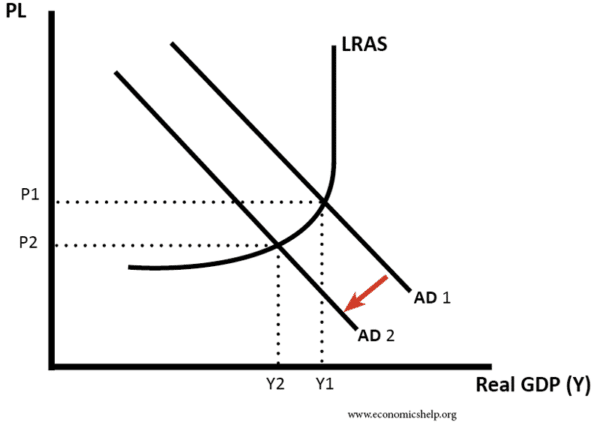
I could have combined 1 or 2 sentences together, but here I wanted to show that short sentences can aid clarity of thought. Nothing is wasted in the above example.
Simple sentences help you to focus on one thing at once, which is another important tip.
3. Answer the question
Quite frequently, when marking economic essays, you see a candidate who has a reasonable knowledge of economics, but unfortunately does not answer the question. Therefore, as a result, they can get zero for a question. It may seem harsh, but if you don’t answer the question, the examiner can’t give any marks.
At the end of each paragraph you can ask yourself; how does this paragraph answer the question? If necessary, you can write a one-sentence summary, which directly answers the question. Don’t wait until the end of the essay to realise you have answered a different question.
Discuss the impact of Euro membership on UK fiscal and monetary policy?
Most students will have revised a question on: “The benefits and costs of the Euro. Therefore, as soon as they see the Euro in the title, they put down all their notes on the benefits and costs of the Euro. However, this question is quite specific; it only wishes to know the impact on fiscal and monetary policy.
The “joke” goes, put 10 economists in a room and you will get 11 different answers. Why? you may ask. The nature of economics is that quite often there is no “right” answer. It is important that we always consider other points of view, and discuss various different, potential outcomes. This is what we mean by evaluation.
Macro-evaluation
- Depends on the state of the economy – full capacity or recession?
- Time lags – it may take 18 months for interest rates to have an effect
- Depends on other variables in the economy . Higher investment could be offset by fall in consumer spending.
- The significance of factors . A fall in exports to the US is only a small proportion of UK AD. However, a recession in Europe is more significant because 50% of UK exports go to EU.
- Consider the impact on all macroeconomic objectives . For example, higher interest rates may reduce inflation, but what about economic growth, unemployment, current account and balance of payments?
- Consider both the supply and demand side . For example, expansionary fiscal policy can help to reduce demand-deficient unemployment, however, it will be ineffective in solving demand-side unemployment (e.g. structural unemployment)
Example question :
The effect of raising interest rates will reduce consumer spending.
- However , if confidence is high, higher interest rates may not actually discourage consumer spending.
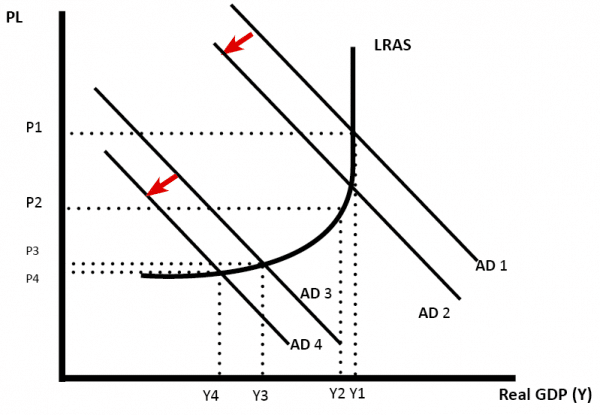
If the economy is close to full capacity a rise in interest rates may reduce inflation but not reduce growth. (AD falls from AD1 to AD2)
- However , if there is already a slowdown in the economy, rising interest rates may cause a recession. (AD3 to AD3)
Micro-evaluation
1. The impact depends on elasticity of demand
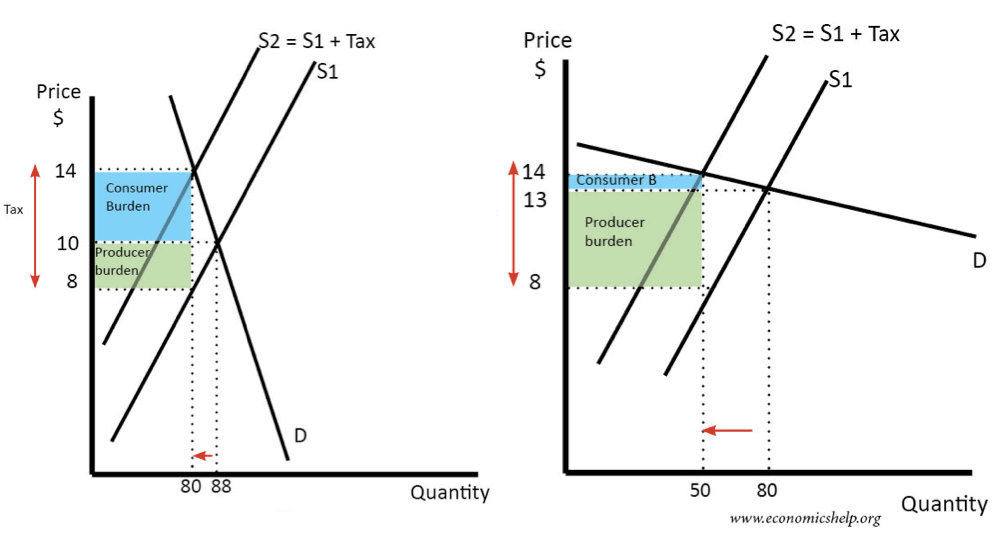
In both diagrams, we place the same tax on the good, causing supply to shift to the left.
- When demand is price inelastic, the tax causes only a small fall in demand.
- If demand is price elastic, the tax causes a bigger percentage fall in demand.
2. Time lag
In the short term, demand for petrol is likely to be price inelastic. However, over time, consumers may find alternatives, e.g. they buy electric cars. In the short-term, investment will not increase capacity, but over time, it may help to increase a firms profitability. Time lags.
3. Depends on market structure
If markets are competitive, then we can expect prices to remain low. However, if a firm has monopoly power, then we can expect higher prices.
4. Depends on business objectives
If a firm is seeking to maximise profits, we can expect prices to rise. However, if a firm is seeking to maximise market share, it may seek to cut prices – even if it means less profit.
5. Behavioural economics
In economics, we usually assume individuals are rational and seeking to maximise their utility. However, in the real world, people are subject to bias and may not meet expectations of classical economic theory. For example, the present-bias suggest consumers will give much higher weighting to present levels of happiness and ignore future costs. This may explain over-consumption of demerit goods and under-consumption of merit goods. See: behavioural economics
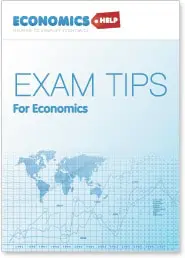
Exam tips for economics – Comprehensive e-book guide for just £5
8 thoughts on “Tips for writing economics essays”
I really want to know the difference between discussion questions and analysis questions and how to answer them in a correct way to get good credit in Economics
Analysis just involves one sided answers while Discussion questions involve using two points of view
This is a great lesson learnd by me
how can I actually manage my time
The evaluation points in this article are really useful! The thing I struggle with is analysis and application. I have all the knowledge and I have learnt the evaluation points like J-curve analysis and marshall learner condition, but my chains of reasoning are not good enough. I will try the shorter sentences recommended in this article.
What kind of method for costing analysis is most suitable for a craft brewery, in order to analyze the cost of production of different types of beer_
Really useful!Especially for the CIE exam papers
Does anyone know how to evaluate in those advantages/disadvantages essay questions where you would basically analyse the benefits of something and then evaluate? Struggling because wouldn’t the evaluation just be the disadvantages ?? Like how would you evaluate without just stating the disadvantage?
Leave a comment Cancel reply
Submissions for Equilibrium are now open! The Semester 2 regular deadline is May 12th, 2024.
Harker Oeconomia
Harvard international economics essay competition, description.
The 2023 Harvard International Economics Essay Contest is sponsored by the Harvard Undergraduate Economics Association (HUEA) in conjunction with the Harvard College Economics Review (HCER). This essay competition is open to high school students of any year and is a fantastic opportunity to demonstrate an accomplished level of writing and understanding of economic theory. Through the contest, student competitors hone their academic and professional skills and exhibit their knowledge to future employers and academic programs. Competitors must construct a convincing argument using economic theory and real-world examples. Winning essays will be published in the Harvard Economics Review and will be available for the greater Harvard community to read. Essays should focus on argumentation supported with facts and references, although data-based support is also welcome.

Wednesday, June 9, 2021
Why deflation is bad.
There are several reasons why deflation is considered to be harmful to the economy.
- Discourage buying. When general prices are falling, consumers tend to delay purchasing. For example, rather than buy a flatscreen today, they wait a year when they will be cheaper. The effect of falling prices is to depress consumer spending leading to lower economic growth.
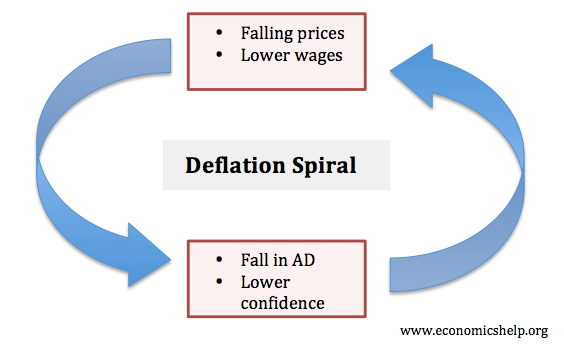
- Monetary Policy Becomes ineffective . With deflation, zero interest rates may be too high. Even quantitative easing may be insufficient to get people spending. ( deflation and monetary policy ) The problem is that it is difficult to cut interest rates below zero and so the monetary authorities cannot adequately deal with the slow growth and deflation.
- Inflation vs Deflation
- Deflationary spiral
- What is more likely inflation or deflation?
- Definition of deflation
Friday, March 20, 2020
How much can the government borrow.
- Historical precedents . In WWII, the OBR said the UK ran a budget deficit of nearly 27% of GDP. By the early 1950s, UK national debt had risen to 240% of GDP. Yet this was not a significant problem. In the post-war period, the UK enjoyed a long period of economic expansion, where debt to GDP ratios fell. In March 2020, UK debt to GDP ratio was around 80% of GDP, so there is significant room for an increase in government debt.
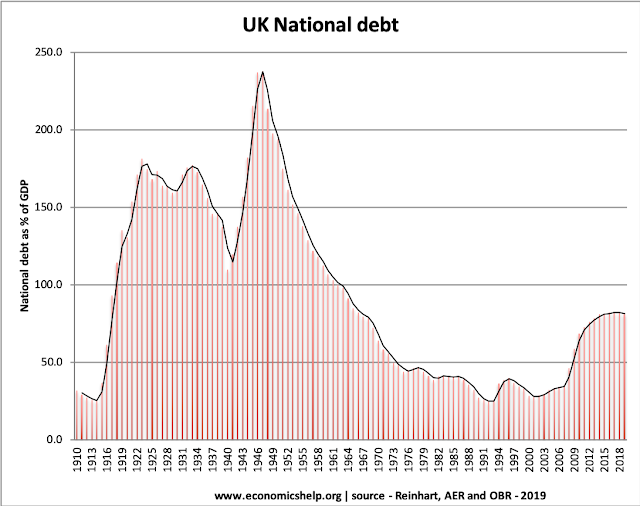
- Government's have the ability to create money . Some economists (especially those believing in MMT ) argue the only constraint to government borrowing is inflation. In other words, higher government spending financed by printing money is only a problem when it causes inflation. In a severely depressed economy, with inflation falling (and possibly deflation) it maybe desirable for the government to create money and target a positive inflation rate. In 2009/10 recession, US and UK financed some borrowing through quantitative easing .
- In a recession , most economists accept that a rise in government borrowing is necessary to offset the fall in private sector investment and spending. Keynesian economics says expansionary fiscal policy can help an economy recover. But austerity (cutting spending) can make the recession worse, worsening tax revenues and be counter-productive in cutting borrowing.
- During a period of economic growth when the economy is close to full capacity, government borrowing can cause many problems such as crowding out of the private sector, pushing up interest rates, and possible inflationary pressures.
- Does it print its own currency?
- Do markets trust the government to maintain low inflation and not default?
- What are the interest rate on government bonds?
- What is the state of the economy?
- What is the purpose of government borrowing?
- To what extent is the government borrowing from domestic or foreign investors?
Levels of government debt
- US 117% of GDP in 1945 (gross federal debt (1)
- UK 240% of GDP in the early 1950s
- Japan has national debt over 230% GDP
How does the government finance its debt?
- Selling government bonds to the private sector - either domestic or foreign. The private sector buy bonds because the security and interest rate on them.
- The Central Bank can finance shortfall in revenue by increasing the money supply and buying bonds itself. This is sometimes known as quantitative easing.
Factors which influence how much a government can borrow
- Domestic savings. If consumers have a high savings ratio, there will be a greater ability for the private sector to buy bonds. Japan has very high levels of public sector debt, but with high domestic savings, there has been a willingness by the private sector to buy the government debt. Similarly, during the Second World War, the government was able to tap into the high levels of domestic savings to finance UK debt.
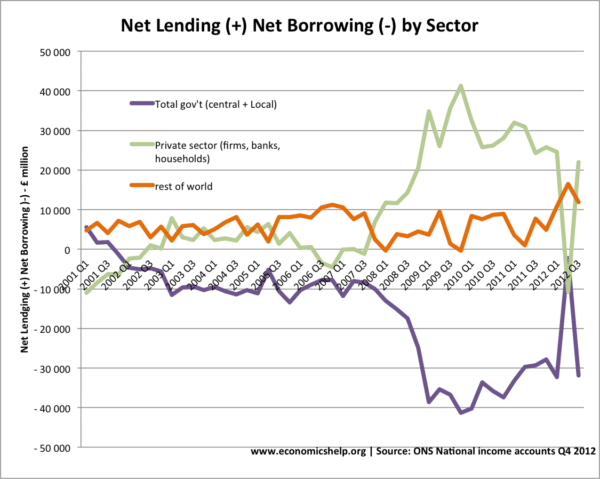
- In a depression, we tend to see a rise in private sector saving (the paradox of thrift) because households fear being made unemployed and firms don't want to invest. Therefore, in a recession, there is often surplus private sector savings. A surplus of unused savings means there is an advantage for the government to borrow, invest, create jobs and make use of these surplus savings. As Greg Mankiw said in March 2020. "There are times to worry about the growing government debt. This is not one of them."
- Relative interest rates. If government bonds pay a relatively high-interest rate compared to other investments, then ceteris paribus , it should be easier for the government to borrow. Sometimes, the government can borrow large amounts, even with low-interest rates because government bonds are seen as more attractive than other investments. (e.g. in a recession government bonds are often preferred to buying shares (which are more vulnerable in a recession). This is why US bond yields fell 2008-11, despite growth in US government borrowing.
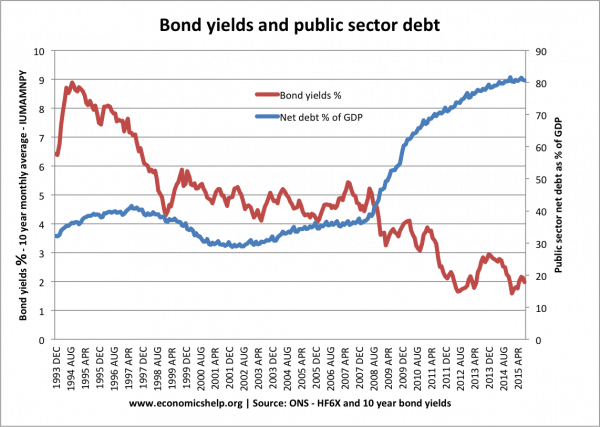
- Lender of last resort . If a country has a Central Bank willing to buy bonds in case of liquidity shortages, investors are less likely to fear a liquidity shortage. If there is no lender of last resort (e.g. in the Euro during 2011/12) then markets have a greater fear of liquidity shortages and so are more reluctant to buy bonds.
- Confidence and security. Usually, governments are seen as a safe investment. Many governments have never defaulted on debt payments so people are willing to buy bonds because at least they are safe. However, if investors feel a government is too stretched and could default, then it will be more difficult to borrow. Therefore, some countries like Argentina with bad credit histories would find it more difficult to borrow more. Political uncertainty can make investors more concerned.
- Foreign Purchase . A country like the US attracts substantial foreign buyers for its debt (Japan, China, UK). This foreign demand makes it easier for the government to borrow. However, if investors feared a country could experience inflation and a rapid devaluation, foreigners would not want to hold securities in that country and it could lead to capital withdrawal.
- Inflation. Financing the debt by increasing the money supply is risky because of the inflationary effect. Inflation reduces the real value of the government debt, but, that means people will be less willing to hold government bonds. Inflation will require higher interest rates to attract people to keep bonds. In theory, the government can print money to reduce the real value of debt; but existing savers will lose out. If the government creates inflation, it will be more difficult to attract savings in the future. A crucial factor is whether inflation is likely. In a recession, inflationary pressures vanish so it is much easier to finance a deficit by borrowing.
Why did Eurozone countries experience more debt problems than UK and US in 2012?
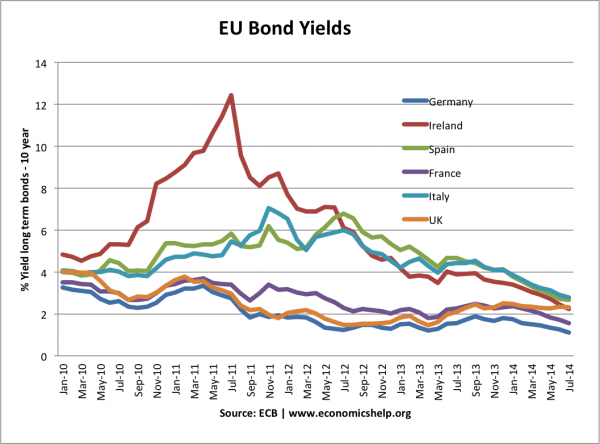
- EU debt crisis explained
- National debt UK
Wednesday, March 11, 2020
Paradox of thrift.
- The paradox of thrift is a concept that if many individuals decide to increase their private saving rates, it can lead to a fall in general consumption and lower output.
- Therefore, although it might make sense for an individual to save more, a rapid rise in national private savings can harm economic activity and be damaging to the overall economy.
- In a recession, we often see this 'paradox of thrift'. Faced with the prospect of recession and unemployment, people take the reasonable step to increase their personal saving and cut back on spending. However, this fall in consumer spending leads to a decrease in aggregate demand and therefore lower economic growth.
Paradox of thrift during 2020 corona recession
- In 2020, the economic shutdown will lead to an unprecedented rise in savings. Partly because people are very nervous about the future economy but also because opportunities to spend are severely limited.
- On the other hand, people who see a large fall in income will have to dip into their savings and borrow to stay afloat.
Paradox of thrift during 2009 Recession
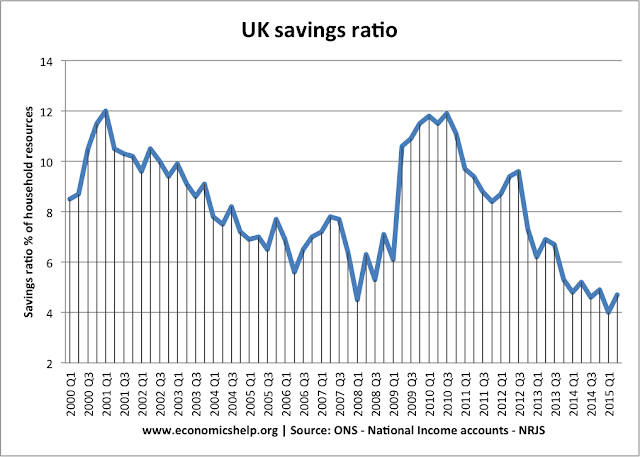
Paradox of Thrift in 1930s
Keynes and paradox of thrift.

Who coined the term paradox of thrift?
"For although the amount of his own saving is unlikely to have any significant influence on his own income, the reactions of the amount of his consumption on the incomes of others makes it impossible for all individuals simultaneously to save any given sums. Every such attempt to save more by reducing consumption will so affect incomes that the attempt necessarily defeats itself. It is, of course, just as impossible for the community as a whole to save less than the amount of current investment, since the attempt to do so will necessarily raise incomes to a level at which the sums which individuals choose to save add up to a figure exactly equal to the amount of investment. — John Maynard Keynes, The General Theory of Employment, Interest and Money , Chapter 7, p. 84
"Had the whole population been alike bent on saving, the total saved would positively have been much less, inasmuch as (other tendencies remaining the same) industrial paralysis would have been reached sooner or oftener, profits would be less, interest much lower, and earnings smaller and more precarious. This ... is no idle paradox, but the strictest economic truth." — John M. Robertson, The Fallacy of Saving , pp. 131–132
Paradox of thrift and government borrowing
Criticisms of paradox of thrift.
- Higher saving increases bank balances and can lead to an increase in bank lending - and hence investment.
- A fall in demand from higher saving, will cause lower prices, which encourage demand to increase. This is related to Say's Law which states supply creates its own demand.
- Higher domestic savings can lead to lower domestic inflation and therefore increase exports. Higher exports can boost demand.
Responding to criticisms
- In a recession, banks may not want to lend, and even if banks do want to lend, firms do not want to borrow and invest. In fact, in a recession, firms may do the same as consumers and try to save more and pay back dent.
- Prices may be sticky downwards and not fall, even if there is lower demand. Also, if prices fall, deflation can discourage spending because real value of debt rises.
- Not every country can 'export' its way out of a recession.
- Impact of expansionary fiscal policy
Friday, June 14, 2019
Understanding uk housing market.

- House prices are volatile with frequent booms and busts.
- Despite volatility, and even adjusted for inflation - UK house prices have been on a strong upward trend since the 1930s.
Main factors affecting house prices
- Supply. UK house prices have stayed relatively high (despite recession and credit crunch) because of a shortage of supply. Ireland and Spain have seen much bigger house price falls because they have large excess supply.
- Interest rates. The UK housing market is sensitive to changes in interest rates. Higher interest rates in the early 1990s made mortgages unaffordable and caused a big drop in house prices.
- Economy / unemployment. A recession and rising unemployment usually causes lower demand for buying houses and a fall in price. (falling house prices also tend to deepen the recession)
- Mortgage availability. In the boom years of 2000-07, banks were keen to lend and they relaxed their lending criteria, enabling more people to get a mortgage. But, the credit crunch meant banks had to tighten their lending criteria making mortgages difficult to get (even though interest rates were low)
- see more at: factors affecting housing market
Why are UK house prices so volatile?
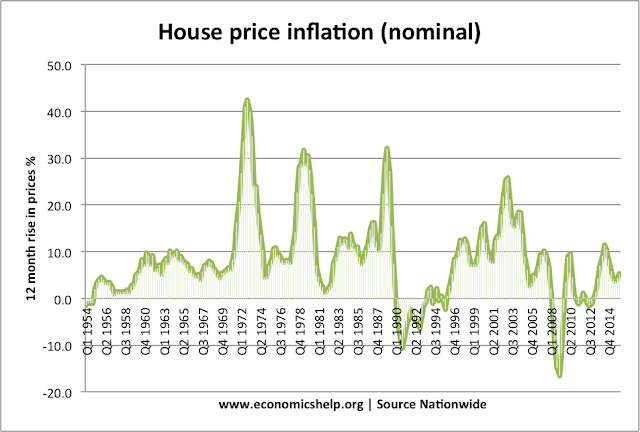
- Inelastic supply. It takes time to build houses - with rising demand, supply often can't keep up. This pushes prices up.
- Change in credit conditions. Mortgage availability can vary depending on the state of the banks and financial markets.
- Changing interest rates. Interest rates are used to control inflation, but a rise in interest rates has a big effect on demand and affordability.
- Changes in confidence. In the boom years, we see landlords buying to let and demand rises. When prices fall, people don't want to buy for fear of negative equity.
Why are UK house prices so expensive?

Housing market crashes
How does the housing market affect the rest of the economy, government intervention in the housing market.
- Increasing supply to overcome fundamental shortage.
- Protecting green belt land
- Ensuring minimum standards of house building and ensuring tenants get a fair deal
- Seeking to avoid house price volatility.
- Market failure in housing
- Cause of falling house prices
- Latest stats and graphs on the housing market
- Problems of UK housing market
- Impact of falling house prices
Monday, May 13, 2019
Advantages and disadvantages of trades unions.
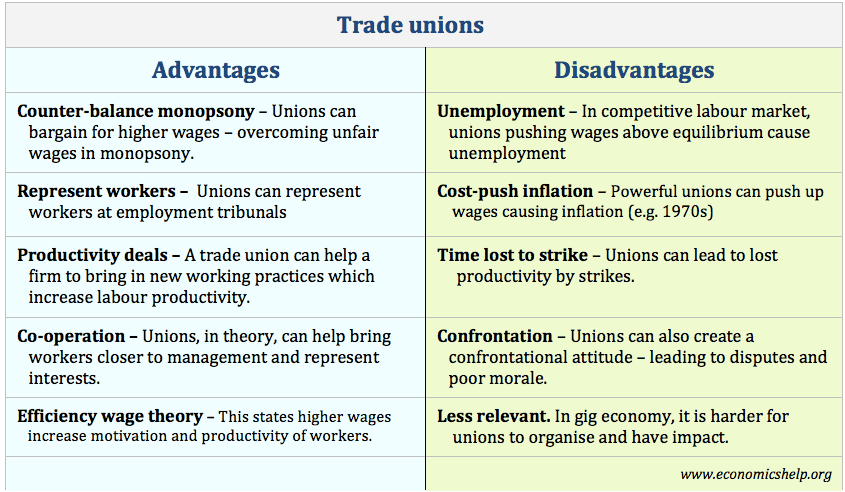
Advantages of Trades Unions
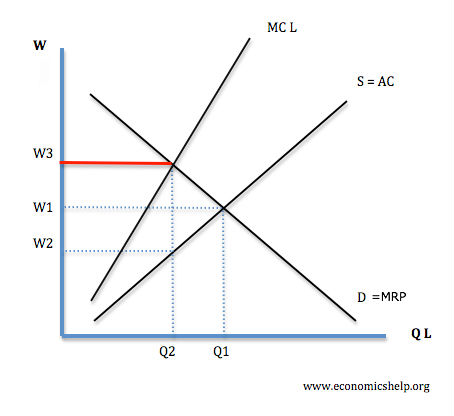
Potential disadvantage of Trades Unions
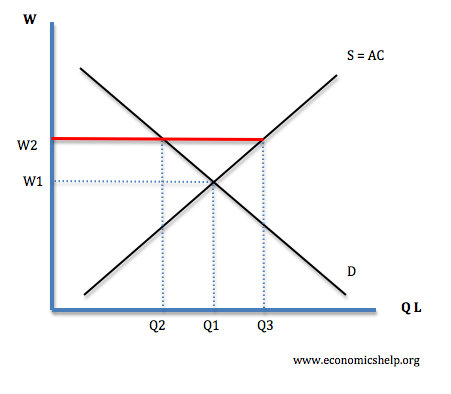
- The UK economy under Mrs Thatcher 1979-1984
- Trade Unions
Friday, March 8, 2019
7 common economic fallacies.
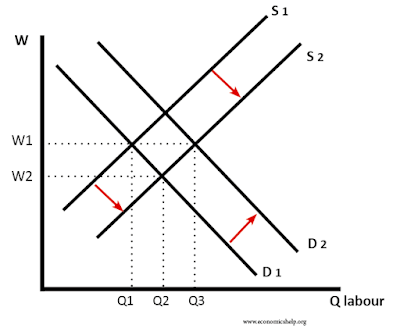
- Immigrants increase the supply of labour but they also increase aggregate demand in the Economy. This means that they buy more goods and create additional demand in the economy. They provide labour supply and increase labour demand.
- If immigration caused unemployment why did America not have high unemployment during times of mass immigration? Because the immigrants created as many jobs as they took.
- Often immigrants take jobs that native workers just don’t want to do. – You won’t see big multinationals cueing up to stop immigration.
- Furthermore, immigrants tend to be of working age. Therefore they tend to contribute more tax than receive in benefits. Without immigration, US demographics would have a larger % of dependent old people.
- War does create more output, but only in some industries related to war. Arms manufacturers do very well out of the war. But the total output of the economy doesn’t increase instead there is a change in economic priorities. Resources are diverted from peaceful industries to industries for creating the mechanisms of war. This is similar to the broken window fallacy.
- If a butcher's window is smashed, the window repairer sees new work. He gains more income. But, the broken window hasn't increased economic welfare. It just means the butcher has to spend money repairing a window rather than investing in a bigger premise.
- Increase in government spending for wars create either taxes and or higher debt payments. This is a burden on current and future taxpayers. Note The UK is still paying off debt from second world war.
- Ronald Reagan’s economic advisers told him something along the lines of “cut taxes” and you can increase total tax income. This theory is based on the laffer curve which states that if taxes are 100% people won’t work. Therefore if you cut taxes more people work and you can increase tax revenue. This is based on the Laffer Curve.
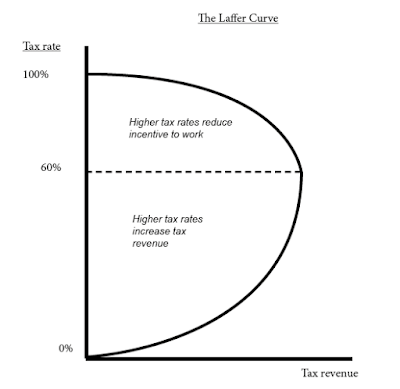
- The problem is that this may work if you cut taxes from 95% to 90%. But when you cut income tax from 25% to 23% it doesn’t make any difference.
- Some people want a target income of say £20,000. Thus if taxes fall they can earn the same by working less. Empirical evidence suggests there is little if any supply-side incentive for cutting US or UK tax rates.
- The instinctive reaction of politicians is that if one country places a tariff barrier on our exports, we should respond by doing the same. However economic theory suggests that placing a tariff barrier on imports leads to a loss of economic welfare. It is better to not retaliate.
- Retaliation may help one small domestic industry, but it causes costs to all consumers in the form of higher prices. There is a net welfare loss, that is not recovered by some domestic industries gaining benefit.
- Another justification given for cutting income tax is that it will increase aggregate demand and hence increase economic growth. However this is not always true because:
- If you cut income tax for high-income earners, they are likely to save a high % of their extra disposable income. Their marginal propensity to consume is low.
- If you cut income tax the government has to either cut government spending or borrow. If the government has to borrow from the private sector then they will have less income to spend causing a decline in private sector spending. This is called crowding out.
- (Although there are certain times when a government deficit can boost AD - like in a recession.)
- The broken window fallacy
- The Luddite Fallacy
- Lump of labour fallacy
- Some misconceptions about how the economy works
Monday, May 7, 2018
Problems with the euro.
- A single currency within the Eurozone area.
- A common monetary policy. Interest Rates are set by the ECB for the whole Eurozone area.
- Growth and Stability Pact. In theory there are limits on government borrowing, national debt and fiscal policy. However, in practice member countries have often violated the strict limits on government borrowing.
Problems and costs of the Euro
- Interest rates not suitable for whole Eurozone . A common monetary policy involves a common interest rate for the whole eurozone area. However, the interest rate set by the ECB may be inappropriate for regions which are growing much faster or much slower than the Eurozone average. For example, in 2011, the ECB increased interest rates because of fears of inflation in Germany. However, in 2011, southern Eurozone members were heading for recession due to austerity packages. The higher interest rates set by the ECB were unsuitable for countries such as Portugal, Greece and Italy.
- The Euro is not an optimal currency area . If a state in the US, such as New York ,was in recession, workers in New York could move to New England and get a job. However, in the Eurozone this is much more difficult; it involves moving country and possibly learning a new language. There are more barriers to the movement of labour and capital within a diverse region like Europe. Therefore, an unemployed Greek can't easily relocate to Germany. see: Two Speed Europe
- Limits Fiscal Policy . With a common monetary policy it is important to have similar levels of national debt, otherwise countries may struggle to attract enough buyers of national debt. This is a growing problem for many Mediterranean countries like Italy, Greece and Spain who have large national debts and rising bond yields.
- Lack of Incentives . It is argued that being a member of the Euro protects a country from a currency crisis. Therefore, there is less incentive for countries to implement structural reform and fiscal responsibility. For example, in good years Greece was able to benefit from very low bond yields on its debt because people felt Greek debt would be secured by rest of Europe. But, this wasn't the case, and Greece were lulled into a fall sense of security.
- No scope for devaluation . Since the start of the Euro, several countries have experienced rising labour costs. This has made their exports uncompetitive. Usually, their currency would devalue to restore competitiveness. However, in the Euro, you can't devalue and you are stuck with uncompetitive exports. This has led to record current account deficits, a fall in exports and low growth. This has particularly been a problem for countries like Portugal, Italy and Greece.

- No Lender of Last Resort . The ECB is unwilling to buy government bonds if there is a temporary liquidity shortage. This makes markets more nervous about holding debt from eurozone economies and precipitates fiscal crisis. See: Problems of Italy - why Italian bonds increased despite having a much lower budget deficit than UK.
- However it is worth noting that since Mario Draghi took over and promised to 'do whatever it takes, the ECB has effectively acted as lender of last resort.
- Deflationary Bias I would argue there is a deflationary bias in the Eurozone which increases the risk of recession and higher unemployment
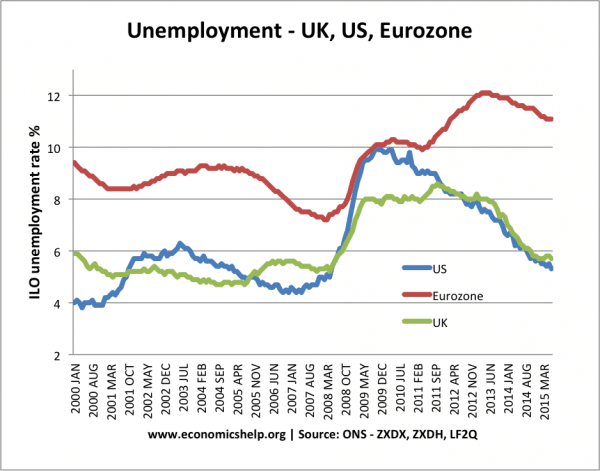
- Divergence in bank rates . In theory, the Eurzone creates a common interest rate. However, in the credit crisis of 2010-13, we see rising bank rates for peripheral Eurozone countries, like Italy and Spain. Small and medium sized firms faced higher borrowing costs than in 2005, even though the ECB cut the main base rate. This suggests that the ECB was unable to loosen monetary policy when needed. See more on credit policy
- Asymmetric Shocks . If one country experienced an external shock it might need a different response. But this is not possible with a common currency. E.g. German reunification required higher interest rates in order to help reduce inflation but this was not good for many other countries.
- An oil shock would affect net importers like France more than Norway and the UK who export a lot. Monetary Policy will have different effects in different countries. For example, the UK is sensitive to changes in the interest rate because many people have mortgages.
Problems for UK Economy
- Housing market. Many in the UK have a mortgage which is a big % of their disposable income. This is related to the high cost of buying houses in the UK.
- Variable Mortgages In the UK more homeowners have variable mortgages. These two factors means UK consumers are very sensitive to changes in the base rate. If the ECB kept interest rates higher than the UK needed it would create serious problems in the UK. Arguably to join the UK would need to reform its housing market and reliance on variable mortgages.
- Why it's very hard to leave Euro
- European fiscal crisis
- Benefits of Joining the Euro
- Danger Ahead for Mighty Euro at Economist
Tuesday, April 3, 2018
Predictions for the dollar as the reserve currency.

Will the Euro Replace the Dollar as the World’s Reserve Currency?
- Since 1999, the Dollar’s share of the world’s currency reserves have fallen from 70.9% to 64%
- In the same period, the Euro has increased from 17.9% to 25.8%
- (the 3rd biggest reserve currency is the Pound sterling 4%
- (the 4th biggest reserve currency is the Japanese Yen 2.8%)
Why the Euro May soon Replace the Dollar
- The Dollar has been very weak in the past 8 years. Against the Euro, the Dollar has fallen by over 30% since 2001. The Dollar has also fallen against the Yen and other currencies. This means that countries holding reserves in dollars are seeing a decline in their value. For example, China has over $1,400 billion of dollar reserves. A 20% devaluation represents a significant loss for them. Therefore, the rational step is to diversify out of the dollar.
- Countries dropping the Dollar Peg . Many middle eastern Countries such as Saudi Arabia, Kuwait and Syria used to maintain a dollar peg. However, there are signs that they no longer want to keep a peg against a devaluing dollar. Kuwait and Syria have dropped their peg and Saudi Arabia recently decided not to follow the US in cutting interest rates.
- Dollar’s weakness may continue. The US economy is continuing to slow down as it remains hard hit by the housing slump. US interest rates have fallen and may continue to fall by more than the Eurozone. As interest rates in the US are low it becomes less attractive to buy US dollars so the devaluation will continue.
- US Trade Deficit (current account deficit of 5%). In recent years, the US has built up a large current account deficit. This has caused an outflow of currency and is a factor in maintaining the weakness of the dollar. (although the recent devaluation though has helped reduce the deficit from over 6% to 4.7%)
- The Euro is a real alternative . The Euro economy is now as large as the US. The Euro may also be seen as more politically desirable. European countries were less willing to get involved in Iraq and many accuse the US of an ‘imperial overreach’ with too many foreign bases and interference around the world. The European Union, by contrast, provides greater diversity and is politically more attractive, especially to middle eastern countries.
- Better inflation performance of the Eurozone to the US. There was a marked contrast in response to the recent credit crisis. The US slashed rates to 2.25%, the ECB barely cut rates at all. The lower rates and devaluation of the dollar makes future inflation in the US more likely, this will only make the US less attractive.
- Effects of a falling dollar
- Why do foreigners hold US dollars?
- Will the Euro Replace the Dollar at Economist's view
- Why the Euro will soon replace the dollar as the world's reserve currency
Wednesday, November 1, 2017
Importance of economic growth, why economic growth is important.

- Reduction in poverty . Increased national output means households can enjoy more goods and services. For countries with significant levels of poverty, economic growth can enable vastly improved living standards. For example, in the nineteenth century, absolute poverty was widespread in Europe, a century of economic growth has lifted nearly everyone out of this state of poverty. Economic growth is particularly important in developing economies.
- Reduced Unemployment . A stagnant economy leads to higher rates of unemployment and the consequent social misery. Economic growth leads to higher demand and firms are likely to increase employment.
- Improved public services . Higher economic growth leads to higher tax revenues (even with tax rates staying the same). With higher growth, incomes and profit, the government will receive more income tax, corporation tax and expenditure taxes. The government can then spend more on public services.

- Political aspect . Elected politicians have a vested interest in higher economic growth. Higher growth enables vote pleasing policies such as tax cuts and/or more public spending.
Virtuous cycle of economic growth
- Countries with positive rates of economic growth will create a virtuous cycle
- Economic growth will encourage inward investment as firms seek to benefit from rising demand
- Higher growth leads to improved tax revenues which can be spent on long-term public sector works, such as improved transport and communication. This helps long-term growth.
- Confidence to invest. Higher growth encourages firms to take risks - innovate and invest in future products and productive capacity.
Limitations of economic growth
- Inequality and distribution . Economic growth doesn't necessarily reduce relative poverty, it depends on the distribution of incomes. Economic growth could bypass the poorest in society. For example in the 1980s, the Gini coefficient rose sharply - the richest 1% gained dis proportionality more.
- Negative externalities . Economic growth can cause negative externalities such as pollution, higher crime rates and congestion which actually reduce living standards. For example, China has experienced very rapid economic growth but is now experience very serious levels of air pollution in major cities.
- Economic growth may conflict with the environment . e.g. increased carbon production is leading to global warming. Economic growth may bring benefits in the short-term, but costs in the long-term.
- It depends on what is produced . The Soviet Union has fantastic rates of economic growth, but, often through producing a lot of steel and pig iron that was not actually very useful.
- Economic growth can be unsustainable . If growth is too rapid, it will cause inflation, current account deficit and can lead to boom and bust.
- Does happiness actually increase? Theories of hedonistic relativism suggest (beyond a certain level) increasing output has no effect on changing life quality or happiness.
- Causes of Economic Growth
- Benefits of economic growth
The Importance of Economics
Saturday, october 21, 2017, wednesday, october 11, 2017, interest rates explained.

Effect of an Increase in Interest Rates
- Cost of borrowing is more expensive. If borrowing is more expensive consumers will take out fewer loans. Firms will borrow less. Therefore consumer spending and investment will fall (or increase at slower rates)
- Mortgage and loan repayments increase. This reduces consumer disposable income and consumer spending further.
- Return on savings increase. More attractive to save and this will reduce consumer spending
- Higher interest rates cause an appreciation in the exchange rate due to hot money flows. (It is more attractive to save in the UK, if UK interest rates are higher than other countries)
- An appreciation in the exchange rate makes more expensive, leading to less export demand
- Fall in asset prices. Higher interest rates can make it less attractive to buy a house with a mortgage leading to lower house prices.

Macro effects
- If consumer spending and investment falls, this will lead to lower AD. Therefore this causes a fall in Real GDP or at least a fall in the rate of economic growth.
- Lower growth will tend to increase unemployment. With less output, firms demand less workers.
- Lower growth will also help to reduce inflation.

How does Bank of England decide whether to increase interest rates?
- Inflation target of 2%. But Bank has to consider other objectives such as
- economic growth and inflation.
- It also has to consider the type of inflation. Is it temporary cost-push inflation or underlying inflationary pressures.
- Is the economy reaching full capacity?
Example of interest rate dilemma Nov 2017
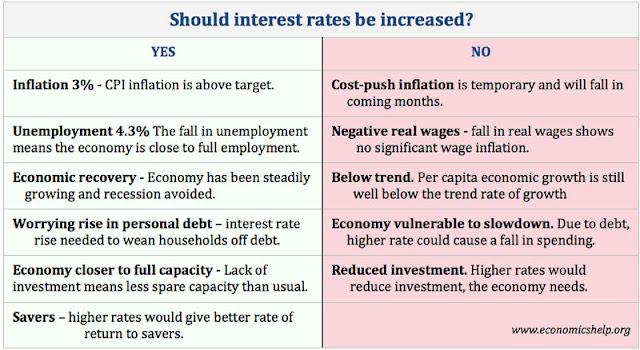
Real interest rates

- Interest rates and the economy
- Essay on Effects of Rising interest rates
- Interest Rate Swaps explained
Thursday, October 5, 2017
The economy of the 1970s.
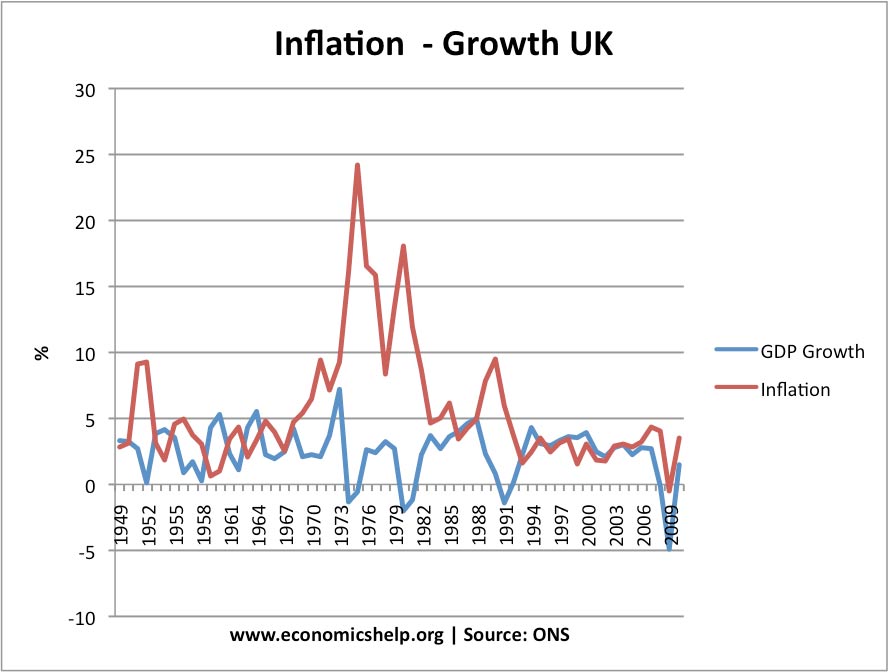
Barber Boom 1970-73
- The Bank of England deregulated the mortgage market - meaning High Street Banks could now lend mortgages (not just local building societies). This helped fuel a rise in house prices and consumer wealth.
- Barber Boom of 1972. In the 1972 budget, the chancellor Anthony Barber made a dash for growth - with large tax cuts against a backdrop of high economic growth.
- Growth of Credit. It was in the 1970s, we saw the first mass use of credit cards (Access). This helped create a consumer bubble.
Inflation Crisis
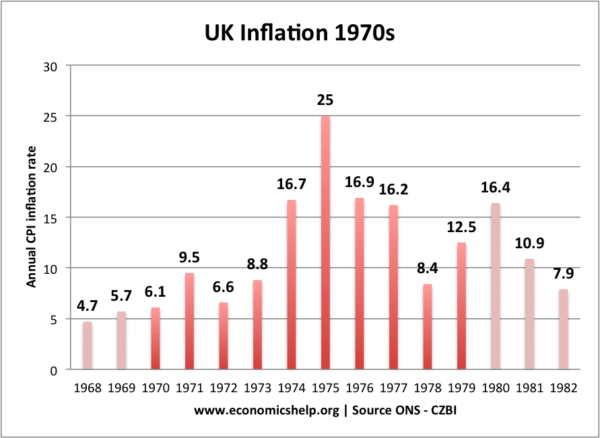
- Rising wages, partly due to strength of unions.
- The inflationary budget of 1972.
- Growth in credit and consumer spending.
- Oil price shock of 1973, leading to 70% increase in oil prices.
Trying to deal with inflation
- blue line - nominal oil prices
- Yellow line - Real oil prices, adjusted for inflation
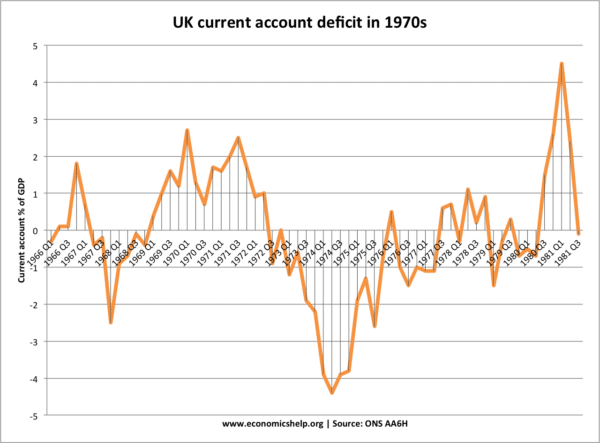
1976 IMF Bailout
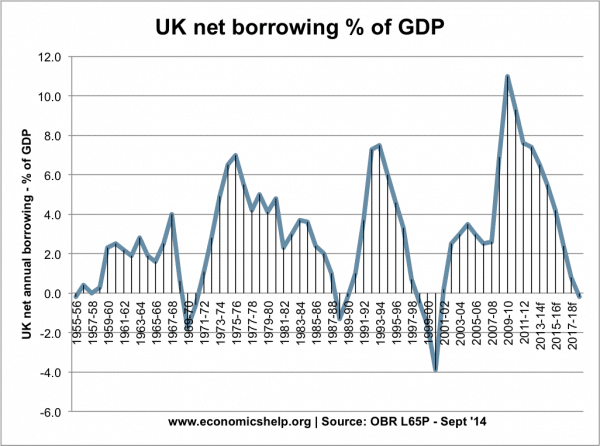
Saturday, June 17, 2017
- What to produce? - Is it worth spending more on health care?
- How to produce? - Should we leave it to market forces or implement government regulations.
- For whom to produce? - How should we distribute resources, should we place higher income tax on the wealthiest in society?
- Policies to reduce unemployment
- Policies to reduce inflation
- The over production of negative externalities (e.g. pollution/congestion)
- The underproduction of goods with positive externalities (e.g. education, health care, public transport).
- Non-provision of Public Goods - (national defence, law and order)
- Tax negative externalities
- Subsidise public services like health care and education.
- Carbon Tax - should we implement a carbon tax to reduce global warming?
- Should we tax fatty foods?
- Efficiency v equality
- GDP and Happiness
- Economics - The Dismal Science
- How to deal/combat global warming?
- Does globalisation help or hinder developing countries?
- How to live in a society without oil?

Harvard International Economics
Essay contest (hieec).
HIEEC provides students the opportunity to demonstrate an accomplished level of writing and understanding of economic theory. Through the contest, students hone their academic and professional skills and exhibit their knowledge.
HIEE C 202 3 -2024
Hieec 2023-2024 is now closed. .
The 2023-2024 Harvard International Economics Essay Contest is sponsored by the Harvard Undergraduate Economics Association (HUEA). This essay competition is open to high school studen ts of any year and is a fantastic opportunity to demonstrat e an accom plished level of writing and understanding of economic the ory. T hrough the contest, student competitors hone their academic and professional skills and exhibit their knowledge to future employers and academic programs.
Competitors must construct a convincing argument using economic theory and real-world examples. Winning essays will be published on our website and will be available for the greater Harvard community to read. Essays should focus on argumentation supported with facts and references, although data-based support is also welcome.
Yiheng Lyu
Audrey Ku k
Hyoungjin Jin
Juyoung Chun
Kevin Zhang
Matthew Choi
Mikayil Sadikhov
Raunak Agarwal
Vallabh Himakunthala
Highly Commended
Aronima Biswas
Aryan Nangia
Kridaya Gupta
Leonardo Jia
Rohan Mathur
Anagha Chakravarti
Amberlynn Gong
Neha Shanavas
Donghyeon Oh
2023-2024 Essay Questions
Advances in artificial intelligence (AI) have the potential to affect growth, inequality, productivity, innovation, and employment. OpenAI’s ChatGPT, in particular, has greatly increased public awareness about the significance of AI and its implications for the future. What impact will the development of AI have on economic inequality, the composition of the workforce, and economic output as a whole? How can nations prepare for the micro and macroeconomic changes brought about by AI?
Measuring national and global economic activity allows us to understand how economies change in size and structure—how they grow and contract. In addition to Gross Domestic Product (GDP), government budgets, and the money supply, alternatives like the Human Development Index (HDI) and Gross National Income (GNI) are used to assess economic progress. What are the advantages of our current economic indices, including GDP, HDI, GNI, government budgets, and the money supply, and in what areas are they lacking? Which of these indices do you find most helpful, and how can we enhance or combine them to improve our understanding of economic measurement?
Proponents of income redistribution support the idea that redistribution policies will increase economic stability and give more opportunities to the less wealthy. Others, however, are more skeptical and believe it could have negative consequences for economic growth. Current methods of redistribution include taxation, welfare, public services, and other monetary policies. What strategies for income redistribution should the U.S. adopt from other countries? What economic impacts could a wealth tax or super millionaire tax have? What type of redistribution is most effective and feasible? What would be the impacts of the U.S. enacting universal basic income? Discuss the implications of any of these issues and feel free to expand on other areas of economic redistribution.
As the United States weighs the impacts of China’s rise to global prominence, economics and national security have become increasingly intertwined. As a result, the United States government has imposed both tariffs and investment restrictions on China to limit the nation’s access to both US markets and intellectual property (specifically in sensitive industries such as semiconductors). What are the economic implications of these policies for United States firms, consumers, and workers? Discuss the most important perspectives of the US-China trade war and provide suggestions on how both countries can manage the prospect of a changing economic order.
2nd November 2023 – Essay titles released
11:59pm EST 5th January 2024 – Essay submission deadline
Late February 2024* – Highly Commended and Finalists notified
Early March 2024 * – Winners notified, results published on the website
*We received a high volume of submissions, therefore we anticipate that it will take us a couple m ore w eeks to release the results.
Entrants must choose one of the four prompts and write a response to it with a strict limit of 1500 words. Submission must be via the HUEA website and entrants are limited to submitting one essay with only the first submission being considered. Each essay submission will have a $20 reading fee which should be paid upon submission of the essay. If this fee will impose a significant financial burden on your family, please email us. The deadline for submitting the essay is 11:59pm EST January 5th, 2024.
Please submit essay submissions via this form.
If the above link does not work, use: https://forms.gle/9NVDu9WVbU71iPpq6
*Be sure to read all the details in the submission form carefully before submitting, as failure to complete any of the steps correctly may result in your submission not being considered.
The essays will be judged by the board of the HUEA, with the top 10 submissions being adjudicated by the esteemed Harvard professor and 2016 Economics Nobel Prize winner Oliver Hart.
The top three winning essays will be published ( with the author’s permission) on our website. A finalist s list of the top submissions will be published online and adjudicated by 2016 Economics Nobel Prize Winner Oliver Hart. A list of names that will receive the "Highly Commended" distinction will also be published online. The judges' decisions are final.
Terms and Conditions
The word limit of 1500 must be strictly adhered to. Any words past the limit will be truncated. This limit excludes references, footnotes, titles, headers and footers.
Essays must be written only by the entrant. Any outside assistance must be declared in the beginning or end of the essay.
Only your first submission will be accepted. Any further submissions will not be read.
References must be included, and any plagiarism will lead to disqualification.
References must be in Chicago or APA format.
The only accepted document formatting is PDF. Any other format will not be accepted, nor will refunds be given to those who do not follow this rule.
No refunds are granted.
Grades 9-12 are permitted.
The essay must not be entered in any other competition nor be published elsewhere.
No individual feedback of essays will be granted.
The decisions made by HUEA by the final round of adjudication are final.
All winners agree to their names being published on the HUEA website.
Past Winners
2022 prompts an d winners.
In recent years and decades, many countries have seen fertility rates drop, potentially leading to falling populations. Currently, China has a fertility rate of 1.3, one of the lowest in the world. However, in 2021, China experienced GDP growth of 8% with output totaling $17.7 trillion. Will this lowered fertility rate (with potential to fall further) affect China’s economic growth and policy? How so? What, if anything, can the Chinese government do to limit the risk of falling fertility rates?
U.S. mortgage rates recently passed 7%, making the purchase of a new home increasingly unaffordable. Meanwhile, the United States has suffered from a chronic shortage of available housing for decades, particularly in urban areas, leading to what many scholars and advocates call an affordability crisis. Why is housing so unaffordable in the U.S.? What can (or should) be done by private actors, state and local governments, and the federal government to alleviate the affordability crisis?
It is often suggested that a tradeoff exists between economic growth and the health of the environment, especially now as the threat of climate change becomes more dire. What economic risks does a changing climate pose? Can economic growth be consistent with a healthy environment? What policies, either market-based or otherwise, should governments enact to protect the environment while posing the least danger to economic efficiency?
Central banks such as the Federal Reserve in the U.S. and the Bank of England in the UK manage their nation’s macroeconomies with the goal of ensuring price stability and maximum employment. Globally, inflation rates are rising to levels not seen since the 1980s, particularly in the U.S. and European countries. To what extent should the monetary policies of central banks in various Western countries differ or resemble one another as a reaction to the specific causes of inflation facing their economies?
Click below to view each winner's essay
Ashwin t elang * nanxi jiang * duncan wong, 2019 wi n ner.
https://www.economicsreview.org/post/when-is-one-choice-one-t oo-many
2020 Winners
https://www.economicsreview.org/post/covid-19-and-the-market
https://www.economicsreview.org/post/automation-and-jobs-this-time-is-different
https://www.economicsreview.org/post/making-rational-decisions

+1 (603) 932 7897

Harvard International Economics Essay Contest (HIEEC)
- Last modified 2023-12-01
- Published on 2021-05-14
Competition Details
Introduction : The Harvard Undergraduate Economics Association (HUEA) is organizing its flagship Harvard International Economics Essay Contest with the collaboration of the Harvard College Economics Review. We jointly organize the Essay competition with HUEA, and we also publish the top three essays in our online publications. HIEEC provides students the opportunity to demonstrate an accomplished level of writing and understanding of economic theory. Through the contest, students hone their academic and professional skills and exhibit their knowledge.
2023-2024 Harvard International Economics Essay Contest Topic:
Advances in artificial intelligence (AI) have the potential to affect growth, inequality, productivity, innovation, and employment. OpenAI’s ChatGPT, in particular, has greatly increased public awareness about the significance of AI and its implications for the future. What impact will the development of AI have on economic inequality, the composition of the workforce, and economic output as a whole? How can nations prepare for the micro and macroeconomic changes brought about by AI?
Measuring national and global economic activity allows us to understand how economies change in size and structure—how they grow and contract. In addition to Gross Domestic Product (GDP), government budgets, and the money supply, alternatives like the Human Development Index (HDI) and Gross National Income (GNI) are used to assess economic progress. What are the advantages of our current economic indices, including GDP, HDI, GNI, government budgets, and the money supply, and in what areas are they lacking? Which of these indices do you find most helpful, and how can we enhance or combine them to improve our understanding of economic measurement?
Proponents of income redistribution support the idea that redistribution policies will increase economic stability and give more opportunities to the less wealthy. Others, however, are more skeptical and believe it could have negative consequences for economic growth. Current methods of redistribution include taxation, welfare, public services, and other monetary policies. What strategies for income redistribution should the U.S. adopt from other countries? What economic impacts could a wealth tax or super millionaire tax have? What type of redistribution is most effective and feasible? What would be the impacts of the U.S. enacting universal basic income? Discuss the implications of any of these issues and feel free to expand on other areas of economic redistribution.
As the United States weighs the impacts of China’s rise to global prominence, economics and national security have become increasingly intertwined. As a result, the United States government has imposed both tariffs and investment restrictions on China to limit the nation’s access to both US markets and intellectual property (specifically in sensitive industries such as semiconductors). What are the economic implications of these policies for United States firms, consumers, and workers? Discuss the most important perspectives of the US-China trade war and provide suggestions on how both countries can manage the prospect of a changing economic order.
Contest Rule: The word limit of 1500 must be strictly adhered to. Any words past the limit will be truncated. This limit excludes references, footnotes, titles, headers, and footers.
Competition Website : For more information about the competition, click here .
How to Write Any High School Essay
Eligibility
Students in Grades 9-12
Registration Deadline
January 5, 2024
Our Teaching Methods
1:1 personalized curriculum.
After registration, your assigned teacher and course consultant will go over course expectations, personal goals, and course plans.
Expert teachers
Aralia's instructors are teachers from top-ranking high schools and colleges across the United States. They will help you cultivate the skills and knowledge needed for college and future career

Your success
With the combination of personalized curriculum and years of teaching experience, you are set to achieve your personal and professional success
Students who previously took the class:
Throughout the years, our students have successfully gained admission or are currently attending top-ranking secondary and high schools around the world: America, Australia, Canada, China, and more:
- Cardigan Mountain School
- Choate Rosemary Hall
- Concord Academy
- Groton School
Other competition preparation programs that we offer

Omnibus Magazine Gladstone Memorial Essay Prize
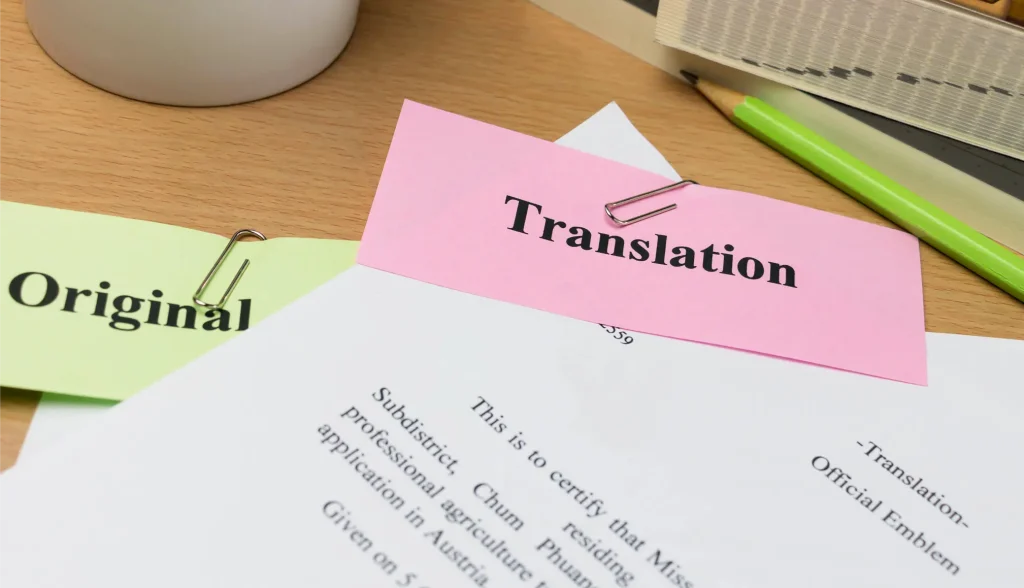
Omnibus Magazine Sam Hood Translation Prize

Columbia Undergraduate Law Review High School Essay Contest

Modeling the Future Challenge

Academic Decathlon

The Betty Award

Fitzwilliam College Essay Competition

Advantage Testing Foundation/Jane Street Math Prize for Girls

David McCullough Essay Prizes
Aralia Education is an innovative online education platform for ambitious middle and high school students worldwide. Aralia’s instructors propel students forward by helping them build a strong foundation in traditional academic courses. They also actively engage and guide students in exploring personal interests beyond their school curriculum. With this holistic approach, Aralia ensures its students are well-prepared for college and equipped for success in their future careers.
- College Accelerator Program
- Comprehensive Introduction to High School
- Academic Empowerment Program
- Test Preparation Bootcamp
- Private Lessons
- Student Awards
- Competitions
Give us a call: +1 (603) 932 7897
Email us: [email protected]
Add us on WhatsApp:

This website uses cookies.
By clicking the "Accept" button or continuing to browse our site, you agree to first-party and session-only cookies being stored on your device to enhance site navigation and analyze site performance and traffic. For more information on our use of cookies, please see our Privacy Policy .
The 2021 AEJ Best Paper Awards Have Been Announced
- Announcement
- April 20, 2021
The 2021 AEJ Best Paper Awards have been announced. The papers selected are highlighted below.
AEJ: Applied Economics
In “ Social Media and Corruption ,” authors Ruben Enikolopov, Maria Petrova, and Konstantin Sonin consider whether social media could hold institutional corruption in check when mainstream media is unable — or unwilling — to do so. They focused on activist Alexey Navalny ’s blog posts and the impact they had on the stock returns of companies that Navalny targeted because of their political connections to the Russian government. Stock returns dropped within three hours after he posted, amounting to a daily effect of 0.33 percentage points. There were larger impacts from particularly focused posts where he mentions a single company at least five times, with the stock price dropping up to 1.26 percentage points. ( AEJ: Applied Economics , Vol. 10, No. 1, January 2018 )
Read the Research Highlight here .
AEJ: Economic Policy
In “ How Antitrust Enforcement Can Spur Innovation: Bell Labs and the 1956 Consent Decree ,” authors Martin Watzinger, Thomas A. Fackler, Markus Nagler, and Monika Schnitzer looked at a 1956 consent decree against the Bell System that obligated the telecom giant to license all of its existing patents royalty free. They found that the consent decree led to a lasting increase in innovation but only in markets outside the telecommunications sector. The findings point to one potential lever that antitrust regulators have to ensure that innovation isn’t stifled by highly concentrated markets. ( AEJ: Economic Policy , Vol. 12, No. 4, November 2020 )
Read the Chart of the week here .
AEJ: Macroeconomics
In “ Deconstructing Monetary Policy Surprises—The Role of Information Shocks ,” authors Marek Jarociński and Peter Karadi disentangle monetary policy impacts from the Fed’s public assessment of the economy. They found that it’s not just the Fed’s policy decisions, but also its words about the outlook that impacts financial markets, with persistent effects on activity and prices. The findings provide a more nuanced and complicated view of how the Fed’s actions shape the economy. ( AEJ: Macroeconomics , Vol. 12 No. 2, April 2020 )
AEJ: Microeconomics
In “ Who Benefits from Information Disclosure? The Case of Retail Gasoline ,” author Fernando Luco asks whether information-disclosure policies intensify competition or facilitate coordination between suppliers. He analyzed regulations in Chile that required gas stations to post and update prices on a government website. Luco found that gas stations’ margins increased significantly after the policy, especially in poorer areas. The results show that disclosures can soften competition and that more information doesn’t always benefit consumers. ( AEJ: Microeconomics , Vol. 11, No. 2, May 2019 )
10 Popular Posts on Economic Topics in 2021
What did people most want to know about the economy in 2021?
Inflation and COVID-19’s effects on the economy were top of mind, judging by the popularity of posts on those topics in our On the Economy blog, which offers frequent commentary, analysis and data from our economists and other St. Louis Fed experts. But examinations of longer-run trends, such as employment growth over 20 years, also attracted attention.
For readers of our Open Vault blog, which explains everyday economics and the Fed, the nuts and bolts of topical subjects like central bank digital currency and Fed “tapering” struck a chord, as did a post about the economic concept of externalities, explained with canine and pandemic examples.
Here’s a look at a few of the posts that were among the favorites published from January through Nov. 30.
Inflation Trends
How covid-19 may be affecting inflation.
The changing of U.S. consumer spending patterns during the pandemic may have affected the measurement of inflation, according to an On the Economy post published in February. The Bureau of Labor Statistics gathers information about prices in the U.S., weights the prices and aggregates them for the consumer price index, or CPI. Inflation is measured as the CPI’s rate of growth over a certain period.
But what happens if a certain category of goods or services becomes a bigger, or smaller, part of consumer spending? Based on spending habits in prior years, the official weights might not be the “true” weights in 2020, when social distancing led to more eating at home and less spending in restaurants.
What Are Risks for Future Inflation?
As U.S. inflation surged in 2021, an October On the Economy post identified some upside and downside risks for future inflation. A follow-up post examined whether higher inflation could “be attributed to a small group of goods and services or whether it is a more generalized event.” Looking at the overall price change over the period of the pandemic, “the role of outliers is greatly diminished, revealing that higher inflation is perhaps a broader phenomenon,” the post said.
Economic and Monetary Policy Explainers
Externalities: it’s what pandemics, pollution and puppies have in common.
Externalities are costs and benefits that impact or spill over to someone other than the producer or the consumer of a good or a service. As a June Open Vault post explained, that applies to everything from pandemics to puppies. In a pandemic, a lack of social distancing by one person creates an externality that is negative: a higher risk of infection for everyone. Puppies that only bark at strangers, meanwhile, could provide a positive externality for neighbors as a warning system.
A June Open Vault blog post highlighted the Economic Lowdown series video “Externalities.” What makes pollution a negative externality is explained in this clip.
Here’s What the Fed Means by Tapering
As anticipation built this fall for a Federal Open Market Committee decision to “taper,” so did curiosity about what tapering is. An Open Vault post answered that question: The Fed can turn to large-scale asset purchases when economic conditions warrant, and tapering means reducing the pace of those purchases. The post, published a week after the Nov. 3 announcement of the FOMC’s decision to start tapering, also explained how tapering works.
What Is the Federal Open Market Committee?
Readers curious about what tapering is could have learned earlier in the year about the committee that makes that and other monetary policy decisions. As a February Open Vault post explained, the FOMC is the main monetary policymaking body of the Federal Reserve and is comprised of leaders from around the Federal Reserve System.
People and Places
Older workers accounted for all net employment growth in past 20 years.
Before there was the “Great Resignation,” there was an employment increase: A February On the Economy post said that a rise in employment of people age 60 and older was responsible for U.S. employment growth of 11.8 million from December 2000 to December 2020. (See chart.) Among those workers, the increase in employment is attributed to the group’s population growth and increased employment-to-population ratio.
Cumulative Net Change in the Number of Employed People since December 2000
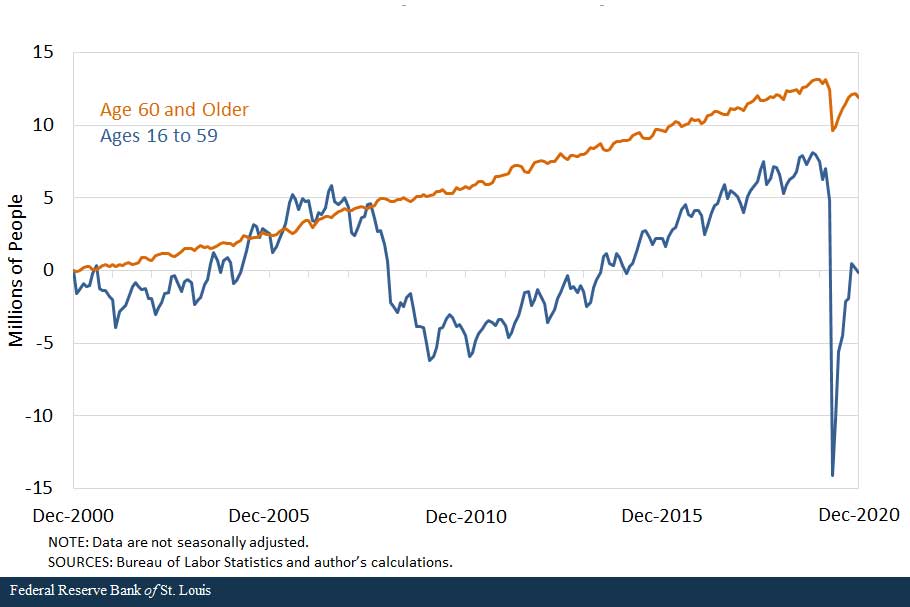
House Prices Surpass Housing-Bubble Peak on One Key Measure of Value
The steady increase of a house price-to-rent ratio “would imply increasing overvaluation” of houses, a May On the Economy post said. That was the case in early 2021 (using data available through March), when an index measuring the ratio of house prices to rent in the U.S. had risen rapidly over the course of a year and reached its highest level since at least 1975.

Sign up now for the free symposium, which has the theme, “Leading the Way in Challenging Times.” The event will run 6 to 8 p.m. CT on Feb. 23-24. Participants will hear insights from leading economists.
Inspiring Young Women to Pursue Economics
A January Open Vault post previewed a February 2021 event that is “designed to inspire young women and underrepresented minorities who may be interested in econ—and to encourage those pursuing a degree to persist.” The next Women in Economics Symposium is set for Feb. 23-24, 2022.
Money and Finance
Wealth gaps between white, black and hispanic families in 2019.
Across education, family structure and generations, gaps persist between the wealth of white families and that of Black and Hispanic families, the authors of a January On the Economy post found.
For instance, they wrote: “More education was associated with more wealth for all the racial and ethnic groups considered. However, wide gaps remain at every education level, with Black and Hispanic families having less median family wealth than white families with the same education.”
And Black and Hispanic families are less likely than white families to have financial and other assets like homes and businesses, and when they do, those assets were more likely to have lower values.
Navigating the ABCs of CBDCs—Central Bank Digital Currencies
“You’ve likely heard of Bitcoin, Ethereum, or even Dogecoin, but you may not have heard of ‘Fedcoin,’ an informal name some have used for the idea of a digital currency tied to a central bank, namely the Federal Reserve,” a June Open Vault post said. The post highlighted short videos in which a St. Louis Fed economist answered questions on central bank digital currencies, including about possible effects on privacy and bank lending.

Heather Hennerich is a senior editor with the St. Louis Fed External Engagement and Corporate Communications Division.
Related Topics
This blog explains everyday economics, consumer topics and the Fed. It also spotlights the people and programs that make the St. Louis Fed central to America’s economy. Views expressed are not necessarily those of the St. Louis Fed or Federal Reserve System.
Media questions
All other blog-related questions
The Global Economy: on Track for Strong but Uneven Growth as COVID-19 Still Weighs

A year and a half since the onset of the COVID-19 pandemic, the global economy is poised to stage its most robust post-recession recovery in 80 years in 2021. But the rebound is expected to be uneven across countries, as major economies look set to register strong growth even as many developing economies lag.
Global growth is expected to accelerate to 5.6% this year, largely on the strength in major economies such as the United States and China. And while growth for almost every region of the world has been revised upward for 2021, many continue to grapple with COVID-19 and what is likely to be its long shadow. Despite this year’s pickup, the level of global GDP in 2021 is expected to be 3.2% below pre-pandemic projections, and per capita GDP among many emerging market and developing economies is anticipated to remain below pre-COVID-19 peaks for an extended period. As the pandemic continues to flare, it will shape the path of global economic activity.
The United States and China are each expected to contribute about one quarter of global growth in 2021. The U.S. economy has been bolstered by massive fiscal support, vaccination is expected to become widespread by mid-2021, and growth is expected to reach 6.8% this year, the fastest pace since 1984. China’s economy – which did not contract last year – is expected to grow a solid 8.5% and moderate as the country’s focus shifts to reducing financial stability risks.
Lasting Legacies
Growth among emerging market and developing economies is expected to accelerate to 6% this year, helped by increased external demand and higher commodity prices. However, the recovery of many countries is constrained by resurgences of COVID-19, uneven vaccination, and a partial withdrawal of government economic support measures. Excluding China, growth is anticipated to unfold at a more modest 4.4% pace. In the longer term, the outlook for emerging market and developing economies will likely be dampened by the lasting legacies of the pandemic – erosion of skills from lost work and schooling; a sharp drop in investment; higher debt burdens; and greater financial vulnerabilities. Growth among this group of economies is forecast to moderate to 4.7% in 2022 as governments gradually withdraw policy support.
Among low-income economies, where vaccination has lagged, growth has been revised lower to 2.9%. Setting aside the contraction last year, this would be the slowest pace of expansion in two decades. The group’s output level in 2022 is projected to be 4.9% lower than pre-pandemic projections. Fragile and conflict-affected low-income economies have been the hardest hit by the pandemic, and per capita income gains have been set back by at least a decade.
Regionally, the recovery is expected to be strongest in East Asia and the Pacific, largely due to the strength of China’s recovery. In South Asia, recovery has been hampered by serious renewed outbreaks of the virus in India and Nepal. The Middle East and North Africa and Latin America and the Caribbean are expected to post growth too shallow to offset the contraction of 2020. Sub-Saharan Africa’s recovery, while helped by spillovers from the global recovery, is expected to remain fragile given the slow pace of vaccination and delays to major investments in infrastructure and the extractives sector.
Uncertain Outlook
The June forecast assumes that advanced economies will achieve widespread vaccination of their populations and effectively contain the pandemic by the end of the year. Major emerging market and developing economies are anticipated to substantially reduce new cases. However, the outlook is subject to considerable uncertainty. A more persistent pandemic, a wave of corporate bankruptcies, financial stress, or even social unrest could derail the recovery. At the same time, more rapid success in stamping out COVID-19 and greater spillovers from advanced economy growth could generate more vigorous global growth.
Even so, the pandemic is expected to have caused serious setbacks to development gains. Although per capita income growth is projected to be 4.9% among emerging market and developing economies this year, it is forecast to be essentially flat in low-income countries. Per capita income lost in 2020 will not be fully recouped by 2022 in about two-thirds of emerging market and developing economies, including three-quarters of fragile and conflict-affected low-income countries. By the end of this year, about 100 million people are expected to have fallen back into extreme poverty. These adverse impacts have been felt hardest by the most vulnerable groups – women, children, and unskilled and informal workers.
Global inflation, which has increased along with the economic recovery, is anticipated to continue to rise over the rest of the year; however, it is expected to remain within the target range for most countries. In those emerging market and developing economies in which inflation rises above target, this trend may not warrant a monetary policy response provided it is temporary and inflation expectations remain well-anchored.
Climbing Food Costs
Rising food prices and accelerating aggregate inflation may compound rising food insecurity in low-income countries. Policymakers should ensure that rising inflation rates do not lead to a de-anchoring of inflation expectations and resist using subsidies or price controls to reduce the burden of rising food prices, as these risk adding to high debt and creating further upward pressure on global agricultural prices.
A recovery in global trade after the recession last year offers an opportunity for emerging market and developing economies to bolster economic growth. Trade costs are on average one-half higher among emerging market and developing economies than advanced economies and lowering them could boost trade and stimulate investment and growth.
With relief from the pandemic tantalizingly close in many places but far from reach in others, policy actions will be critical. Securing equitable vaccine distribution will be essential to ending the pandemic. Far-reaching debt relief will be important to many low-income countries. Policymakers will need to nurture the economic recovery with fiscal and monetary measures while keeping a close eye on safeguarding financial stability. Policies should take the long view, reinvigorating human capital, expanding access to digital connectivity, and investing in green infrastructure to bolster growth along a green, resilient, and inclusive path.
It will take global coordination to end the pandemic through widespread vaccination and careful macroeconomic stewardship to avoid crises until we get there.
- Foreword by World Bank Group President David Malpass
- Report website
- Report download
- Press Release
- Blog: The Global Economic Outlook in five charts
- Download report data
- Download all charts (zip)
This site uses cookies to optimize functionality and give you the best possible experience. If you continue to navigate this website beyond this page, cookies will be placed on your browser. To learn more about cookies, click here .
Economics Essay Topics: Valuable Tips

Economics is a subject that has gained immense popularity in recent times. It deals with interesting economics topics like the production, distribution, and consumption of goods and services. Moreover, it is a social science that provides insights into how individuals, businesses, and governments make decisions that affect the overall economy. Given its importance, economics essays have become a crucial part of the curriculum for students pursuing various degrees.
Short Description
In this article, our essay writer will take you on a journey through various exciting topics in economics. We'll cover everything from big-picture concepts like macroeconomics to more focused ideas like microeconomics, international trade, and economic policy. Our goal is to help you find the perfect topic for your economics essay—one that matches your interests and demonstrates your understanding of how economics affects the real world.
🎓 What is Economics: Understanding the Importance
Before we dive into the different economics essay topics, it is crucial to understand what economics is and its importance. Economics is a social science that deals with the production, distribution, and consumption of goods and services. It is concerned with how individuals, businesses, and governments make decisions about allocating resources to satisfy their unlimited wants and needs.
Economics as a science provides a framework for analyzing society's production, distribution, and consumption of goods and services. It helps us understand how markets work and how they can be improved to increase efficiency and welfare. Moreover, economic principles have significant implications for various social issues, including poverty, inequality, environmental sustainability, and public policy. By studying economics essay topics, we can gain insights into these issues and develop policies that promote rapid economic growth and social welfare.

When it comes to economics, the range of essay topics is vast and covers various aspects of human interactions on different levels. With so many possibilities to explore, we understand the difficulty of narrowing down your options. That's why our ' write me an essay ' experts are here to offer their guidance and support. We're ready to help you select the ideal topic if you wish to learn how to write informative essay on economics.

🧩 Tips for Choosing Your Ideal Topic
Choosing a topic is the first and most crucial step in writing an economics essay. Your topic will determine the direction and scope of your essay. Here are some tips for choosing the ideal topic from our finance essay writing service :
Tip 1: Understand the relevance of economics to daily life and choose a topic with practical applications.
Recognize that economics plays a significant role in our everyday lives, as it encompasses the production, distribution, and consumption of goods and services. Therefore, when selecting a topic, ensure its societal relevance. For instance, you might consider exploring 'The Impact of Automation on Employment Rates' or 'The Role of Government Regulations in Controlling Inflation.'
Tip 2: Opt for narrow economics research topics to make them more manageable and allow for in-depth exploration.
Instead of tackling broad subjects like 'International Trade,' narrow down your focus to something like 'The Effects of Tariffs on Small Businesses in the Agriculture Sector' or 'The Relationship Between Exchange Rates and Export Performance in Developing Countries.' By delving deeper into a specific aspect, you can provide more detailed financial analysis and insights.
Tip 3: Conduct preliminary research to identify current topics, debates, and research gaps.
Before finalizing your topic, engage in preliminary research to gain an understanding of recent trends and issues in economics. Explore academic journals, news articles, and books to discover areas that warrant further exploration. For example, you might come across intriguing research gaps such as 'The Impact of Cryptocurrencies on Financial Markets' or 'The Role of Behavioral Economics in Shaping Consumer Decision-Making.'
Tip 4: Seek input from peers or professors to enhance your topic selection process.
Collaborate with your peers during brainstorming sessions to generate fresh ideas and gain different perspectives on potential topics. Additionally, seek guidance from your professor, who can offer valuable insights and feedback to refine your chosen topic. For instance, you can discuss your ideas with classmates and receive suggestions like 'The Influence of Economic Policies on Income Inequality' or receive expert advice from your professor on 'The Implications of Globalization on Developing Economies.'
And if you want expert assistance in applying theoretical concepts to practice and creating an exceptional paper, then address your request to our custom essay writing services .

🗒 Economics Essay Topics: A Comprehensive List
If you are looking for a comprehensive list of interesting economics essay topics, you have come to the right place. Here are some ideas that you can consider:

- The role of central banks in fiscal policy: You can explore the role of central banks in implementing fiscal policies, such as setting interest rates, regulating money supply, and managing inflation.
- The effects of automation on the labor market: You can explore the impact of automation on the labor market, including the displacement of workers and the emergence of new job opportunities.
- The impact of immigration on the labor market: You can explore the impact of immigration on the labor market, including the effects on wages, employment opportunities, and economic growth.
- The economics of climate change: You can explore the economic impact of climate change, including the costs of mitigation and adaptation measures, the effects on industries, and the role of governments in addressing the issue.
- The economics of healthcare: You can explore the economics of healthcare, including the costs of healthcare, the role of insurance companies, and the impact of healthcare policies on the economy.
- The role of government in the economy: You can explore the role of governments in implementing economic policies, including fiscal and monetary policies, and the impact of these policies on the economy.
- The impact of globalization on the economy: You can explore the economic implications of globalization, including the effects on industries, trade, and employment opportunities.
- The economics of poverty and inequality: You can explore the economics of poverty and inequality, including the causes and effects of poverty and inequality and the role of governments in addressing these issues.
- The economics of education: You can explore the economics of education, including the costs of education, the impact of education on economic growth, and the role of governments in promoting education.
- The role of competition in the marketplace: You can explore the role of competition in promoting economic growth, innovation, and consumer welfare.
- The economics of entrepreneurship: You can explore the economics of entrepreneurship, including the factors that promote entrepreneurship, the impact of entrepreneurship on the economy, and the role of governments in promoting entrepreneurship.
- The impact of quantitative easing on economic recovery: You can explore the consequences of large-scale asset purchases and their influence on inflation, employment rates, and overall economic stability.
- The economics of renewable energy transition: You can analyze the costs, benefits, and challenges associated with adopting renewable energy technologies and their potential effects on energy prices, employment, and environmental sustainability.
- The role of technological innovation in economic development: You can examine the impact of research and development, technological diffusion, and digitalization on productivity, job creation, and competitiveness in various sectors of the economy.
- Behavioral economics and consumer decision-making: You can examine concepts such as cognitive biases, heuristics, and framing effects and explore how these factors shape consumer behavior, market outcomes, and the effectiveness of public policies.
Ready to Advance Yourself in the Economics Field?
Get the essay that will have even experts in awe!
🧮 Macroeconomics Essay Topics
Macroeconomics is a fascinating and complex field of study that aims to understand the overall performance of an economy. It takes into account various factors such as economic growth, inflation, unemployment, and trade policies. If you are looking for some thought-provoking macroeconomics essay topics, here are a few that you might find interesting:
- The role of digital currencies (cryptocurrencies) in the global economy and their impact on monetary policy.
- The economics of aging populations: Analyzing the challenges and opportunities associated with demographic shifts.
- The impact of trade wars and protectionist policies on global economic growth and international trade.
- The economics of happiness and well-being: Investigating the relationship between economic factors and subjective measures of life satisfaction.
- The role of government spending in stimulating economic growth and addressing income inequality.
- The economics of urbanization: Examining the effects of urban growth on productivity, income distribution, and resource allocation.
- The impact of automation and artificial intelligence on employment and the future of work.
- The economics of climate change: Analyzing the economic costs and benefits of climate policies and the transition to a low-carbon economy.
- The role of financial markets in transmitting economic shocks and their implications for systemic risk and financial stability.
- The economics of inequality: Investigating the causes and consequences of income and wealth disparities within and between countries.
📉 Microeconomics Essay Topics
Microeconomics focuses on the behavior of individual consumers and businesses in the market. The principles of microeconomics are used to analyze how these entities make decisions, interact with each other, and influence the overall economy. If you're interested in exploring this field further, here are some microeconomics essay topics that you might find interesting:
- Behavioral economics and its implications for consumer decision-making.
- The impact of artificial intelligence and automation on labor economics and income inequality.
- Pricing strategies in the sharing economy: A critical analysis of platforms like Uber and Airbnb.
- The economics of addiction: Analyzing the factors influencing consumer behavior and the effects on individual welfare.
- The role of information and asymmetry in financial markets: Examining the impact on investor decision-making and market efficiency.
- Game theory and its application in strategic decision-making in business and economics.
- The economics of innovation and entrepreneurship: Studying the factors that drive technological advancements and their impact on economic growth.
- Health economics: Analyzing the relationship between healthcare expenditure, access, and health outcomes.
- The economics of education: Investigating the determinants of educational attainment and its effects on individual and societal welfare.
- The economics of discrimination: Examining the economic implications of bias based on race, gender, or other factors in labor markets and beyond.
🎏 International Economics Essay Topics
International economics deals with the economic interactions between countries, including trade, investment, and migration. Here are some international economic relations topics:
- The impact of trade liberalization on developing economies: A comparative analysis of different trade policies and their effects on economic growth and income distribution.
- The role of foreign direct investment (FDI) in promoting technological transfer and industrial development in emerging markets.
- The economics of global supply chains: Analyzing the benefits and challenges of interconnected production networks in the context of international trade.
- The implications of Brexit on the European Union and the United Kingdom: Assessing the economic consequences and potential trade arrangements.
- The role of international institutions (such as the World Trade Organization, International Monetary Fund, etc.) in governing global economic relations: Evaluating their effectiveness and relevance in modern world economics.
- The economics of currency exchange rates: Examining the factors influencing exchange rate movements and their impact on trade and investment flows.
- The rise of protectionist policies and their implications for global trade: Assessing the economic consequences and potential risks associated with trade barriers.
- The impact of international migration on labor markets and economic development: Analyzing the effects of immigration policies and the role of migrant workers in host countries.
- The economics of foreign aid: Evaluating the effectiveness of foreign aid in promoting economic development and reducing poverty in recipient countries.
- The economics of regional economic integration: Examining the benefits and challenges of regional trade agreements, such as the European Union or the Association of Southeast Asian Nations (ASEAN).
📉 Behavioral Economics Essay Topics
Behavioral economics combines psychology and economics to analyze how people make decisions. Here are some behavioral economics essay topics:
- The influence of socio-economic norms on consumer behavior and decision-making.
- The impact of framing effects on individual choices and decision-making processes.
- The role of default options in shaping consumer behavior and encouraging desirable outcomes.
- Prospect theory and its implications for understanding risk-taking behavior.
- Nudging strategies and their effectiveness in promoting positive behaviors and outcomes.
- The role of behavioral economics in understanding and addressing irrational financial decision-making.
- Behavioral economics interventions to promote sustainable and environmentally friendly behaviors.
- The psychology of pricing: How behavioral economics principles influence consumer perception of value.
- The influence of emotional factors on consumer decision-making processes.
- Behavioral biases in investment decision-making and their impact on financial markets.
🚑 Healthcare Economics Essay Topics
Healthcare economics analyzes how the healthcare system operates, including the costs and benefits of healthcare interventions. Here are some healthcare economics essay topics:
- The impact of healthcare insurance coverage on access to care and health outcomes.
- The role of economic incentives in shaping healthcare provider behavior and the quality of care.
- The economics of pharmaceutical pricing and its effects on affordability and access to medications.
- The cost-effectiveness of preventive healthcare interventions and their implications for healthcare spending.
- The economics of healthcare disparities and the role of social determinants of health in driving inequities.
- The impact of healthcare market competition on prices, quality, and innovation.
- The role of health technology assessment in informing healthcare resource allocation decisions.
- The economic evaluation of alternative healthcare delivery models, such as telemedicine and community health clinics.
- The impact of healthcare reforms and policy changes on healthcare costs and access to care.
- The economics of aging populations and the challenges of financing healthcare for the elderly.
🌎 Consumerism Essay Topics
Consumerism refers to the cultural and economic mindset that encourages the acquisition of goods and services. Here are some consumerism essay topics:
- The effects of consumerism on individual well-being and happiness.
- Consumerism and its impact on environmental sustainability and resource depletion.
- The role of advertising and marketing in shaping consumer behavior and promoting consumerism.
- Consumerism and its relationship with materialism and the pursuit of social status.
- The influence of consumerism on personal debt and financial well-being.
- Consumerism and its effects on societal values, culture, and social relationships.
- The ethical implications of consumerism and the responsibilities of consumers in a globalized world.
- The role of consumer activism in challenging and reshaping consumerism.
- Consumerism and its impact on mental health and psychological well-being.
- The future of consumerism in the digital age and the rise of e-commerce and online shopping.
📚 Economic History Topics
Economic history is a field of study that examines the historical development of economic systems, policies, and institutions, as well as the social, political, and cultural factors that have influenced economic outcomes over time. Here are the 10 interesting topics:
- The Industrial Revolution and its impact on economic development and societal transformation.
- Economic consequences of colonialism: examining the long-term effects on former colonies' economies.
- The Great Depression: causes, consequences, and policy responses.
- The role of institutions in economic development: a comparative study of different countries and regions.
- The rise and fall of economic empires: analyzing the economic power of ancient civilizations.
- The economic effects of wars and conflicts throughout history.
- The evolution of money and financial systems: from barter to digital currencies.
- The economic impact of technological advancements: case studies from different time periods.
- Economic inequality over time: trends, drivers, and consequences.
- The role of trade and globalization in shaping economic history: exploring patterns and impacts.
📊 Public Finance Research Topics
Public finance research focuses on the study of the government's role in the allocation, distribution, and management of resources within an economy. It encompasses the analysis of public revenues, expenditures, taxation policies, and the impact of government interventions on economic outcomes and social welfare. Here are 10 relevant economics papers topics:
- The impact of government spending on economic growth and development.
- The effectiveness of fiscal policy in managing economic downturns and promoting stability.
- The role of taxation in income redistribution and reducing income inequality.
- The economics of public debt and its implications for economic stability and future generations.
- The efficiency and equity implications of different tax systems (e.g., progressive, regressive, flat).
- The economic consequences of public infrastructure investment and its role in promoting economic productivity.
- The evaluation of government subsidies and incentives in promoting desired behaviors and industries.
- The economics of public-private partnerships and their effectiveness in delivering public goods and services.
- The impact of social welfare programs on labor supply, poverty reduction, and income mobility.
- The economics of environmental policy and the use of market-based instruments to address externalities.
Closing Remarks
To wrap up, economics is a subject that offers insights into how the world works. It provides a framework for analyzing complex social issues, including poverty, inequality, and public policy. Therefore, exploring economics essays topics is an excellent way of understanding the subject's relevance in the real world.
By following the tips for choosing your ideal topic and exploring the comprehensive list of economics topics for an essay, you can write an insightful and inspiring paper that contributes to the ongoing dialogue on economics.
Looking for Someone to Reduce Your College Stress?
Our expert writers can craft A+ essays when you want and how you want
Related Articles
.webp)
WORLD TRADE ORGANIZATION
Home | About WTO | News & events | Trade topics | WTO membership | Documents & resources | External relations
Contact us | Site map | A-Z | Search
español français
ESSAY AWARD FOR YOUNG ECONOMISTS
Winning essays
“Efficiency and Redistribution in Environmental Policy: An Equilibrium Analysis of Agricultural Supply Chains” by Tomas Dominguez-Iino
The author looks beyond carbon taxes to consider the possibilities for regulating trade-oriented and imperfectly competitive industries that contribute to climate change.
Looking in particular at the South American agricultural sector, he shows that imposing environmental tariffs on agricultural imports from South America is an option that would perform poorly due to “carbon leakage”, whereby emissions reductions achieved by regulated markets are mostly offset by increased trade flows to non-regulated markets. Imposing tariffs would also lead to adverse distributional effects for South American farmers, which would be exacerbated by the market power of the agribusiness firms to which they sell their output.
In the view of the Selection Panel, this paper takes on a very important and timely set of policy issues. The panel praised its insights and said it was useful in cautioning policymakers about unintended consequences of policy decisions.
Tomas Dominguez-Iino is from Argentina. He got his Ph.D. from New York University in 2021. He will be a Postdoctoral Researcher, University of Chicago Booth School of Business, in 2021-22. He will then join the Federal Reserve Board as of 2022.
“Learning between Buyers and Sellers along the Global Value Chain” by Swapnika Rachapalli
The author asks whether input suppliers learn how to make downstream products from their buyers and, if so, what the role of international trade is in providing access to better downstream foreign knowledge through buyer-seller interactions.
She uses plant-level data from the Indian manufacturing sector and product-level input/output tables to show that Indian firms benefit from knowledge flows from their foreign buyers to expand downstream and respond to increases in foreign demand. The paper finds that gains from opening up are larger for firms/countries with less technological know-how and which were previously more closed to foreign markets.
In the view of the Panel, the author has identified a very important mechanism by which developing countries can gain from trade with industrialized countries through technology upgrading.
Swapnika Rachapalli is from India. She got her Ph.D. from the University of Toronto, Canada, in 2021. She will be a postdoctoral fellow at Princeton University’s International Economics Section in 2021-22, and as of July 2022 Assistant Professor at the University of British Columbia.
Selection Panel
The Selection Panel comprised Beata Javorcik (Professor of Economics, University of Oxford), Robert Koopman (Director, Economic Research and Statistics Division, WTO), Robert Staiger (Professor of Economics, Dartmouth University), Alberto Trejos (Professor of Economics, INCAE Business School). Roberta Piermartini (Chief of Section, Economic Research and Statistics Division, WTO) coordinated the work of the Selection Panel.

Problems viewing this page? If so, please contact [email protected] giving details of the operating system and web browser you are using.

UC Berkeley’s Premier Undergraduate Economics Journal
- Uncategorized
Fall 2021 High School Essay Contest – Open Now!
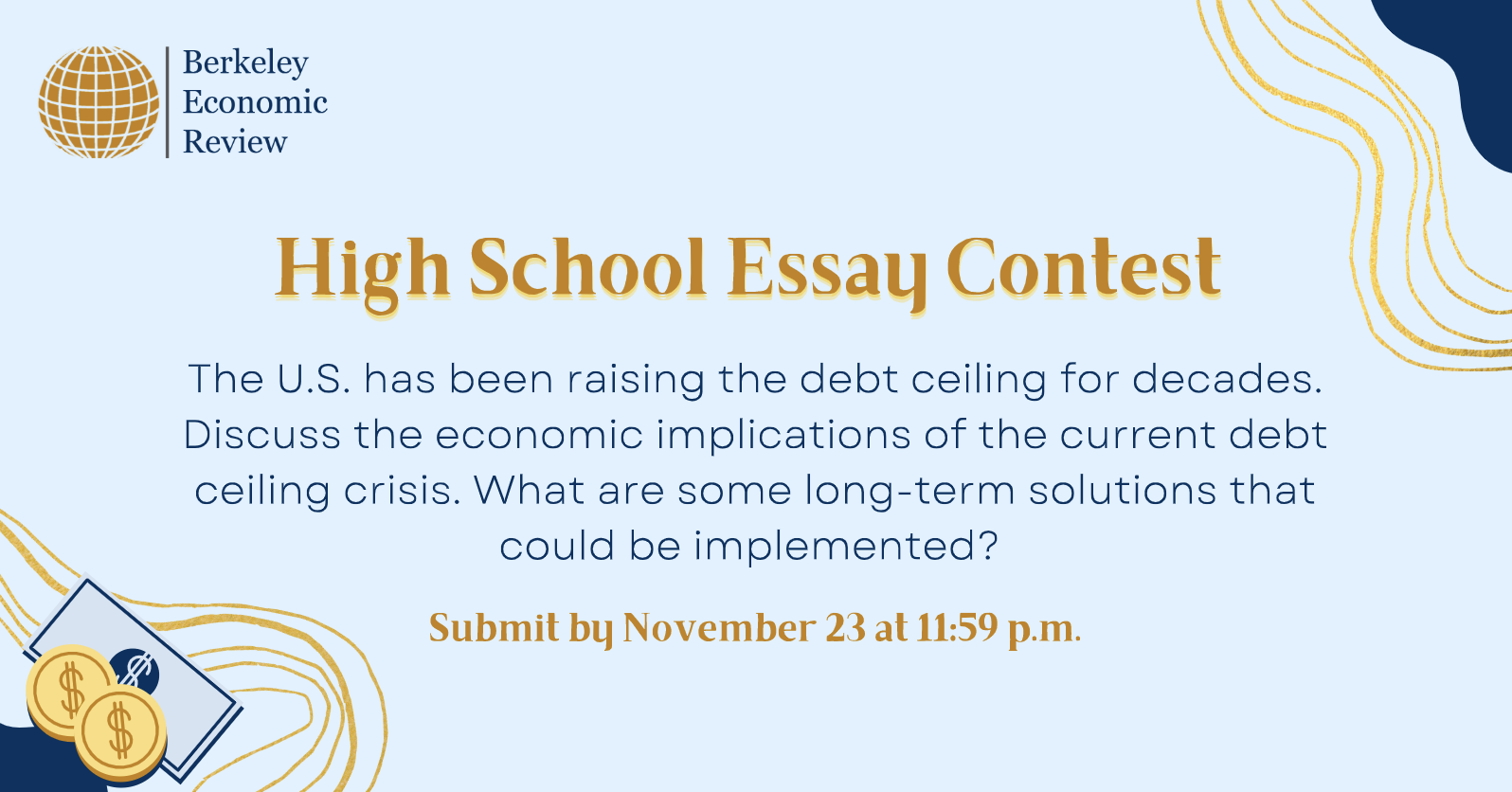
- Have your work published in the Fall 2021 Issue of Equilibrium
- Be recognized on BER’s social media and website
- Receive a cash prize
Share this article:
Related Articles

Spotlight on Joseph Hernandez

Spring 2022 High School Essay Contest
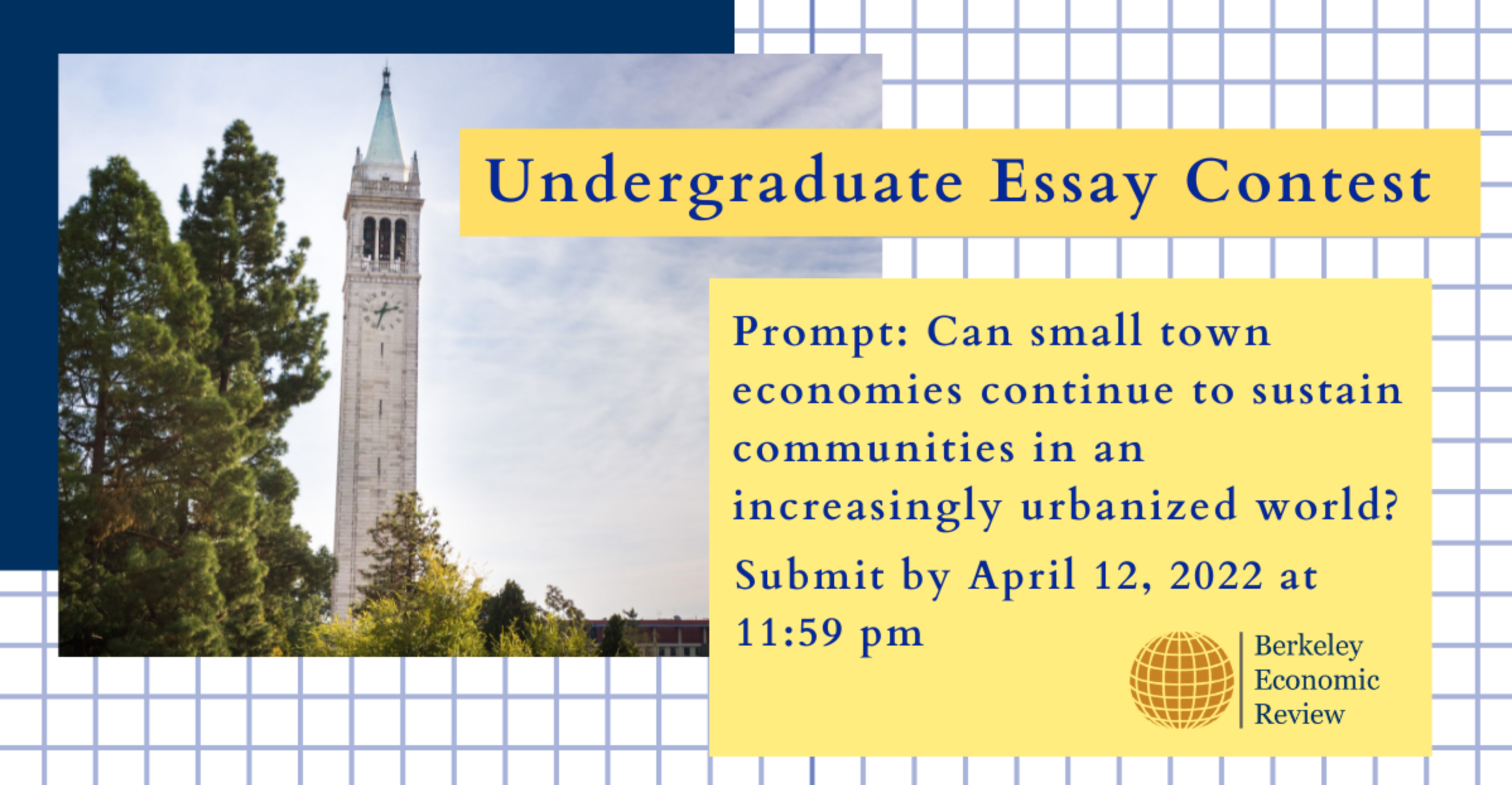
Spring 2022 Undergraduate Essay Contest
Leave a reply cancel reply.
Your email address will not be published. Required fields are marked *
Save my name, email, and website in this browser for the next time I comment.
subscribe to our Monthly Newsletter!
Browse Econ Literature
- Working papers
- Software components
- Book chapters
- JEL classification
More features
- Subscribe to new research
RePEc Biblio
Author registration.
- Economics Virtual Seminar Calendar NEW!

Search IDEAS All Articles Papers Chapters Books Software In: Whole record Abstract Keywords Title Author Sort by: new options Relevance Oldest Most recent Most cited Title alphabet Recently added Recent & relevant Relevant & cited Recent & cited From: Any Year 2024 2023 2022 2021 2020 2019 2018 2017 2016 2015 2014 2013 2012 2011 2010 2009 2008 2007 2006 2005 2004 2003 2002 2001 2000 1999 1998 1997 1996 1995 1994 1993 1992 1991 1990 1985 1980 1975 1970 1960 1950 1940 1930 1900 1800 1700 To: Any Year 2024 2023 2022 2021 2020 2019 2018 2017 2016 2015 2014 2013 2012 2011 2010 2009 2008 2007 2006 2005 2004 2003 2002 2001 2000 1999 1998 1997 1996 1995 1994 1993 1992 1991 1990 1985 1980 1975 1970 1960 1950 1940 1930 1900 1800 1700 More advanced search New: sort by citation count and by recently added --> What is IDEAS? IDEAS is the largest bibliographic database dedicated to Economics and available freely on the Internet. Based on RePEc , it indexes over 4,700,000 items of research, including over 4,200,000 that can be downloaded in full text. RePEc is a large volunteer effort to enhance the free dissemination of research in Economics which includes bibliographic metadata from over 2,000 participating archives , including all the major publishers and research outlets. IDEAS is just one of several services that use RePEc data. For some statistics about the holdings on this site, see here . Authors are invited to register with RePEc to create an online profile. Then, anyone finding some of their research here can find your latest contact details and a listing of their other research. They will also receive a monthly mailing about the popularity of their works, their ranking and newly found citations. How do I find on IDEAS what I am looking for?
More services and features.
Follow serials, authors, keywords & more
Public profiles for Economics researchers
Various research rankings in Economics
RePEc Genealogy
Who was a student of whom, using RePEc
Curated articles & papers on economics topics
Upload your paper to be listed on RePEc and IDEAS
New papers by email
Subscribe to new additions to RePEc
EconAcademics
Blog aggregator for economics research
Cases of plagiarism in Economics
About RePEc
Initiative for open bibliographies in Economics
News about RePEc
Questions about IDEAS and RePEc
RePEc volunteers
Participating archives
Publishers indexing in RePEc
Privacy statement
Corrections.
Found an error or omission?
Opportunities to help RePEc
Get papers listed
Have your research listed on RePEc
Open a RePEc archive
Have your institution's/publisher's output listed on RePEc
Get RePEc data
Use data assembled by RePEc
Edexcel A-Level Economics Past Papers
This section includes recent A-Level Economics and AS Economics past papers from Pearson Edexcel. You can download each of the Pearson Edexcel A-Level Economics past papers and marking schemes by clicking the links below.
Economics A (9EC0): Pearson Edexcel A-Level Past Papers June 2022
Paper 1: A-Level - Markets and Business Behaviour (9EC0/01) Download Past Paper - Download Mark Scheme Paper 2: A-Level - The National and Global Economy (9EC0/02) Download Past Paper - Download Mark Scheme Paper 3: A-Level - Microeconomics and Macroeconomics (9EC0/03) Download Past Paper - Download Mark Scheme
Economics B (9EB0): Pearson Edexcel A-Level Past Papers June 2022
Paper 1: A-Level - Markets and how they Work (9EB0/01) Download Past Paper - Download Mark Scheme Paper 2: A-Level - Competing in the Global Economy (9EB0/02) Download Past Paper - Download Mark Scheme Paper 3: A-Level - The Economic Environment and Business (9EB0/03) Download Past Paper - Download Mark Scheme
Economics A (9EC0): Pearson Edexcel A-Level Past Papers November 2021
Economics B (9EB0): Pearson Edexcel A-Level Past Papers November 2021
Economics A (9EC0): Pearson Edexcel A-Level Past Papers November 2020
Paper 1: A-Level - Markets and Business Behaviour (9EC0/01) Download Past Paper - Download Mark Scheme Paper 2: A-Level - The National and Global Economy (9EC0/02) Download Past Paper - Download Mark Scheme Paper 3: A-Level - Microeconomics and Macroeconomics (9EC0/03) Download Past Paper - Download Mark Scheme
The above papers are labelled June 2020
Economics A (8EC0): Pearson Edexcel AS-Level Past Papers November 2020
Paper 1: AS - Introduction to Markets and Market Failure (8EC0/01) Download Past Paper - Download Mark Scheme Paper 2: AS - The UK Economy - performance and policies (8EC0/02) Download Past Paper - Download Mark Scheme
The above papers are labelled June 2020
Economics B (9EB0): Pearson Edexcel A-Level Past Papers November 2020
Paper 1: A-Level - Markets and how they Work (9EB0/01) Download Past Paper - Download Mark Scheme Paper 2: A-Level - Competing in the Global Economy (9EB0/02) Download Past Paper - Download Mark Scheme Paper 3: A-Level - The Economic Environment and Business (9EB0/03) Download Past Paper - Download Mark Scheme
Economics B (8EB0): Pearson Edexcel AS-Level Past Papers November 2020
Paper 1: AS - Markets, Consumers and Firms (8EB0/01) Download Past Paper - Download Mark Scheme Paper 2: AS - The Wider Economic Environment (8EB0/02) Download Past Paper - Download Mark Scheme
Economics A (9EC0): Pearson Edexcel A-Level Past Papers June 2019
Paper 1: A-Level - Markets and Business Behaviour (9EC0/01) Download Past Paper - Download Mark Scheme Paper 2: A-Level - The National and Global Economy (9EC0/02) Download Past Paper - Download Mark Scheme Paper 3: A-Level - Microeconomics and Macroeconomics (9EC0/03) Download Past Paper - Download Mark Scheme
Economics A (8EC0): Pearson Edexcel AS-Level Past Papers June 2019
Economics B (9EB0): Pearson Edexcel A-Level Past Papers June 2019
Paper 1: A-Level - Markets and how they Work (9EB0/01) Download Past Paper - Download Mark Scheme Paper 2: A-Level - Competing in the Global Economy (9EB0/02) Download Past Paper - Download Mark Scheme Paper 3: A-Level - The Economic Environment and Business (9EB0/03) Download Past Paper - Download Mark Scheme
Economics B (8EB0): Pearson Edexcel AS-Level Past Papers June 2019
Economics A (9EC0): Pearson Edexcel A-Level Past Papers June 2018
Paper 1: A-Level - Markets and Business Behaviour (9EC0/01) Download Past Paper - Download Mark Scheme Paper 2: A-Level - The National and Global Economy (9EC0/02) Download Past Paper - Download Mark Scheme Paper 3: A-Level - Microeconomics and Macroeconomics (9EC0/03) Download Past Paper - Download Mark Scheme
Economics A (8EC0): Pearson Edexcel AS-Level Past Papers June 2018
Paper 1: AS - Introduction to Markets and Market Failure (8EC0/01) Download Past Paper - Download Mark Scheme Paper 2: AS - The UK Economy - performance and policies (8EC0/02) Download Past Paper - Download Mark Scheme
Economics B (9EB0): Pearson Edexcel A-Level Past Papers June 2018
Paper 1: A-Level - Markets and how they Work (9EB0/01) Download Past Paper - Download Mark Scheme Paper 2: A-Level - Competing in the Global Economy (9EB0/02) Download Past Paper - Download Mark Scheme Paper 3: A-Level - The Economic Environment and Business (9EB0/03) Download Past Paper - Download Mark Scheme
Economics B (8EB0): Pearson Edexcel AS-Level Past Papers June 2018
Paper 1: AS - Markets, Consumers and Firms (8EB0/01) Download Past Paper - Download Mark Scheme Paper 2: AS - The Wider Economic Environment (8EB0/02) Download Past Paper - Download Mark Scheme
Economics A (9EC0): Edexcel A-Level Past Papers June 2017
Economics A (8EC0): Edexcel AS-Level Past Papers June 2017
Economics B (9EB0): Edexcel A-Level Past Papers June 2017
Economics B (8EB0): Edexcel AS-Level Past Papers June 2017
Economics A (8EC0): Edexcel AS-Level Past Papers June 2016
Paper 1: AS - Introduction to Markets and Market Failure (8EC0/01) - Download Past Paper - Download Mark Scheme Paper 2: AS - The UK Economy - performance and policies (8EC0/02) - Download Past Paper - Download Mark Scheme
Economics B (8EB0): Edexcel AS-Level Past Papers June 2016
Paper 1: AS - Markets, Consumers and Firms (8EB0/01) - Download Past Paper - Download Mark Scheme Paper 2: AS - The Wider Economic Environment (8EB0/02) - Download Past Paper - Download Mark Scheme
Edexcel A-Level Economics Past Papers June 2016
Unit 1: Competitive Markets: How they work and why they fail (6EC01) - Download Past Paper - Download Mark Scheme
Unit 2: Managing the Economy (6EC02) - Download Past Paper - Download Mark Scheme
Unit 3: Business Economics and Economic Efficiency (6EC03) - Download Past Paper - Download Mark Scheme
Unit 4: The Global Economy (6EC04) - Download Past Paper - Download Mark Scheme
Edexcel A-Level Economics June 2015
Edexcel A-Level Economics June 2014
For more A-Level Economics past papers from other exam boards click here .

National Bureau of Economic Research
Latest from the nber, a research summary from the monthly nber digest.
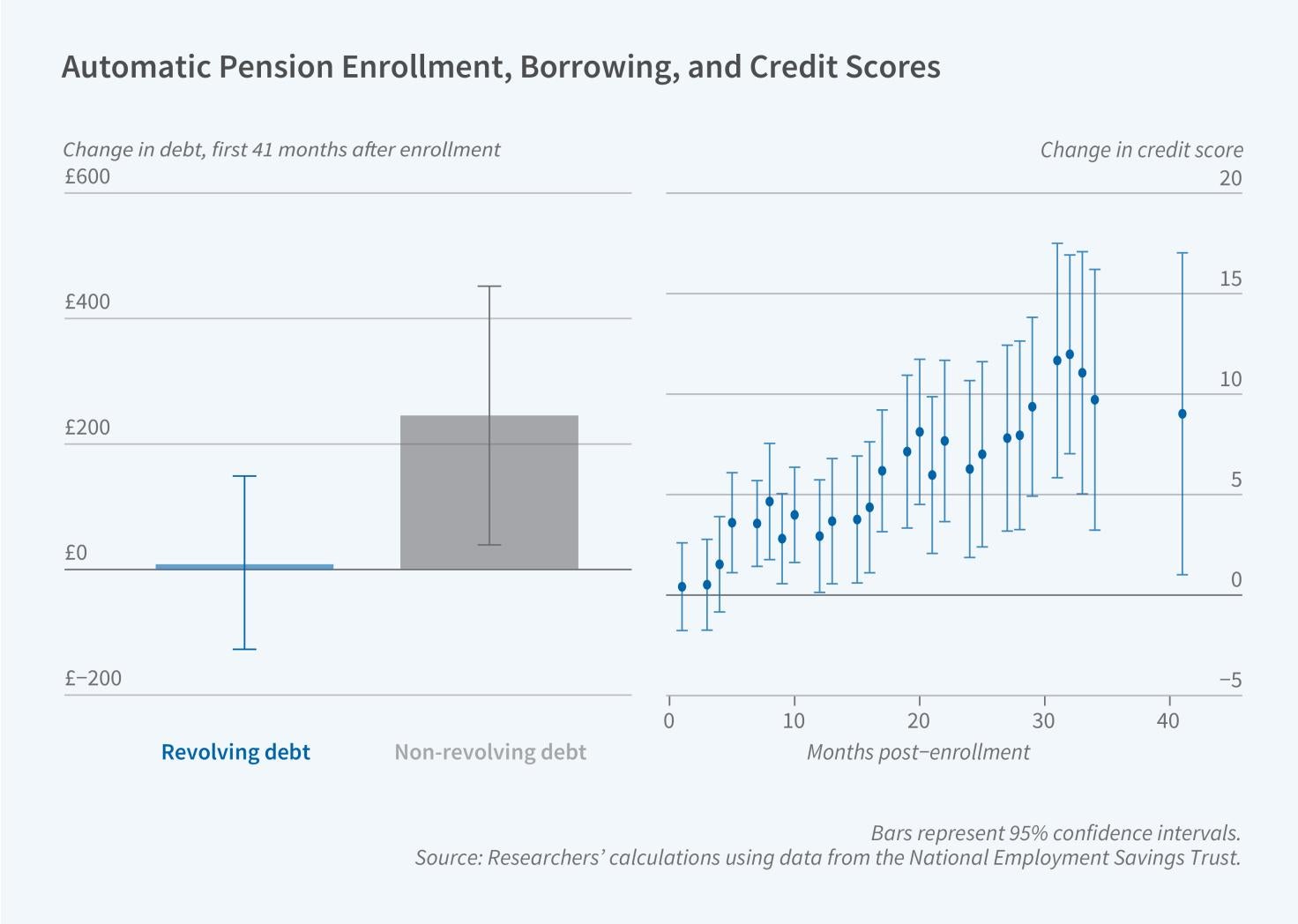
Workers Auto-enrolled in Pensions Save, but also Borrow, More
Many countries require employers to enroll their workers in retirement savings plans that deposit a regular percentage of their paycheck in a retirement account unless the worker opts out. These automatic enrollment programs are meant to address concerns that the employees, left to their own devices, might save too little for retirement. Previous research has documented that automatic enrollment in a savings plan significantly increases participation and contribution rates.
From the NBER Bulletin on Entrepreneurship
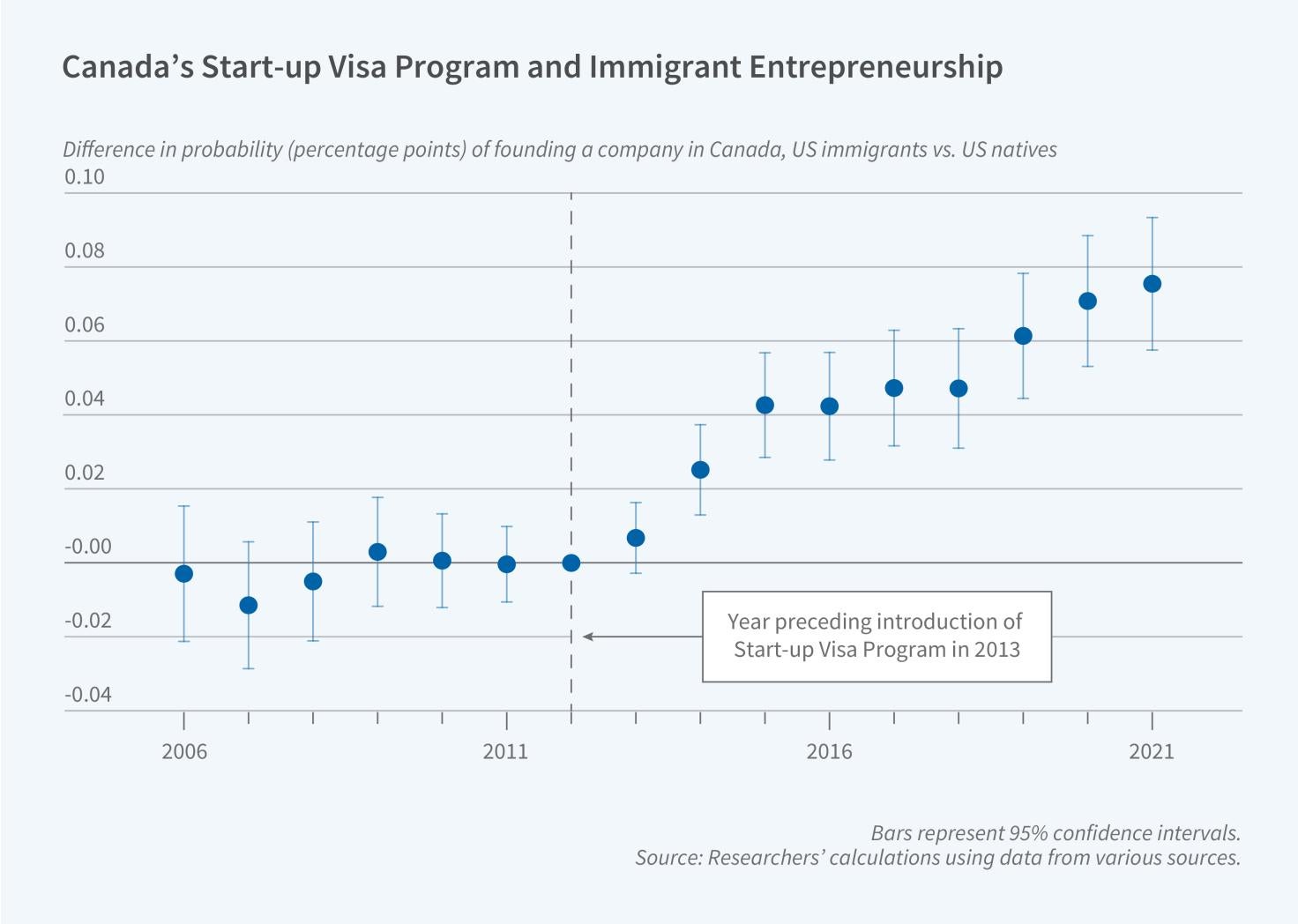
Immigration Policy and Entrepreneurs’ Choice of Startup Location
Immigrants play a significant role in the entrepreneurial landscape. In the United States, immigrants are 80 percent more likely to start businesses than native-born Americans. More than half of America's billion-dollar startup companies trace their roots to immigrant founders. There is limited research, however, on the factors that influence immigrants' decisions about where to locate their startup businesses.
From the NBER Reporter: Research, program, and conference summaries
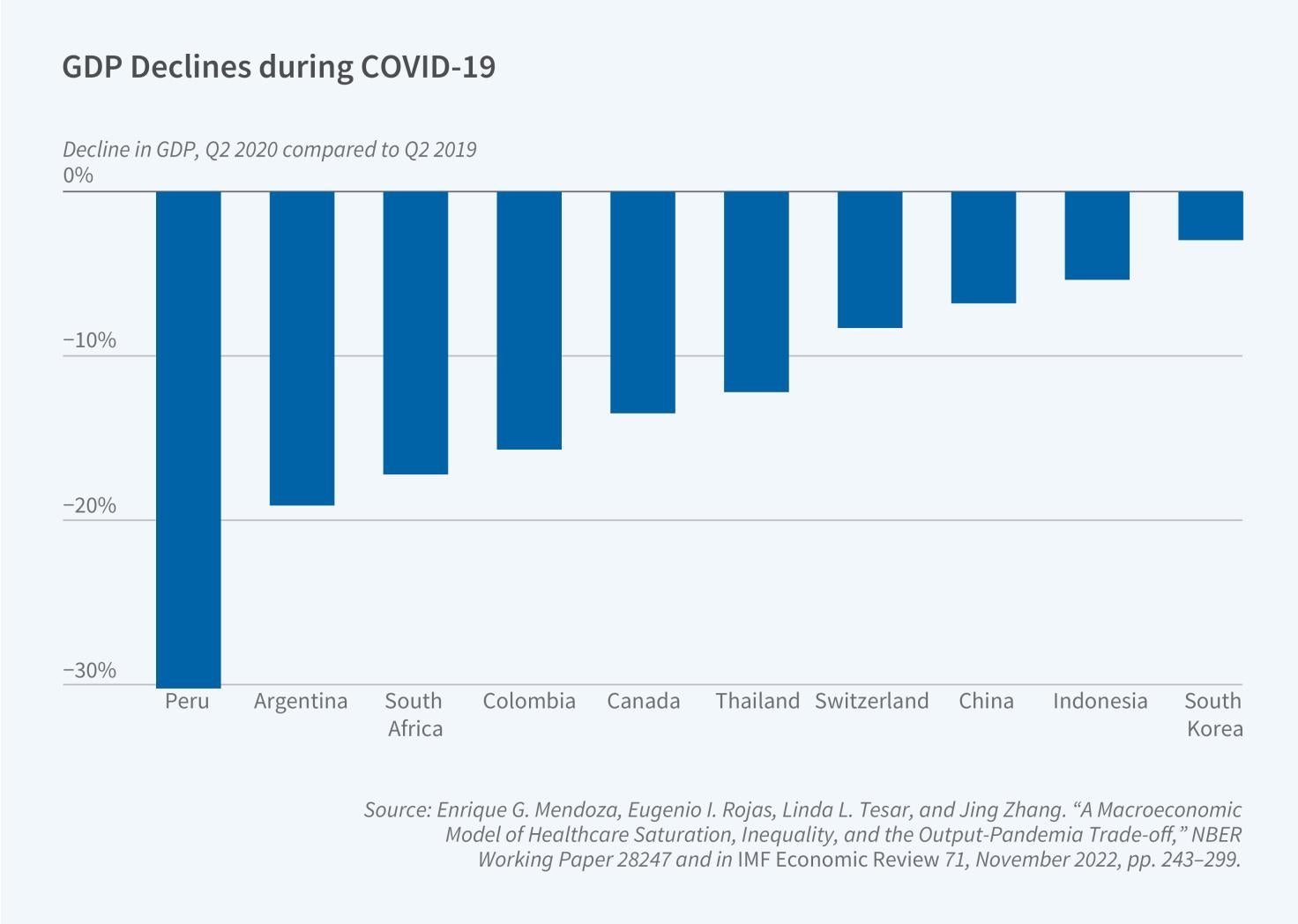
Program Report: International Finance and Macroeconomics
Affiliates of the International Finance and Macroeconomics (IFM) Program study financial interactions among nations, including cross-border capital flows, exchange rates, responses to global financial crises, and the transmission of economic shocks. Rather than attempting to summarize the more than 1,000 working papers these researchers have distributed since the last program report in 2015, we focus here on three issues that have attracted substantial research attention from this group: impacts of the COVID-19 pandemic, global supply chain shocks, and the privileged position of the US dollar in global asset...
From the NBER Bulletin on Health
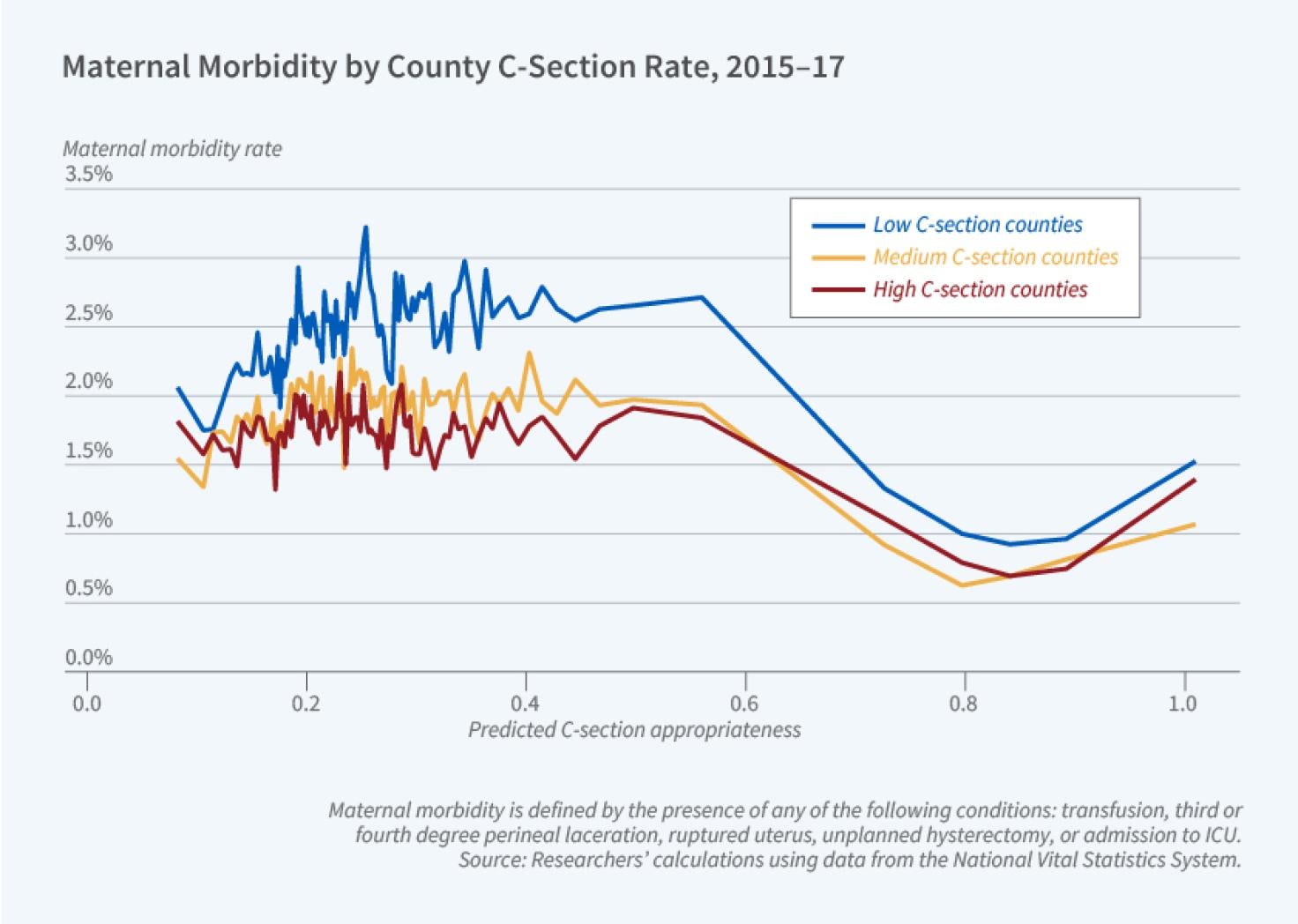
C-section Rates and Birth Outcomes
Cesarean section (C-section) is the most common surgical procedure performed in the United States. Sarah Robinson , Heather Royer , and David Silver report that C-section rates for first-time, singleton births increased from 24 percent to 32 percent between 1989 and 2017 alongside significant changes in medical practices during this period. In 2001, for example, the American College of Obstetricians and Gynecologists began recommending C-sections for breech births. The rising rate of C-sections has sparked a debate about whether this procedure is being overused.
In Geographic Variation in Cesarean Sections in the United States: Trends, Correlates, and Other Interesting Facts (NBER Working Paper 31871), the researchers study how cross-county differences in C-section usage correlate with infant and maternal...
From the NBER Bulletin on Retirement and Disability
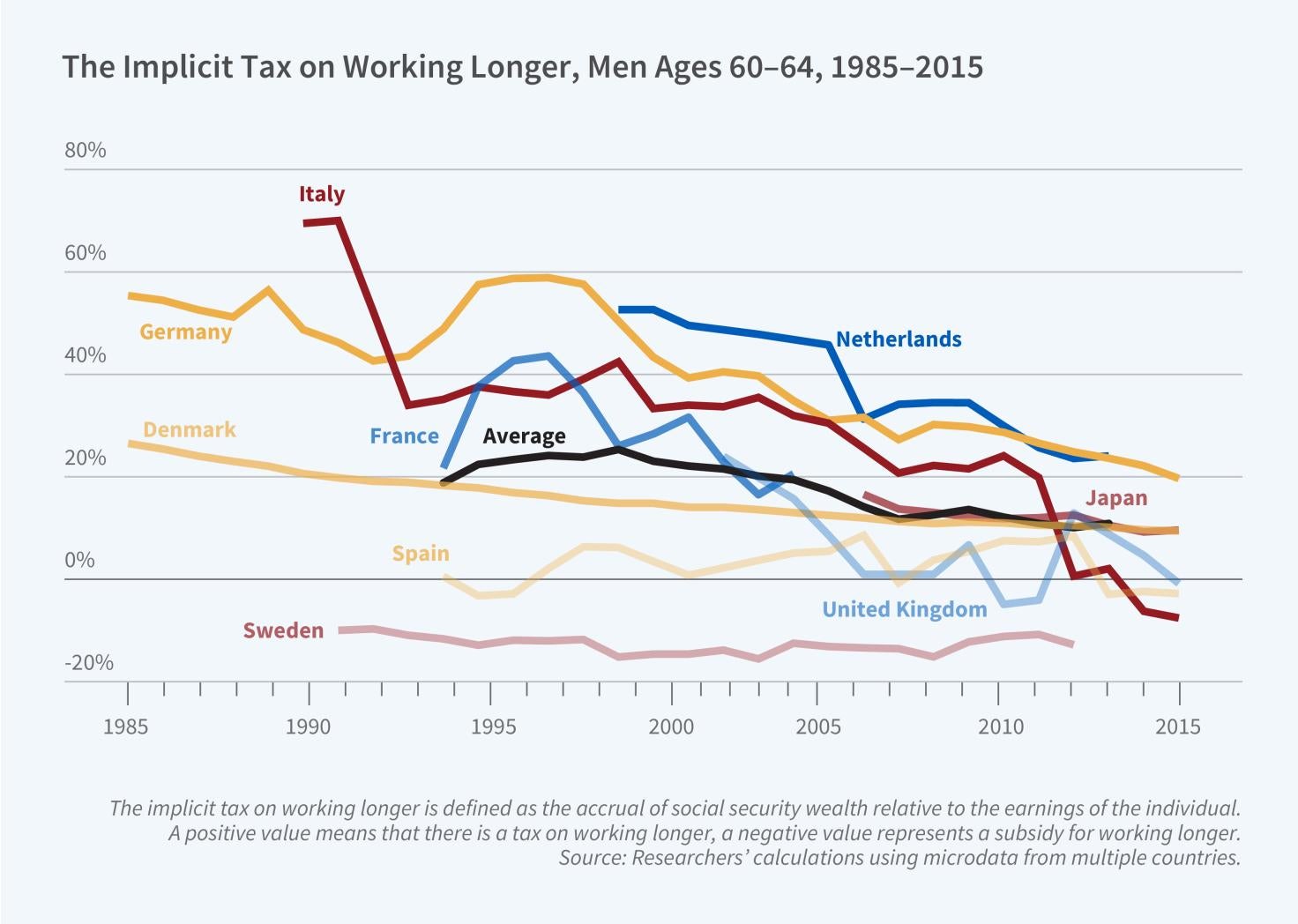
Social Security and Retirement around the World
Over the past 25 years, labor force participation at older ages has increased dramatically. In the 12 countries that are part of the NBER’s International Social Security (ISS) project, participation among those aged 60 to 64 has risen by an average of over 20 percentage points for men and over 25 percentage points for women.
Featured Working Papers
A study by Adam Kapor of Texas’ Top Ten Percent Plan finds that increased clarity of the admissions threshold at selective institutions had a significant impact on the likelihood of top-decile applying to flagship institutions. The students who enrolled as a result of this plan were more likely to come from low-income high schools and to academically outperform the students whom they displaced.
Oliver Binz , John Graham , and Matthew Kubic document a strong positive relation between the impact of earnings announcements on a company’s stock price and the level of inflation. The impact of inflation is greater for firms that are more sensitive to discount rate changes.
Using data from an Arizona State University-Uber partnership that allows eligible drivers to enroll in online college courses without charge, Esteban M. Aucejo , A. Spencer Perry , and Basit Zafar find little trade-off between total time spent working and time spent learning, suggesting that flexible hours can help students balance the two.
Reduction in federal authority over education policy following the Every Student Succeeds Act of 2015 led to a retreat from the use of output-based assessments of teachers, which was associated with significantly lower student achievement growth, research by Eric A. Hanushek , Patricia Saenz-Armstrong , and Alejandra Salazar shows.
At two universities which allowed students to conceal grades from their transcripts during the COVID-19 pandemic, women were less likely than men to conceal grades that would harm their GPAs, Christine L. Exley , Raymond Fisman , Judd B. Kessler , Louis-Pierre Lepage , Xiaomeng Li , Corinne Low , Xiaoyue Shan , Mattie Toma , and Basit Zafar find.
In the News
Recent citations of NBER research in the media _______________________________________
Research Projects
Conferences, books & chapters.
Through a partnership with the University of Chicago Press, the NBER publishes the proceedings of four annual conferences as well as other research studies associated with NBER-based research projects.
Research Spotlights
NBER researchers discuss their work on subjects of wide interest to economists, policymakers, and the general public. Recordings of more-detailed presentations, keynote addresses, and panel discussions at NBER conferences are available on the Lectures page.
- Work & Careers
- Life & Arts
FT Schools competition: Young Economist of the Year

- FT Schools competition: Young Economist of the Year on x (opens in a new window)
- FT Schools competition: Young Economist of the Year on facebook (opens in a new window)
- FT Schools competition: Young Economist of the Year on linkedin (opens in a new window)
- FT Schools competition: Young Economist of the Year on whatsapp (opens in a new window)
This article is part of the Financial Times free schools access programme. Details/registration here .
School students across the UK in years 12 and 13 are invited to enter the Young Economist of the Year competition run by the Royal Economic Society in association with the Financial Times.
Applicants — who need not be studying economics — have until July 25 to write up to 1,000 words on one of the five questions picked for this year.
The winning article will be published in the Financial Times and on the RES website and the author will receive £1,000, with £200 for each of the runners up.
Entries will be judged on originality, quality of writing, economic content and quality of the economic argument.
The five questions are:
When, if ever, is it a good idea for central banks to set interest rates below zero?
How is Brexit going to change the economic geography of the UK?
Will the legacy of Covid-19 be an economically more unequal world?
Technological change means that the wage gap between the skilled and unskilled will simply keep growing. Do you agree with this assessment?
We will fail to address climate change because Covid-19 showed we are unable to muster a concerted global response to common crises. Do you agree?
The competition is part of the FT’s schools programme , which provides free access to the FT for students aged 16-19, their teachers and schools around the world.
Supporting ideas and data for entrants can be found in the FT. Full details and information on submission are available on the RES competition website .
Promoted Content
Follow the topics in this article.
- FT Schools Add to myFT
International Edition
- Share full article

From the Heart to Higher Education: The 2021 College Essays on Money
Each year, we ask high school seniors to send us college application essays that touch on money, work or social class. Here are five from this year’s incoming college freshmen.
Credit... Robert Neubecker
Supported by

By Ron Lieber
- June 18, 2021
When the most selective — or, even better, rejective — schools in the United States are accepting under 10 percent of the people pleading for a spot in the next freshman class, it eventually becomes impossible to know why any one person receives an offer, or why a student chooses a particular school.
So in this particularly unpredictable season — as we publish a selection of application essays about money, work or social class for the ninth time — we’ve made one small but permanent change: We (and they) are going to tell you where the writers come from, but not where they are headed.
Our overarching point in publishing their essays isn’t to crack the code on writing one’s way into Yale or Michigan, as if that were even possible. Instead, it’s to celebrate how meaningful it can be to talk openly about money and write about it in a way that makes a reader stop and wonder about someone else’s life and, just maybe, offers a momentary bit of enlightenment and delight.
One writer this year helps her mother find a new way of bringing joy into the world, while another discovers the cost of merely showing up if you’re a female employee. A young man reflects on his own thrift, while a young woman accepts a gift of ice cream and pays a price for it. Finally, caregiving becomes a source of pride for someone young enough to need supervision herself.
Each of the writers will make you smile, eventually. And this year in particular, we — and they — deserve to.

“She began to cry and told me it was too late for her. I could not bear to watch her struggle between ambition and doubt.”
New York — Bronx High School of Science
My mom finds a baffling delight from drinking from glass, hotel-grade water dispensers. Even when three-day-old lemon rinds float in stale water, drinking from the dispenser remains luxurious. Last year for her birthday, I saved enough to buy a water dispenser for our kitchen counter. However, instead of water, I filled it with handwritten notes encouraging her to chase her dreams of a career.
As I grew older, I noticed that my mom yearned to pursue her passions and to make her own money. She spent years as a stay-at-home mom and limited our household chores as much as she could, taking the burden upon herself so that my brothers and I could focus on our education. However, I could tell from her curiosity of and attitudes toward working women that she envied their financial freedom and the self-esteem that must come with it. When I asked her about working again, she would tell me to focus on achieving the American dream that I knew she had once dreamed for herself.
For years, I watched her effortlessly light up conversations with both strangers and family. Her empathy and ability to understand the needs, wants and struggles of a diverse group of people empowered her to reach the hearts of every person at a dinner table, even when the story itself did not apply to them at all. She could make anyone laugh, and I wanted her to be paid for it. “Mom, have you ever thought about being a stand-up comedian?”
She laughed at the idea, but then she started wondering aloud about what she would joke about and how comedy shows were booked. As she began dreaming of a comedy career, the reality of her current life as a stay-at-home mom sank in. She began to cry and told me it was too late for her. I could not bear to watch her struggle between ambition and doubt.
Her birthday was coming up. Although I had already bought her a present, I realized what I actually wanted to give her was the strength to finally put herself first and to take a chance. I placed little notes of encouragement inside the water dispenser. I asked my family and her closest friends to do the same. These friends told her other friends, and eventually I had grown a network of supporters who emailed me their admiration for my mom. From these emails, I hand wrote 146 notes, crediting all of these supporters that also believed in my mom. Some provided me with sentences, others with five-paragraph-long essays. Yet, each note was an iteration of the same sentiment: “You are hilarious, full of life, and ready to take on the stage.”
On the day of her birthday, my mom unwrapped my oddly shaped present and saw the water dispenser I bought her. She was not surprised, as she had hinted at it for many years. But then as she kept unwrapping, she saw that inside the dispenser there were these little notes that filled the whole thing. As she kept picking out and reading the notes, I could tell she was starting to believe what they said. She started to weep with her hands full of notes. She could not believe the support was real, that everyone knew she had a special gift and believed in her.
Within two months, my mom performed her first set in a New York comedy club. Within a year, my mom booked a monthly headlining show at the nation’s premier comedy club.
I am not sure what happened to the water dispenser. But I have read the notes with my mom countless times. They are framed and line the walls of her new office space that she rented with the profits she made from working as a professional comedian . For many parents, their children’s careers are their greatest accomplishment, but for me my mom’s is mine.
Adrienne Coleman
“The intense Saturday night crucible of the restaurant, with all the unwanted phone numbers, catcalls and wandering hands, jolted me into an unavoidable reckoning with feminism in a professional world.”
Locust Valley, N.Y. — Friends Academy
“Pull down your mask, sweetheart, so I can see that pretty smile.”
I returned a well-practiced smile with just my eyes, as the eight guys started their sixth bottle of Brunello di Montalcino. Their carefree banter bordered on heckling. Ignoring their comments, I stacked dishes heavy with half-eaten rib-eye steaks and truffle risotto. As I brought their plates to the dish pit, I warned my female co-workers about the increasingly drunken rowdiness at Table 44.
This was not the first time I’d felt uncomfortable at work. When I initially presented my résumé to the restaurant manager, he scanned me up and down, barely glancing at the piece of paper. “Well, you’ve got no restaurant experience, but you know, you package well. When can you start?” I felt his eyes burn through me. That’s it? No pretense of a proper interview? “Great,” I said, thrilled at the prospect of earning good money. At the same time, reduced to the way I “package,” I felt degraded.
I thought back to my impassioned feminist speech that won the eighth-grade speech contest. I lingered on the moments that, as the leader of my high school’s F-Word Club, I had redefined feminism for my friends who initially rejected the word as radical. But in these instances, I realized how my notions of equality had been somewhat theoretical — a passion inspired by the words of Malala and R.B.G. — but not yet lived or compromised.
The restaurant has become my real-world classroom, the pecking order transparent and immutable. All the managers, the decision makers, are men. They set the schedules, determine the tip pool, hire pretty young women to serve and hostess, and brazenly berate those below them. The V.I.P. customers are overwhelmingly men, the high rollers who drop thousands of dollars on drinks, and feel entitled to palm me, a 17-year-old, their phone numbers rolled inside a wad of cash.
Angry customers, furious they had mistakenly received penne instead of pane, initially rattled me. I have since learned to assuage and soothe. I’ve developed the confidence to be firm with those who won’t wear a mask or are breathtakingly rude. I take pride in controlling my tables, working 13-hour shifts and earning my own money. At the same time, I’ve struggled to navigate the boundaries of what to accept and where to draw the line. When a staff member continued to inappropriately touch me, I had to summon the courage to address the issue with my male supervisor. Then, it took weeks for the harasser to get fired, only to return to his job a few days later.
When I received my first paycheck, accompanied by a stack of cash tips, I questioned the compromises I was making. In this physical and mental space, I searched for my identity. It was simple to explore gender roles in a classroom or through complex characters in a Kate Chopin novel. My heroes, trailblazing women such as Simone de Beauvoir and Gloria Steinem, had paved the road for me. In my textbooks, their crusading is history. But the intense Saturday night crucible of the restaurant, with all the unwanted phone numbers, catcalls and wandering hands, jolted me into an unavoidable reckoning with feminism in a professional world.
Often, I’ve felt shame; shame that I wasn’t as vocal as my heroes; shame that I feigned smiles and silently pocketed the cash handed to me. Yet, these experiences have been a catalyst for personal and intellectual growth. I am learning how to set boundaries and to use my professional skills as a means of empowerment.
Constantly re-evaluating my definition of feminism, I am inspired to dive deeply into gender studies and philosophy to better pursue social justice. I want to use politics as a forum for activism. Like my female icons, I want to stop the burden of sexism from falling on young women. In this way, I will smile fully — for myself.
Hoseong Nam
“I feel haunted, cursed by the compulsion to diligently subtract pennies from purchases hoping it will eventually pile up into a mere dollar.”
Hanoi, Vietnam — British Vietnamese International School
Despite the loud busking music, arcade lights and swarms of people, it was hard to be distracted from the corner street stall serving steaming cupfuls of tteokbokki — a medley of rice cake and fish cake covered in a concoction of hot sweet sauce. I gulped when I felt my friend tugging on the sleeve of my jacket, anticipating that he wanted to try it. After all, I promised to treat him out if he visited me in Korea over winter break.
The cups of tteokbokki, garnished with sesame leaves and tempura, was a high-end variant of the street food, nothing like the kind from my childhood. Its price of 3,500 Korean won was also nothing like I recalled, either, simply charged more for being sold on a busy street. If I denied the purchase, I could console my friend and brother by purchasing more substantial meals elsewhere. Or we could spend on overpriced food now to indulge in the immediate gratification of a convenient but ephemeral snack.
At every seemingly inconsequential expenditure, I weigh the pros and cons of possible purchases as if I held my entire fate in my hands. To be generously hospitable, but recklessly drain the travel allowance we needed to stretch across two weeks? Or to be budgetarily shrewd, but possibly risk being classified as stingy? That is the question, and a calculus I so dearly detest.
Unable to secure subsequent employment and saddled by alimony complications, there was no room in my dad’s household to be embarrassed by austerity or scraping for crumbs. Ever since I was taught to dilute shampoo with water, I’ve revised my formula to reduce irritation to the eye. Every visit to a fast-food chain included asking for a sheet of discount coupons — the parameters of all future menu choice — and a past receipt containing the code of a completed survey to redeem for a free cheeseburger. Exploiting combinations of multiple promotions to maximize savings at such establishments felt as thrilling as cracking war cryptography, critical for minimizing cash casualties.
However, while disciplined restriction of expenses may be virtuous in private, at outings, even those amongst friends, spending less — when it comes to status — paradoxically costs more. In Asian family-style eating customs, a dish ordered is typically available to everyone, and the total bill, regardless of what you did or did not consume, is divided evenly. Too ashamed to ask for myself to be excluded from paying for dishes I did not order or partake in, I’ve opted out of invitations to meals altogether. I am wary even of meals where the inviting host has offered to treat everyone, fearful that if I only attended “free meals” I would be pinned as a parasite.
Although I can now conduct t-tests to extract correlations between multiple variables, calculate marginal propensities to import and assess whether a developing country elsewhere in the world is at risk of becoming stuck in the middle-income trap, my day-to-day decisions still revolve around elementary arithmetic. I feel haunted, cursed by the compulsion to diligently subtract pennies from purchases hoping it will eventually pile up into a mere dollar, as if the slightest misjudgment in a single buy would tip my family’s balance sheet into irrecoverable poverty.
Will I ever stop stressing over overspending?
I’m not sure I ever will.
But I do know this. As I handed over 7,000 won in exchange for two cups of tteokbokki to share amongst the three of us — my friend, my brother and myself — I am reminded that even if we are not swimming in splendor, we can still uphold our dignity through the generosity of sharing. Restricting one’s conscience only around ruminating which roads will lead to riches risks blindness toward rarer wealth: friends and family who do not measure one’s worth based on their net worth. Maybe one day, such rigorous monitoring of financial activity won’t be necessary, but even if not, this is still enough.
Neeya Hamed
“In America, we possess all the tangible resources. Why is it, then, that we fruitlessly struggle to connect with one another?”
New York — Brooklyn Friends School
Sitting on monobloc chairs of various colors, the Tea Ladies offer healing. Henna-garnished hands deliver four cups of tea, each selling for no more than 10 cents. You may see them as refugees who fled the conflict in western Sudan, passionately working to make ends meet by selling tea. I see them as messengers bearing the secret ingredients necessary to truly welcome others.
On virtually every corner in Sudan, you can find these Tea Ladies. They greet you with open hearts and colorful traditional Sudanese robes while incense fills the air, singing songs of ancient ritual. Their dexterous ability to touch people’s lives starts with the ingredients behind the tea stand: homegrown cardamom, mint and cloves. As they skillfully prepare the best handmade tea in the world, I look around me. Melodies of spirited laughter embrace me, smiles as bright as the afternoon sun. They have a superpower. They create a naturally inviting space where boundless hospitality thrives.
These humble spaces are created by people who do not have much. Meanwhile, in America, we possess all the tangible resources. Why is it, then, that we fruitlessly struggle to connect with one another? On some corners of Mill Basin, Brooklyn, I discovered that some people don’t lead their lives as selflessly.
I never imagined that the monobloc chair in my very own neighborhood would be pulled out from under me. Behind this stand, the ingredients necessary to touch my life were none but one: a friendly encounter gone wrong. While waiting for ice cream, a neighbor offered to pay for me. This deeply offended the shop owner glaring behind the glass; he resented my neighbor’s compassion because his kindness is reserved for those who do not look like me. The encounter was potent enough to extract the resentment brewing within him and compelled him to project that onto me.
“I guess Black lives do matter then,” he snarked.
His unmistakably self-righteous smirk was enough to deny my place in my community. It was enough to turn a beautiful sentiment of kindness into a painfully retentive memory; a constant reminder of what is to come.
Six thousand three hundred and fifty-eight miles away, Sudan suddenly felt closer to me than the ice cream shop around the corner. As I walked home, completely shaken and wondering what I did to provoke him, I struggled to conceptualize the seemingly irrelevant comment. When I walk into spaces, be it my school, the bodega or an ice cream shop, I am conscious of the cardamom mint, and cloves that reside within me; the ingredients, traits and culmination of thoughts that make up who I am, not what I was reduced to by that man. I learned, however, that sometimes the color of my skin speaks before I can.
I realized that the connotations of ignorance in his words weren’t what solely bothered me. My confusion stemmed more from the complete lack of care toward others in his community, a notion completely detached from everything I believe in. For the Tea Ladies and the Sudanese people, it isn’t about whether or not people know their story. It isn’t about solidarity in uniformity, but rather seeing others for who they truly are.
Back in Khartoum, Sudan, I looked at the talents of the Tea Ladies in awe. They didn’t necessarily transform people with their tea, they did something better. Every cup was a silent nod to each person’s dignity.
To the left of me sat a husband and father, complaining about the ridiculous bread prices. To the right of me sat a younger worker who spent his days sweeping the quarters of the water company next door. Independent of who you were or what you knew before you got there, their tea was bridging the gap between lives and empowering true companionship, all within the setting of four chairs and a small plastic table.
Sometimes, that is all it takes.
“I was the memory keeper, privy to the smallest snippets that go forgotten in a lifetime.”
Lafayette, Calif. — Miramonte High School
I was the ultimate day care kid — I never left.
From before I could walk to the start of middle school, Kimmy’s day care was my second home. While my classmates at school went home with stay-at-home moms to swim team and Girl Scouts, I traveled to the town next door where the houses are smaller, the parched lawns crunchy under my feet from the drought.
At school, I stuck out. I was one of the few brown kids on campus. Both of my parents worked full time. We didn’t spend money on tutors when I got a poor test score. I’d never owned a pair of Lululemon leggings, and my mom was not versed in the art of Zumba, Jazzercise or goat yoga. At school, I was a blade of green grass in a California lawn, but at day care, I blended in.
The kids ranged from infants to toddlers. I was the oldest by a long shot, but I liked it that way. As an only child, this was my window into a sibling relationship — well, seven sibling relationships. I played with them till we dropped, held them when they cried, got annoyed when they took my things. And the kids did the same for me. They helped as I sat at the counter drawing, and starred in every play I put on. They watched enviously as I climbed to the top of the plum tree in the backyard.
Kimmy called herself “the substitute mother,” but she never gave herself enough credit. She listened while I gushed about my day, held me when I had a fever and came running when I fell out of the tree. From her, I learned to feed a baby a bottle, and recognize when a child was about to walk. I saw dozens of first steps, heard hundreds of first words, celebrated countless birthdays. Most importantly, I learned to let the bottle go when the baby could feed herself.
And I collected all the firsts, all the memories and stories of each kid, spinning elaborate tales to the parents who walked through the door at the end of the day. I was the memory keeper, privy to the smallest snippets that go forgotten in a lifetime.
I remember when Alyssa asked me to put plum tree flowers in her pigtails, and the time Arlo fell into the toilet. I remember the babies we bathed in the kitchen sink, and how Kimmy saved Gussie’s life with the Heimlich maneuver. I remember the tears at “graduation,” when children left for preschool, and each time our broken family mended itself when new kids arrived.
When I got home, I wrote everything down in my pink notebook. Jackson’s first words, the time Lolly fell off the couch belting “Let It Go.” Each page titled with a child’s name and the moments I was afraid they wouldn’t remember.
I don’t go to day care anymore. Children don’t hide under the table, keeping me company while I do homework. Nursing a baby to sleep is no longer part of my everyday routine, and running feet don’t greet me when I return from school. But day care is infused in me. I can clean a room in five minutes, and whip up lunch for seven. I remain calm in the midst of chaos. After taming countless temper tantrums, I can work with anyone. I continue to be a storyteller.
When I look back, I remember peering down from the top of the plum tree. I see a tiny backyard with patches of dead grass. But I also see Kimmy and my seven “siblings.” I see the beginnings of lives, and a place that quietly shapes the children who run across the lawn below. The baby stares curiously up at me from the patio, bouncing in her seat. She will be walking soon, Kimmy says. As will I.
Ron Lieber has been the Your Money columnist since 2008 and has written five books, most recently “The Price You Pay for College.” More about Ron Lieber
Advertisement

- Executive Team
- Academic Advisory Board
- Foundation Board
- Annual Reports
- Collaborative Fellowships
- Early Career Fellowships
- First Book Grants
- Independent Scholar Fellowships
- Mid-Career Fellowships
- Political Economy Fellowships
- Small Group Projects
- Other Projects & Partnerships
- Associated Academics
- Frequently Asked Questions
- Assessment Procedure
- CfP: Migration & Democracy in a Time of Climate Crisis
- 24th May: The End of Empires and a World Remade
- Season IV: 2023-24
- Season III: 2022-23
- Season II: 2021-22
- Season I: 2020-21
- 1st ISRF Lecture Series: Migration
- Other Events
- Issue 29: Climate Education
- Print Archive
- Mailing List
2022 Essay Prize in Economics
What Contribution can Heterodox Economics Make to Addressing the Climate Emergency?
The Independent Social Research Foundation (ISRF) and the Cambridge Journal of Economics (CJE) intend to award a prize of EUR 7,000 for the best essay on the theme, ‘What contribution can heterodox economics make to addressing the climate emergency?’ Authors are free to choose their topic and title within this wider theme.
Please read these details carefully before contacting the ISRF or the CJE with a query or submitting your essay for consideration .
Essays are invited which explore the potential contribution of any aspect(s) of heterodox economics, broadly construed, to addressing the climate emergency. Possible sub-topics include:
- Ends. What should be the objectives of climate policy, and action more generally by states, institutions and individuals, in addressing the climate emergency? How should the values at stake be conceptualised?
- Means. Assuming some clear goals or objectives, how should these be pursued? How should we act in the face of economic, scientific, and political uncertainties?
- Discourses and strategies. In addressing the climate emergency, how are our means and ends best described and framed? Are there tensions between well-justified ends which might emerge from ethical, political economic and scientific analysis, and the means available to us?
Essays could discuss theoretical issues in general terms, or focus on specific problems or practical strategies.
If the scientific consensus is correct, we only have a few years before serious climate damage becomes irreversible. Therefore contributors who focus on long-term structural transformations of the economy, society, or economics, may also wish to discuss how to think and act given the urgency of the situation.
The winning essay will be selected from submissions received in the submission window commencing 1st September 2021, closing at midnight on 30th September 2021.
The essay will be judged on its originality and independence of thought, its scholarly quality, its potential to challenge received ideas, and the success with which it matches the criteria of the ISRF and the CJE. The successful essay will be intellectually radical, orthogonal to existing debates, and articulate a strong internal critique across the fields of economic research. Its challenge to received ideas will have the potential to provoke a re-thinking of the topic.
The ISRF is interested in original research ideas that take new approaches and suggest new solutions to real world social problems. The full statement of the ISRF’s criteria and goals may be viewed here .
The CJE provides a forum for theoretical, applied, interdisciplinary, history of thought and methodological work, with strong emphasis on realistic analysis, the development of critical perspectives, the provision and use of empirical evidence, and the construction of policy. More detail about the Journal can be found on the Journal’s website .
The 2015 ISRF Essay Prize in Economics was awarded to Julie Nelson for her essay Husbandry: a (feminist) reclamation of masculine responsibility for care .
The submitted essays will be judged by an academic panel (the ISRF Essay Prize Committee) and the winner will be decided by unanimous vote. The panel’s decision will be final, and no assessments or comments will be made available. The result will be notified to applicants by email by the end of July 2022 and will then be announced by posting on the websites of the ISRF and of the CJE. The ISRF and the CJE reserve the right not to award the prize, and no award will be made if the submitted essays are of insufficient merit.
Submissions should be made – within the submission window only – online at: http://mc.manuscriptcentral.com/cje Queries: Telephone +44 (0) 20 7262 0196 or email [email protected]

COMMENTS
Conclude your essay. In your conclusion, summarize and synthesize your work by restating your thesis. Also, it is crucial to strengthen it by mentioning the practical value of your findings. Remember to make your essay readable by choosing appropriate wording and avoiding too complex grammar constructions.
Grade 12 Economic Essays for the Next Three-Year Cycle (2021-2023) Macroeconomics - Paper 1. Discuss in detail the markets within the FOUR-SECTOR model (Circular Flow) Discuss in detail 'The new economic paradigm'/Explain the 'smoothing of cycles (Business Cycles)
Harvard Economics Review; Mar 9, 2021; 1 min read; ... (HUEA) in conjunction with the Harvard College Economics Review (HCER). This essay competition is open to high school students of any year and is a fantastic opportunity to demonstrate an accomplished level of writing and understanding of economic theory. Through the contest, student ...
Writing Tips for Economics Research Papers is a pdf document that provides practical advice on how to write clear, concise, and effective papers in economics. It covers topics such as choosing a research question, organizing the paper, using data and evidence, and avoiding common pitfalls. The document is based on the author's experience as a professor and editor of a leading economics journal.
Some tips for writing economics essays Includes how to answer the question, including right diagrams and evaluation - primarily designed for A Level students. 1. Understand the question. Make sure you understand the essential point of the question. If appropriate, you could try and rephrase the question into a simpler version.
In contrast to the last economic cycle, the government tried overheating the economy for once. For better and worse, it succeeded. The unemployment rate, 6.7 percent in December 2020, fell to 4.2 ...
Description. The 2023 Harvard International Economics Essay Contest is sponsored by the Harvard Undergraduate Economics Association (HUEA) in conjunction with the Harvard College Economics Review (HCER). This essay competition is open to high school students of any year and is a fantastic opportunity to demonstrate an accomplished level of ...
Wednesday, June 9, 2021. Why Deflation is Bad. Deflation is a situation where prices fall (negative inflation rate) ... I will look at the consequences of this potential change in future essays. Related. Effects of a falling dollar; ... Economic growth may conflict with the environment. e.g. increased carbon production is leading to global ...
HIEE C 202 3-2024 HIEEC 2023-2024 is now closed. The 2023-2024 Harvard International Economics Essay Contest is sponsored by the Harvard Undergraduate Economics Association (HUEA). This essay competition is open to high school studen ts of any year and is a fantastic opportunity to demonstrat e an accom plished level of writing and understanding of economic the ory.
Published on 2021-05-14 ; Competition Details. Introduction: The Harvard Undergraduate Economics Association (HUEA) is organizing its flagship Harvard International Economics Essay Contest with the collaboration of the Harvard College Economics Review. We jointly organize the Essay competition with HUEA, and we also publish the top three essays ...
According to a study by Justin Lim, Kevin Wong, Rosaida Mohd Rasep and Sonia Kumari Selvarajan (2018), wages per worker in the ICT industry has risen proportionately from RM38,274 per annum to RM53097 per annum in 2015 whereas wages of workers in the non-ICT industry only rose by RM6150 in the course of 5 years.
The 2021 AEJ Best Paper Awards have been announced. The papers selected are highlighted below. AEJ: Applied Economics . In " Social Media and Corruption," authors Ruben Enikolopov, Maria Petrova, and Konstantin Sonin consider whether social media could hold institutional corruption in check when mainstream media is unable — or unwilling — to do so.
Student Essay Competition. The Dorian Fisher Memorial Prize 2022. We are delighted to announce this year's competition for A- Level and IB students, with a 1stprize of £500 and £250 each for three runners up. There is also a prize of £500 for the school with the highest number of entrants.
Inspiring Young Women to Pursue Economics. A January Open Vault post previewed a February 2021 event that is "designed to inspire young women and underrepresented minorities who may be interested in econ—and to encourage those pursuing a degree to persist.". The next Women in Economics Symposium is set for Feb. 23-24, 2022.
Despite this year's pickup, the level of global GDP in 2021 is expected to be 3.2% below pre-pandemic projections, and per capita GDP among many emerging market and developing economies is anticipated to remain below pre-COVID-19 peaks for an extended period. As the pandemic continues to flare, it will shape the path of global economic activity.
Here are some behavioral economics essay topics: The influence of socio-economic norms on consumer behavior and decision-making. The impact of framing effects on individual choices and decision-making processes. The role of default options in shaping consumer behavior and encouraging desirable outcomes.
The winners of the 2021 WTO Essay Award for Young Economists are Tomas Dominguez-Iino of New York University and Swapnika Rachapalli of the University of Toronto, who were ranked in equal first place by the Selection Panel. They will share the prize of CHF 5,000. The winners were announced at a ceremony in Ghent, Belgium, on 9 September.
To wrap up 2021, we ran down what some of the big cultural moments and movements taught us about the labor market, economic growth and the outlook for 2022. The Everything Shortage Sadly, it wasn ...
DUE DATE: November 23 at 11:59 p.m. Please send your response as a PDF to [email protected] with the subject line: "F21 HS Essay Contest [Your Name]". This contest is open to all high school students grades 9-12.Feel free to message us on Facebook or email us ( [email protected]) with any questions. Good luck!
What is IDEAS? IDEAS is the largest bibliographic database dedicated to Economics and available freely on the Internet. Based on RePEc, it indexes over 4,700,000 items of research, including over 4,200,000 that can be downloaded in full text.. RePEc is a large volunteer effort to enhance the free dissemination of research in Economics which includes bibliographic metadata from over 2,000 ...
Download free-response questions from past exams along with scoring guidelines, sample responses from exam takers, and scoring distributions. If you are using assistive technology and need help accessing these PDFs in another format, contact Services for Students with Disabilities at 212-713-8333 or by email at [email protected]. The ...
The above papers are labelled June 2020. Economics B (9EB0): Pearson Edexcel A-Level Past Papers November 2020. Paper 1: A-Level - Markets and how they Work (9EB0/01) Download Past Paper - Download Mark Scheme. Paper 2: A-Level - Competing in the Global Economy (9EB0/02) Download Past Paper - Download Mark Scheme.
The current analysis builds on previous project phases which showed that changes in health and education could…. Founded in 1920, the NBER is a private, non-profit, non-partisan organization dedicated to conducting economic research and to disseminating research findings among academics, public policy makers, and business professionals.
See the exam paper, plus marking guidelines and feedback from markers, for the 2021 NSW Economics Higher School Certificate (HSC) exam. We are making the NESA online experience better for you NESA content will soon be improved and moved to a new location on the NSW Government website so it is easier to find and read.
Details/registration here. School students across the UK in years 12 and 13 are invited to enter the Young Economist of the Year competition run by the Royal Economic Society in association with ...
A young man reflects on his own thrift, while a young woman accepts a gift of ice cream and pays a price for it. Finally, caregiving becomes a source of pride for someone young enough to need ...
The winning essay will be selected from submissions received in the submission window commencing 1st September 2021, closing at midnight on 30th September 2021. The essay will be judged on its originality and independence of thought, its scholarly quality, its potential to challenge received ideas, and the success with which it matches the ...